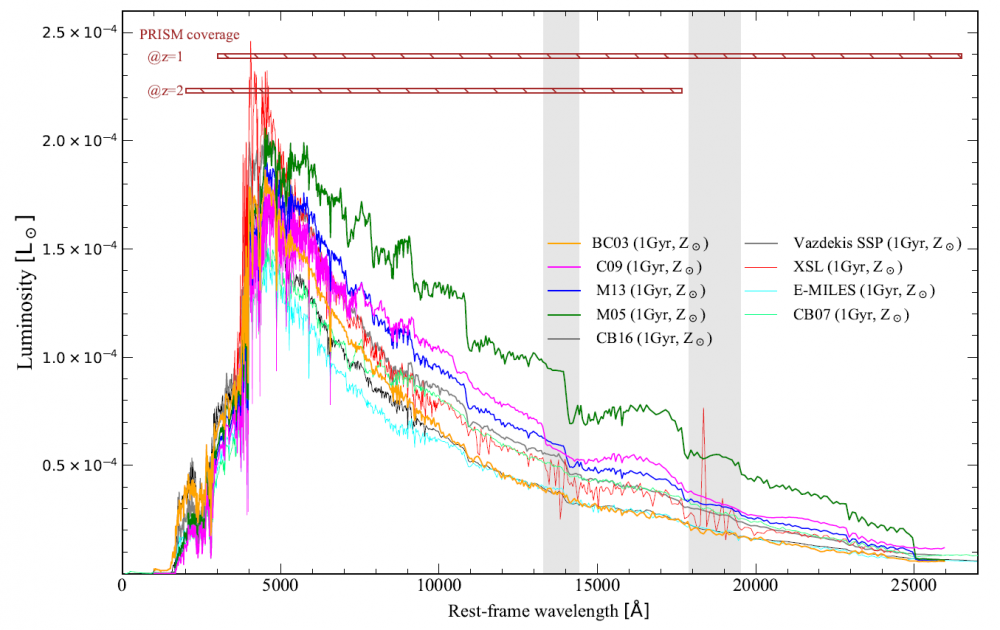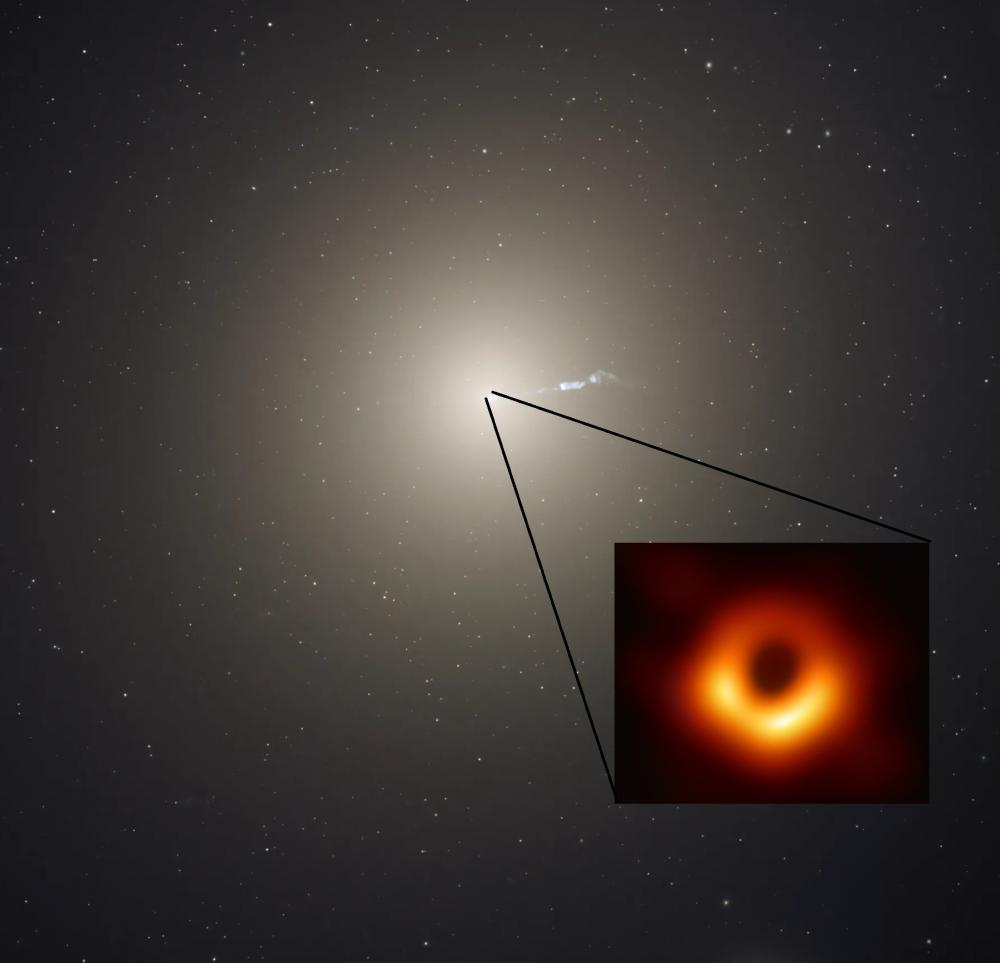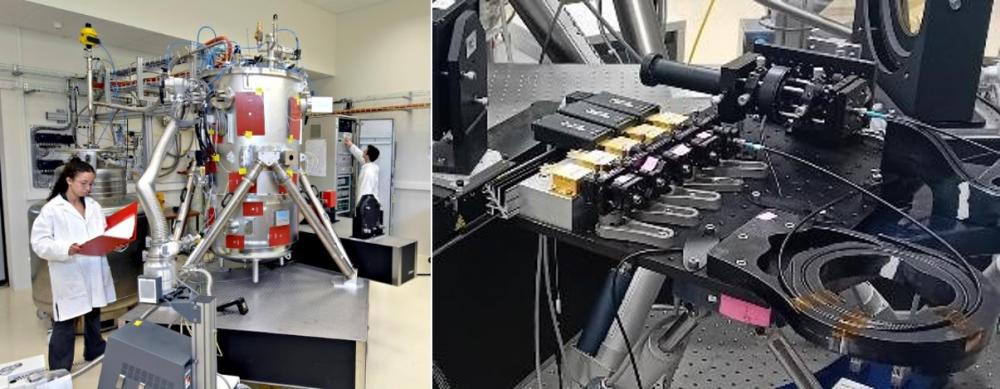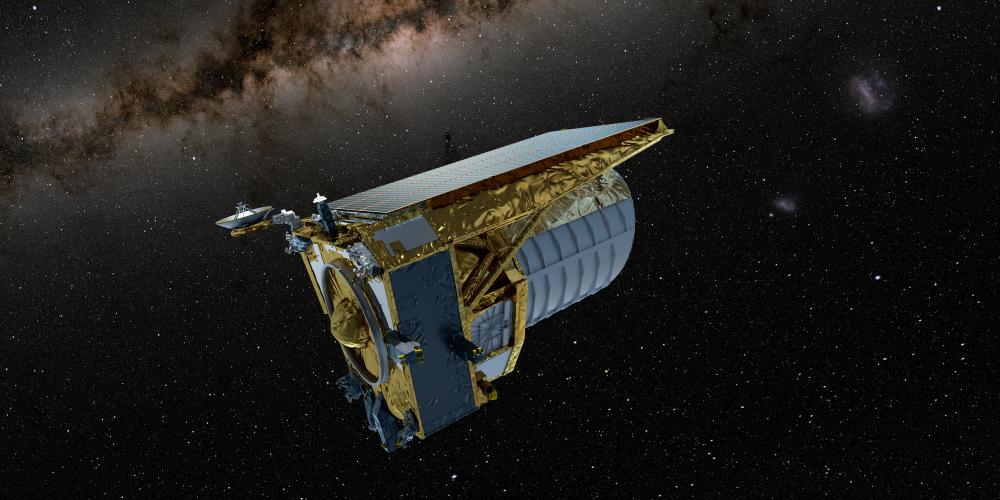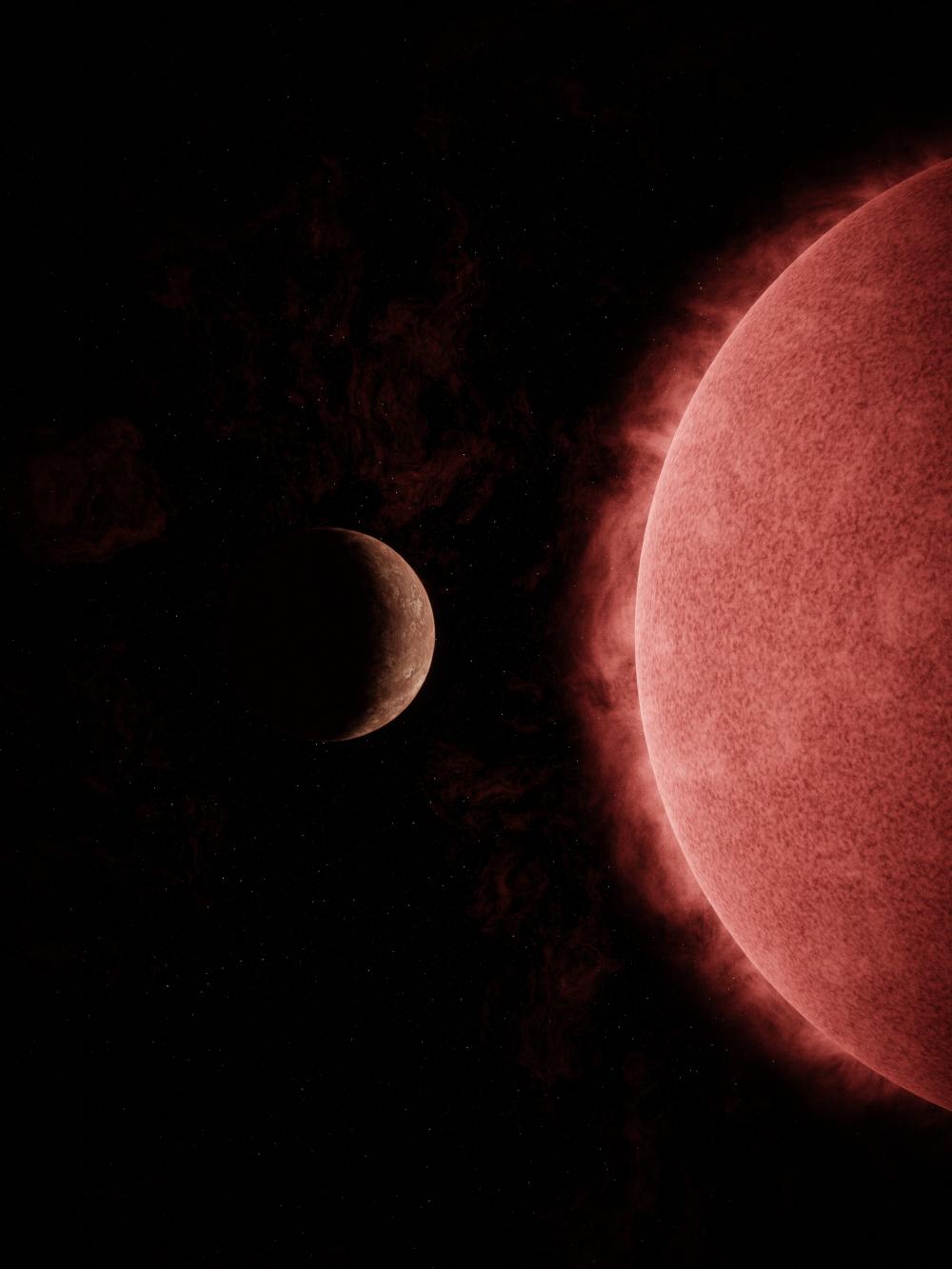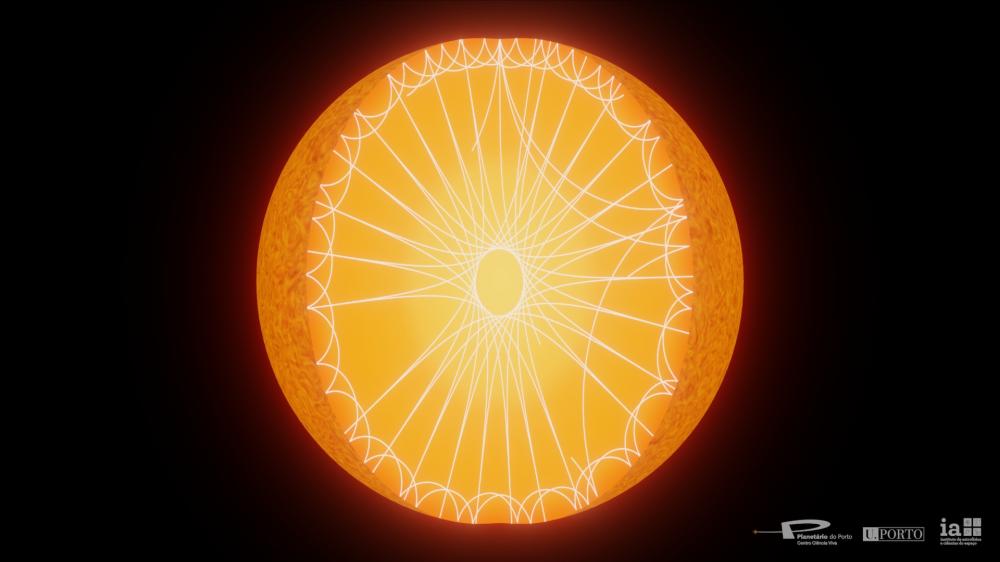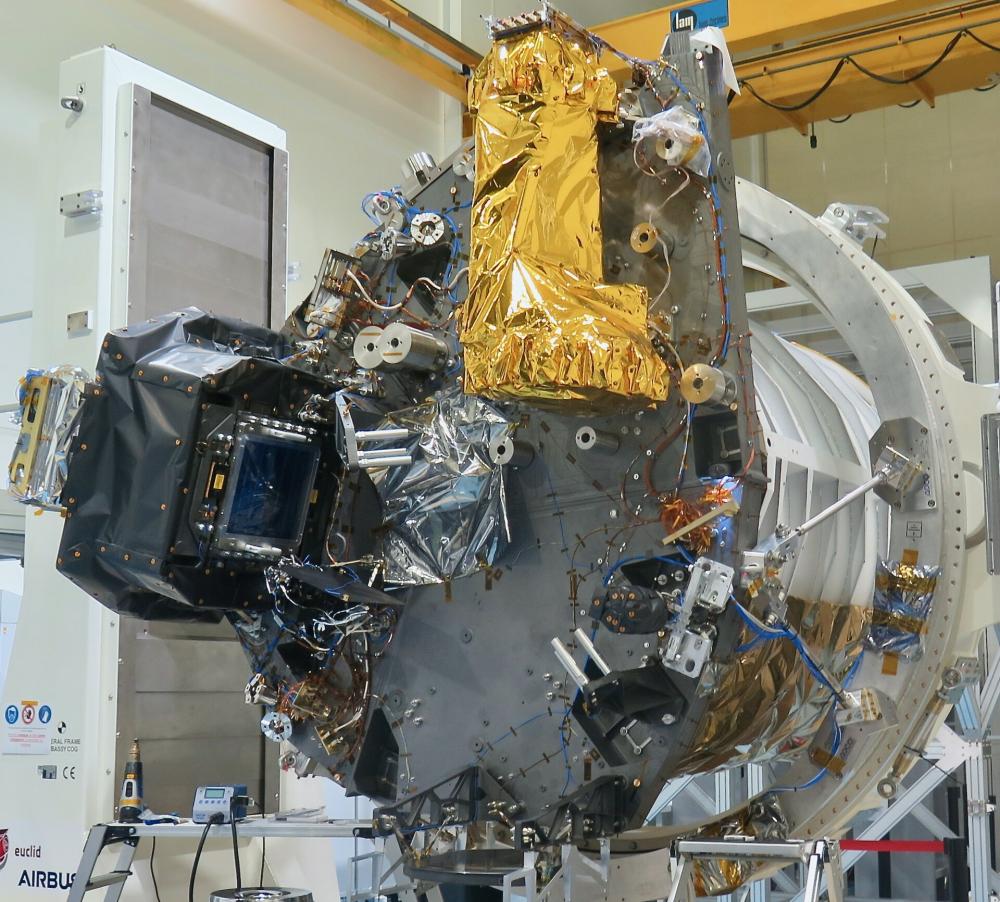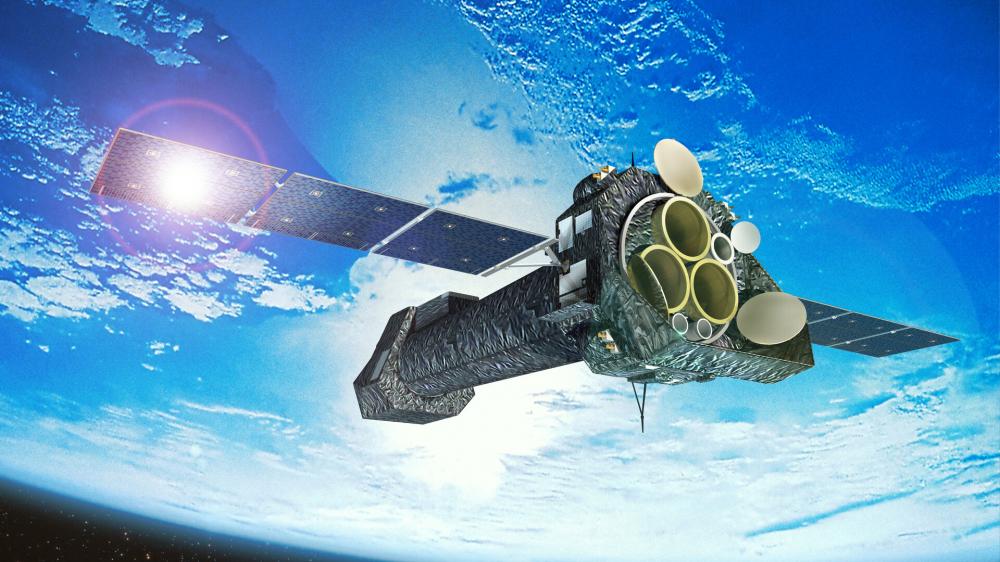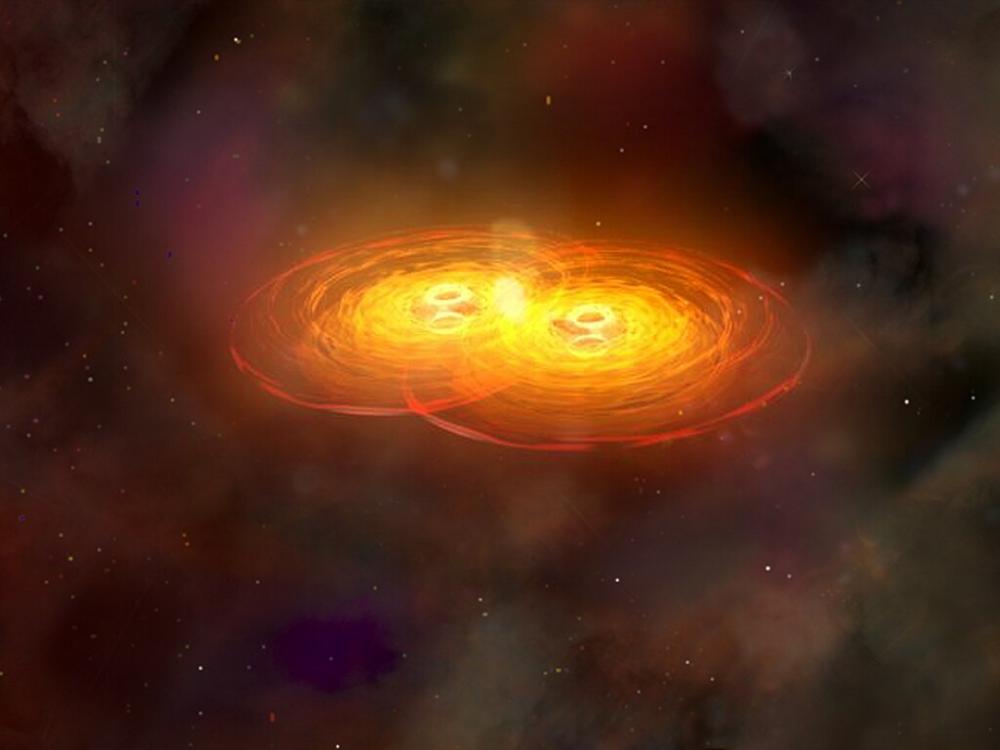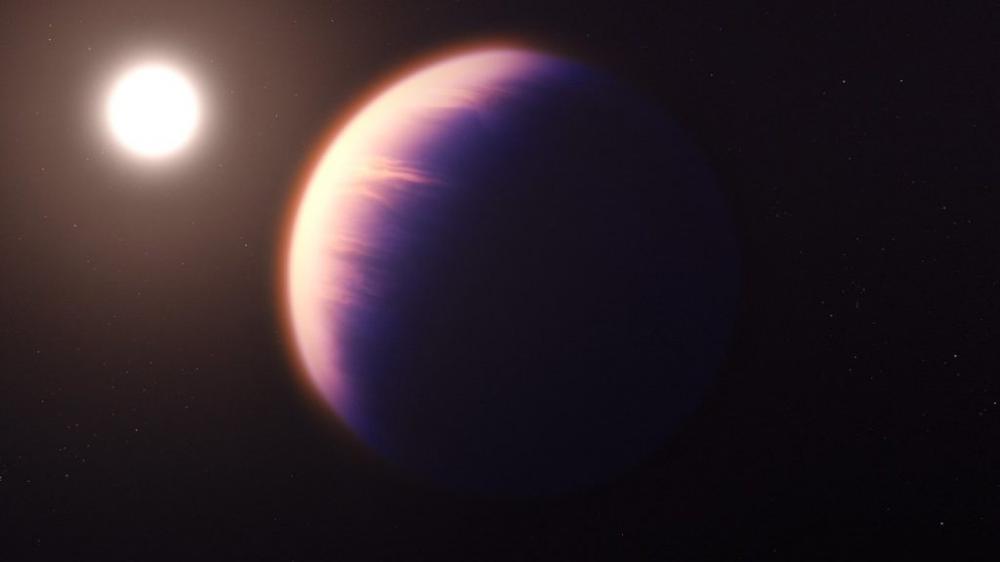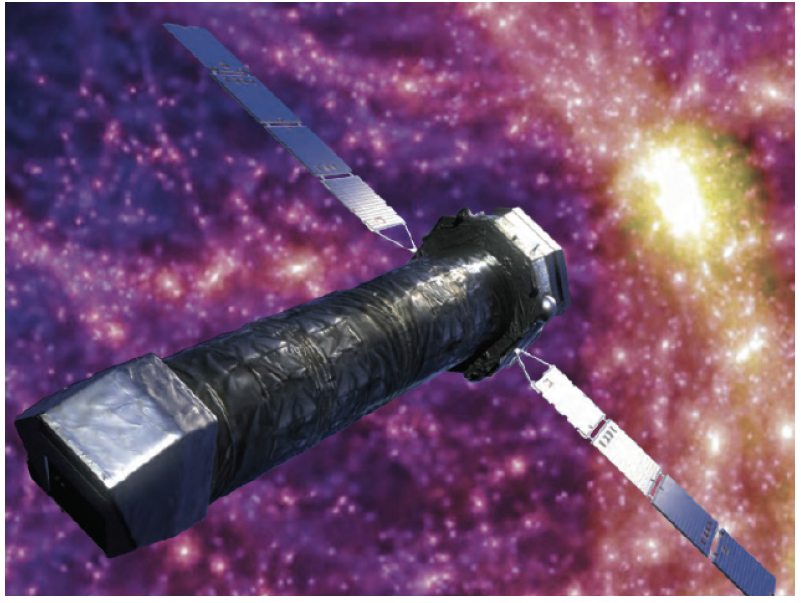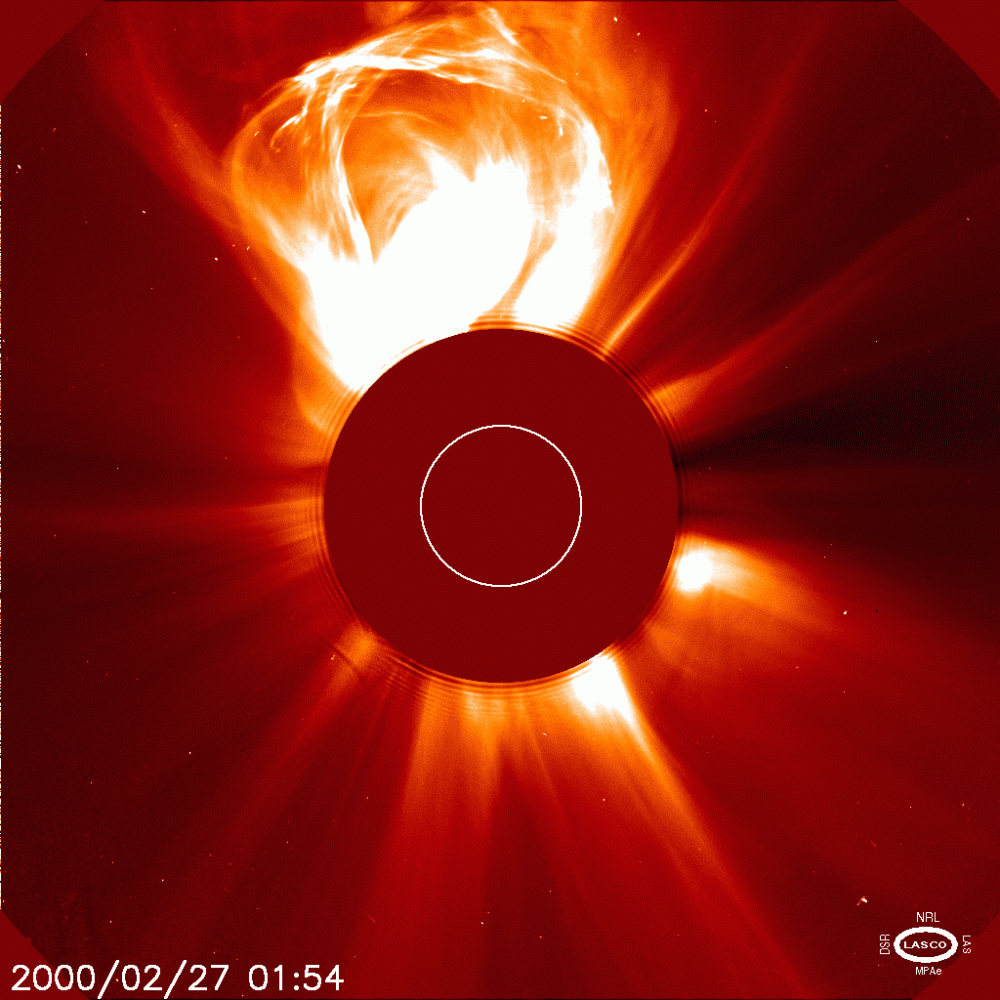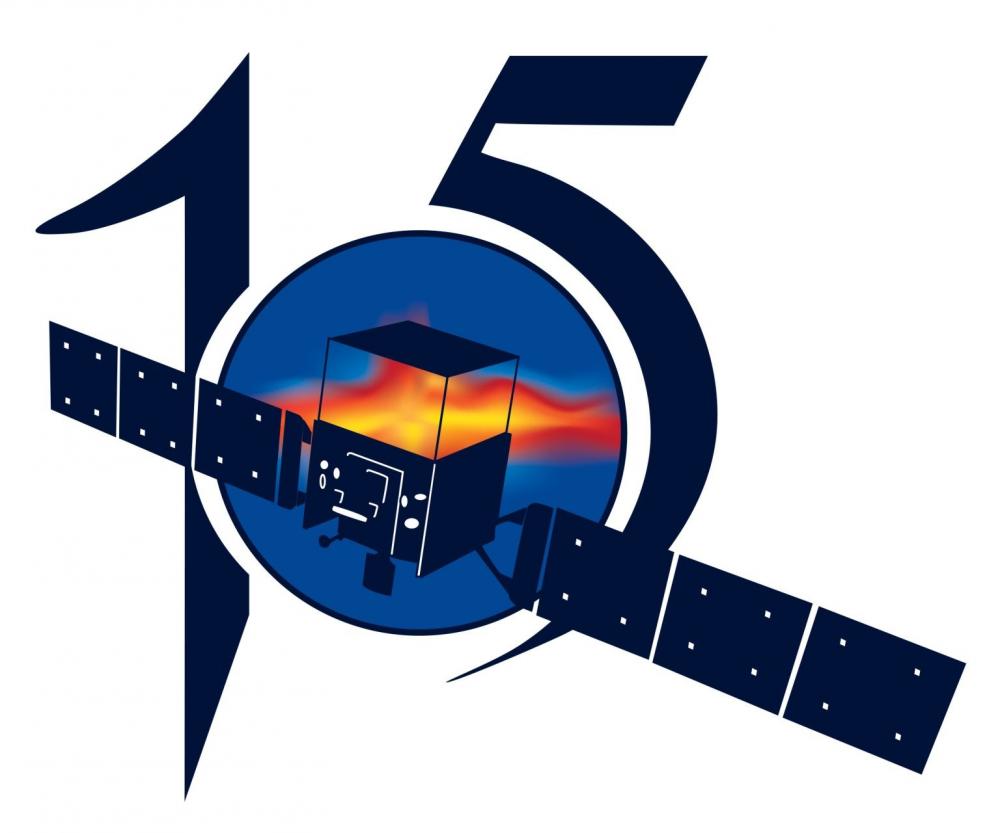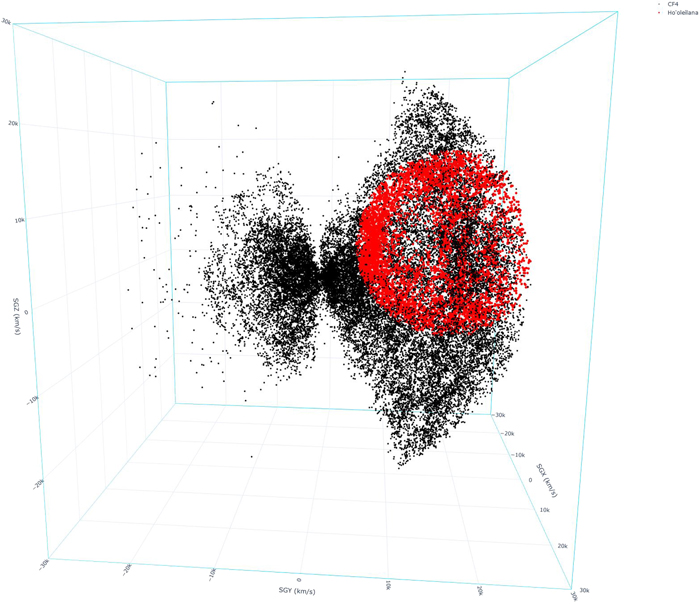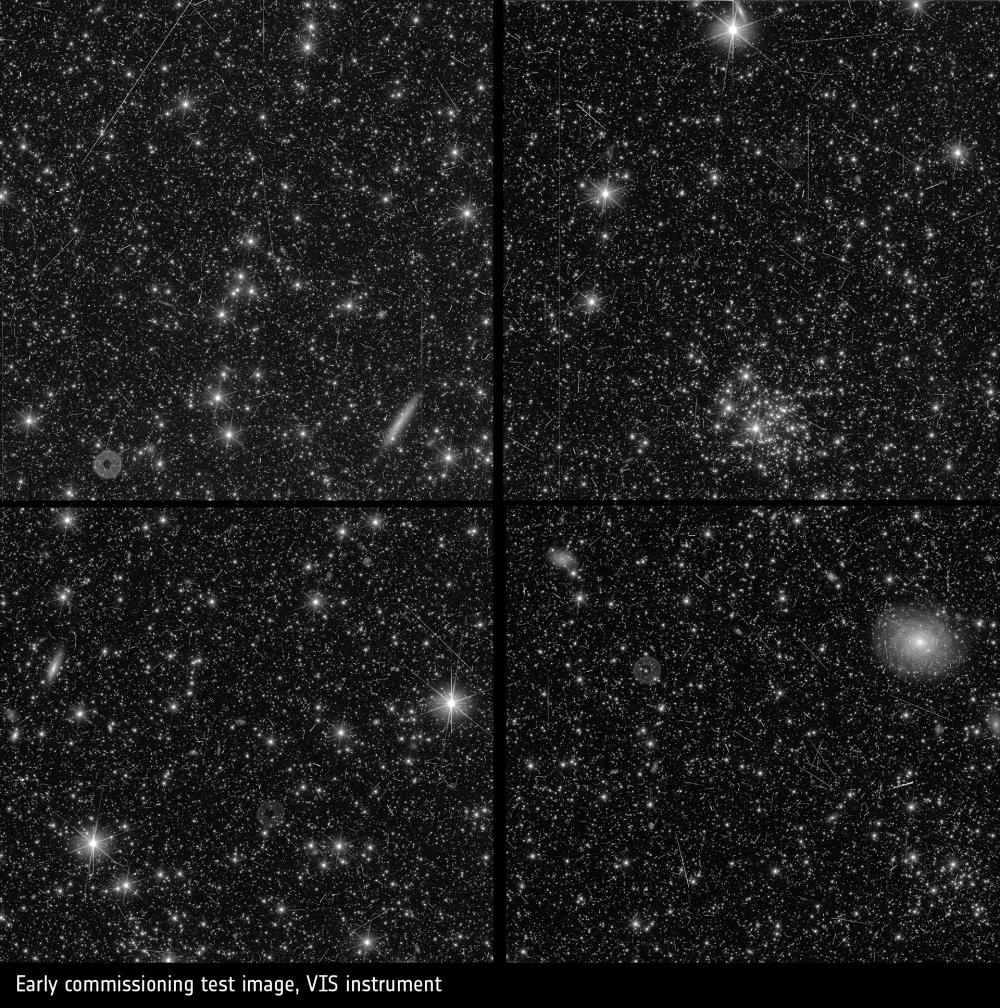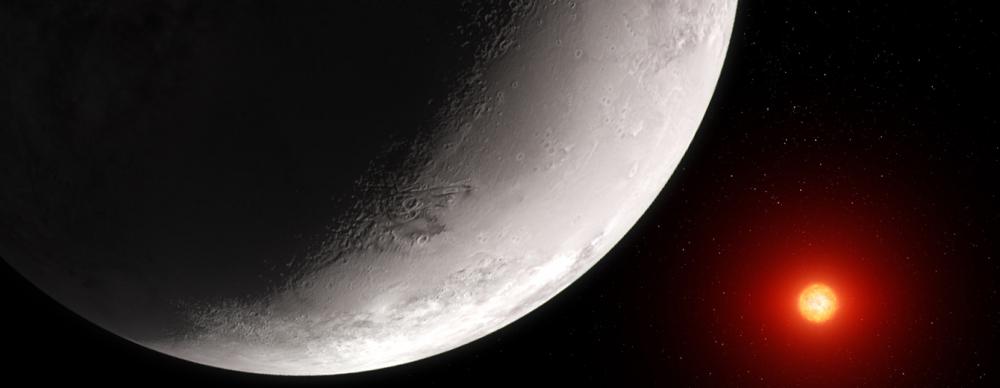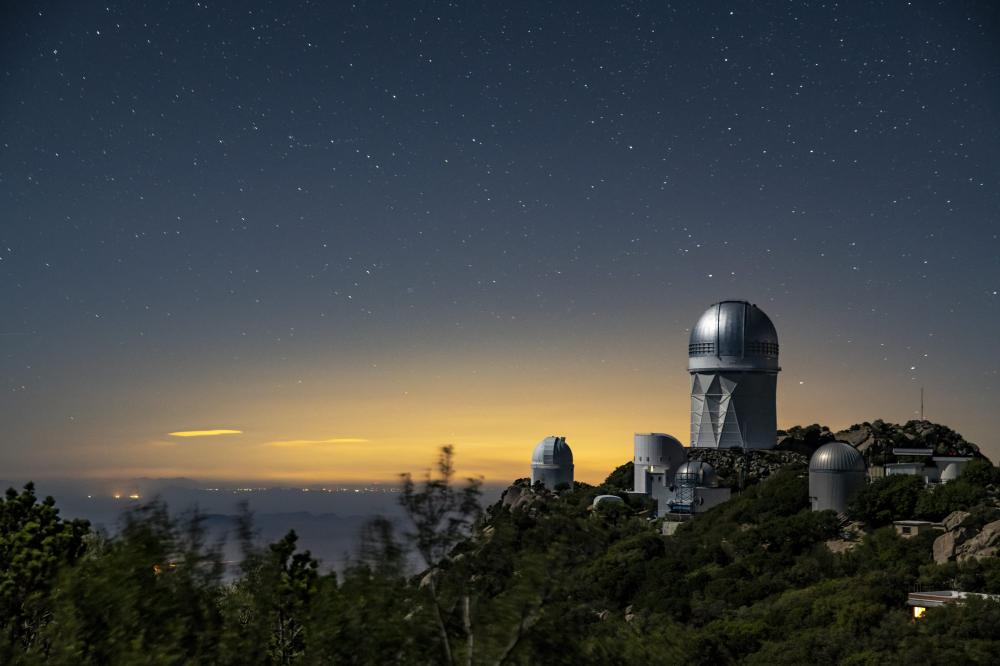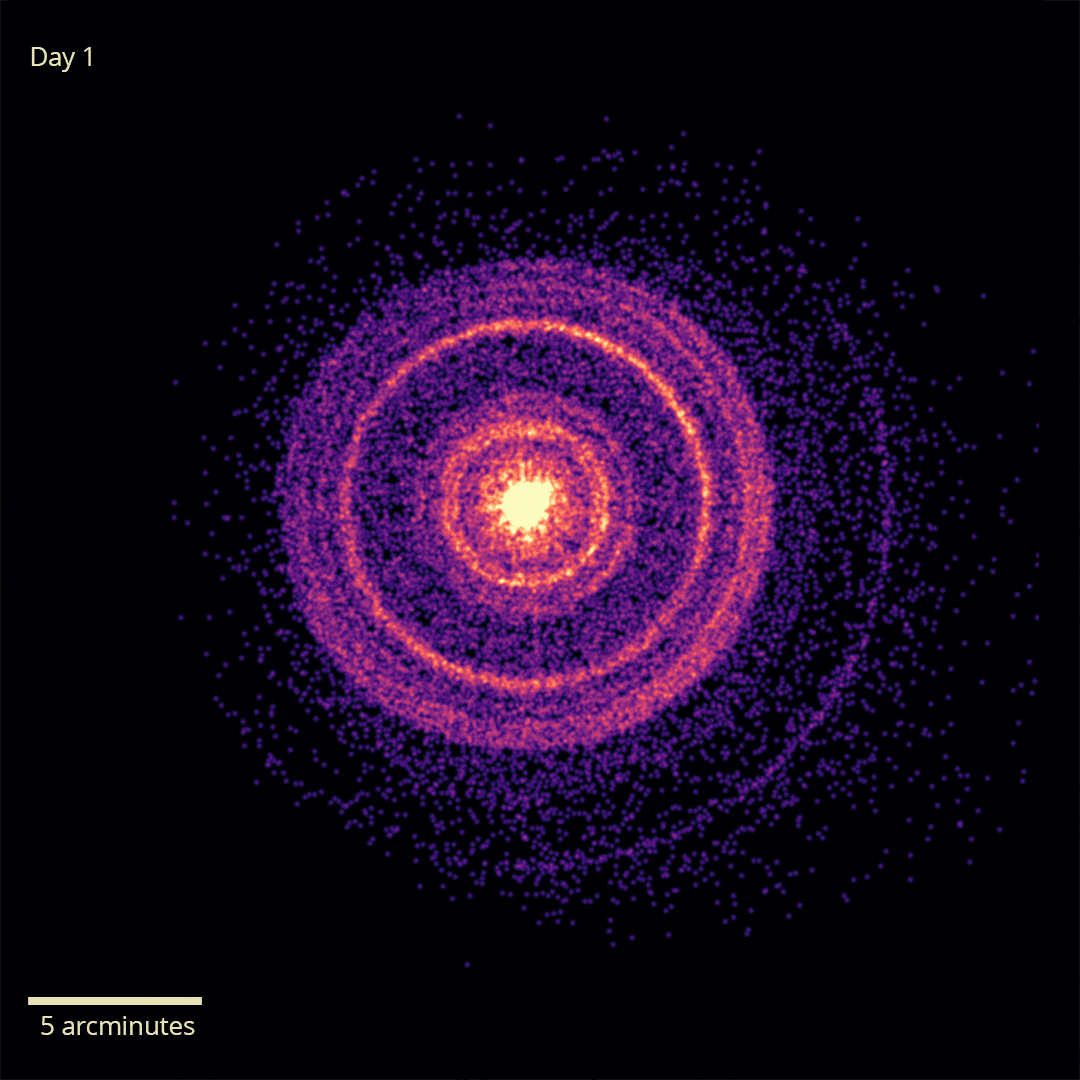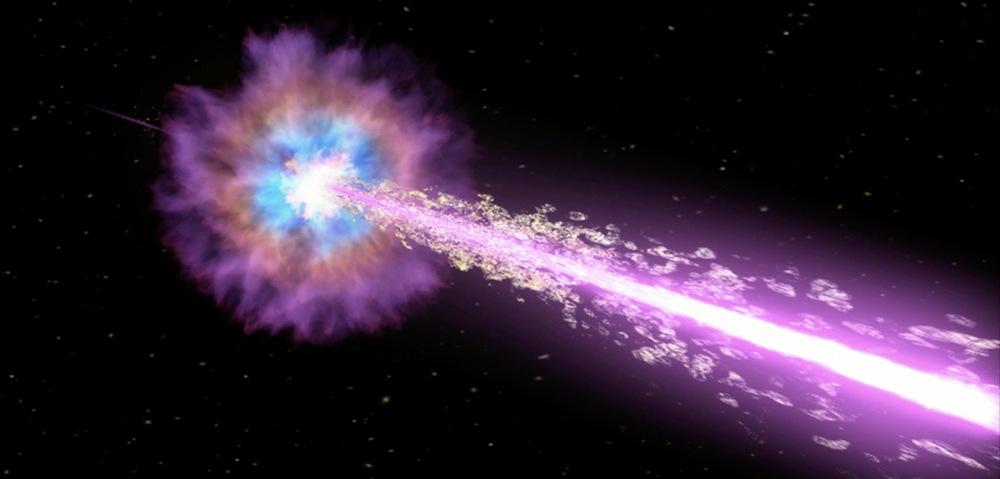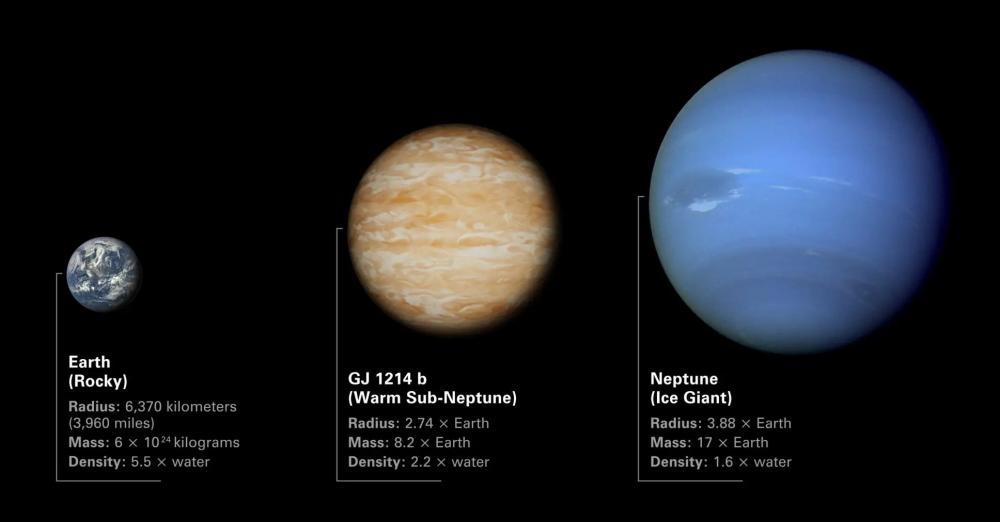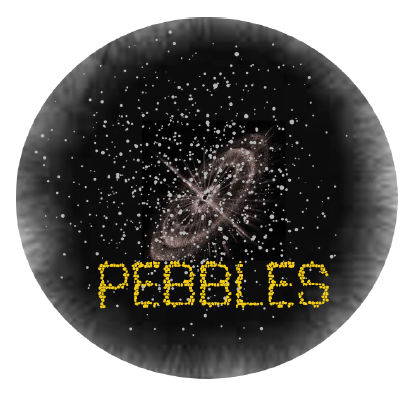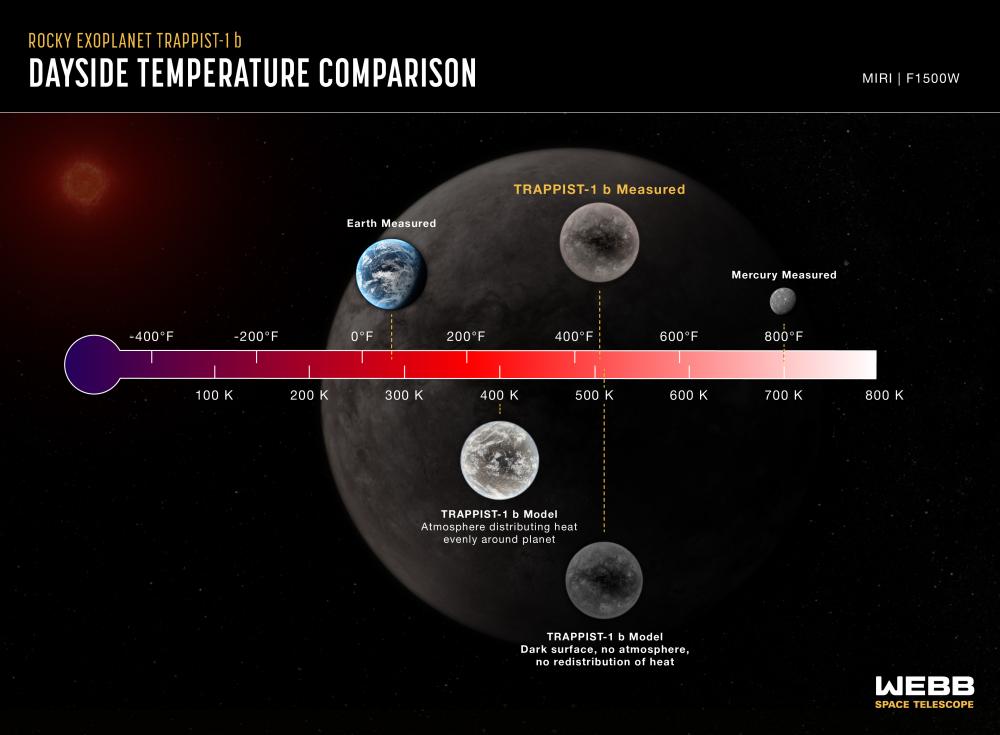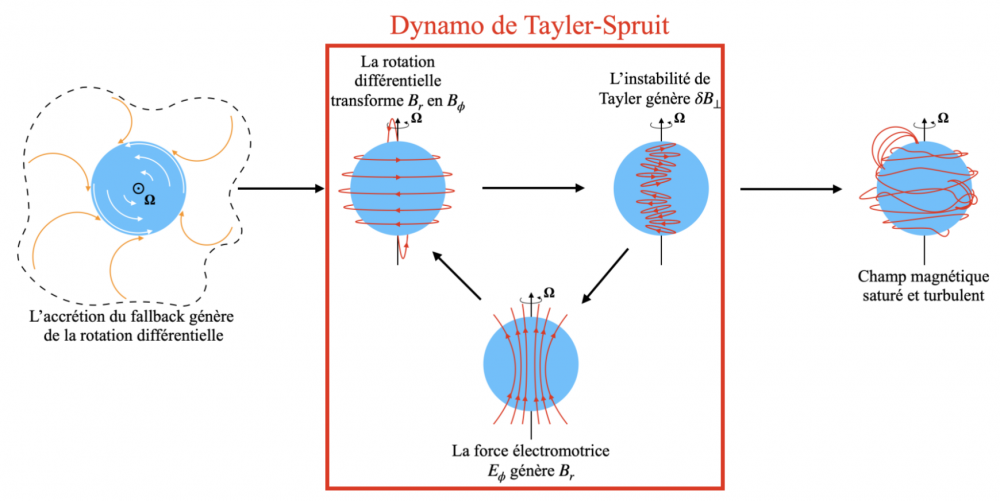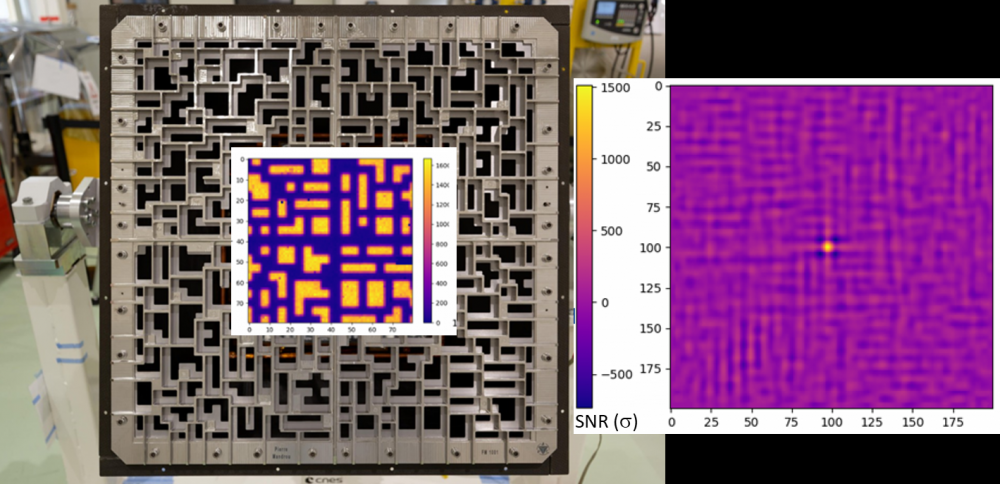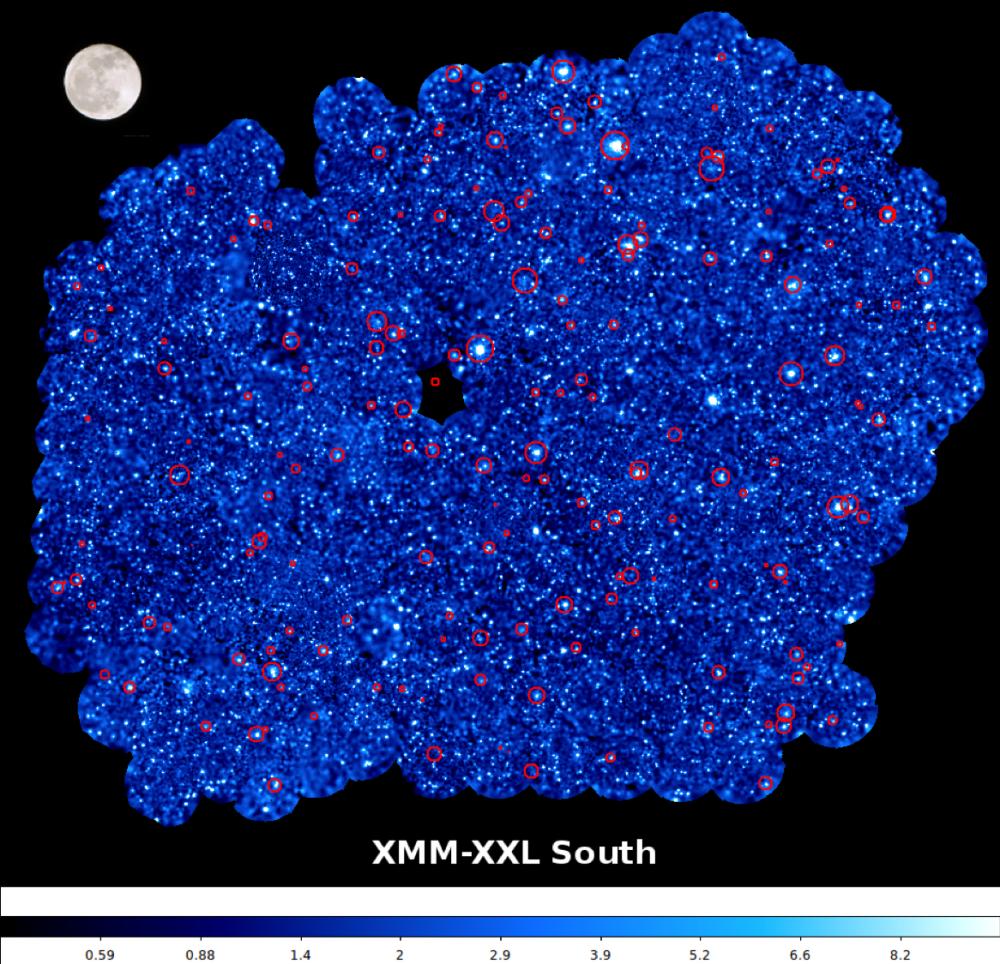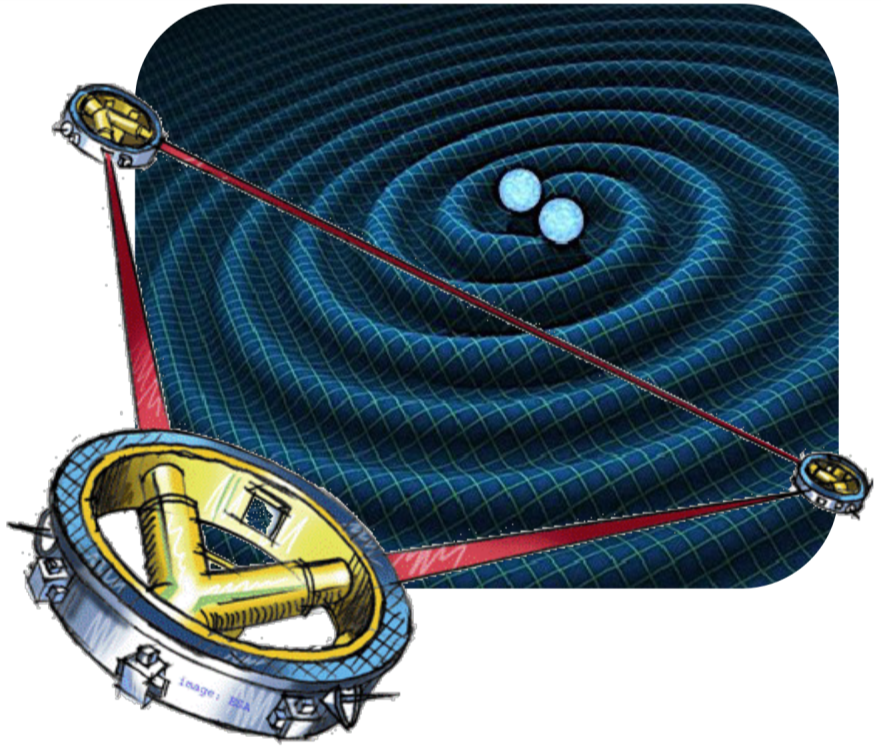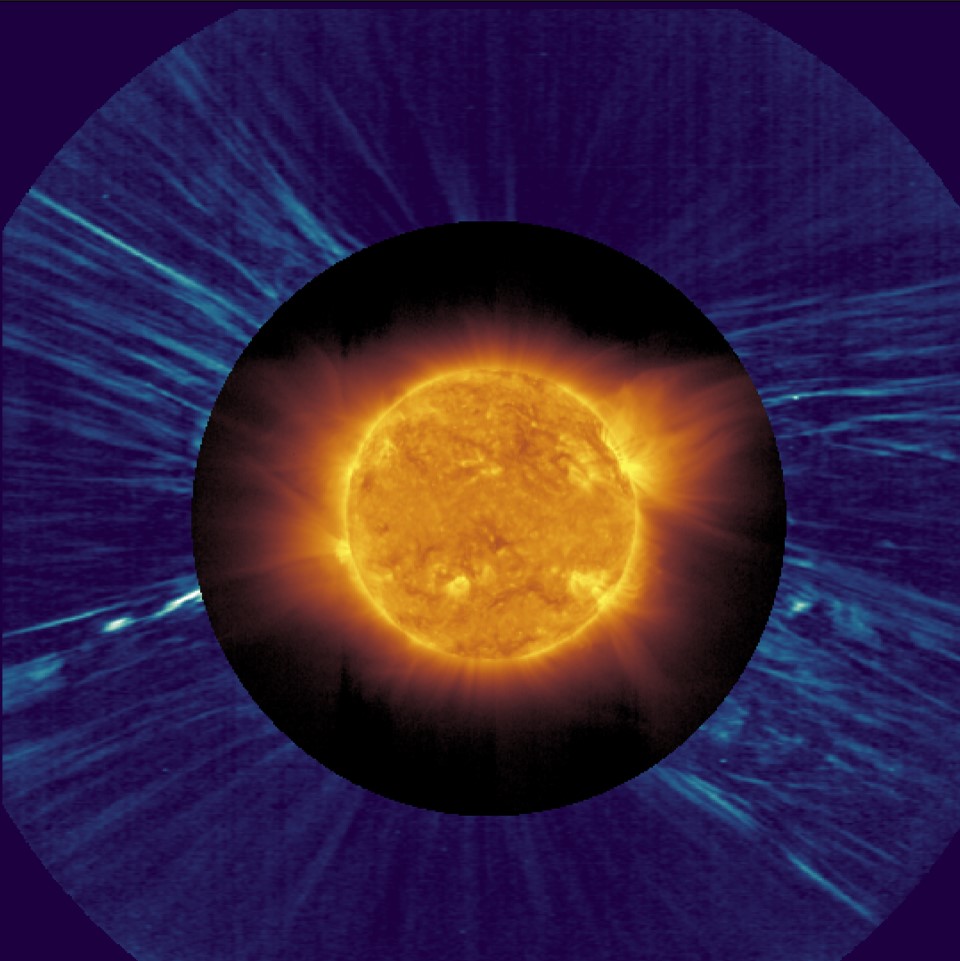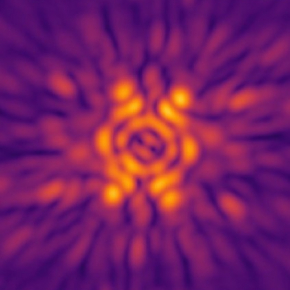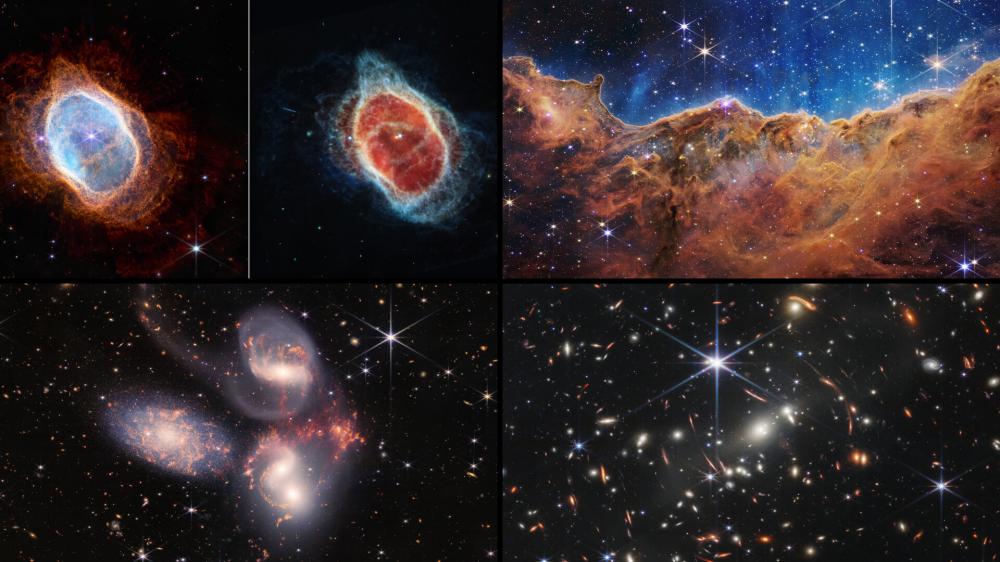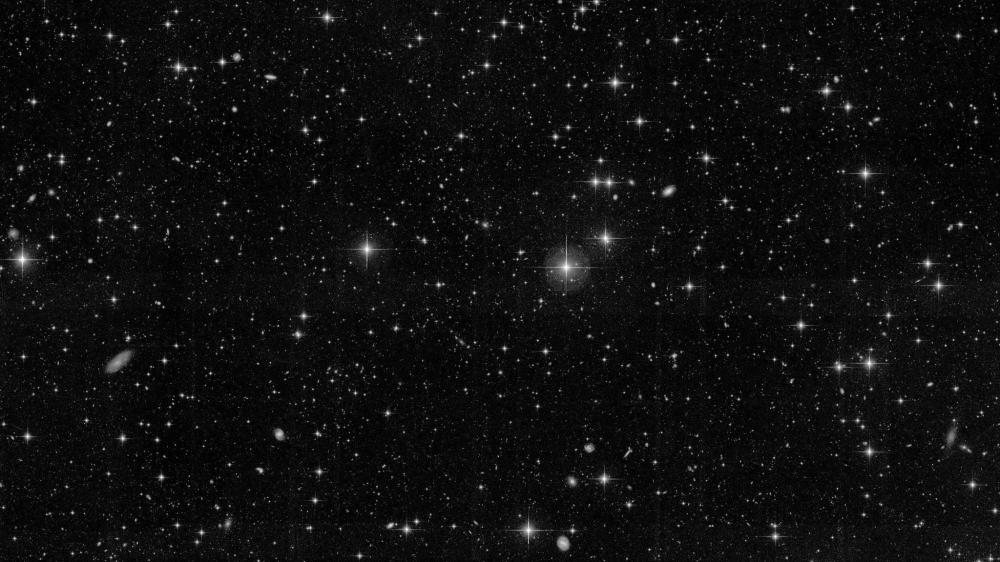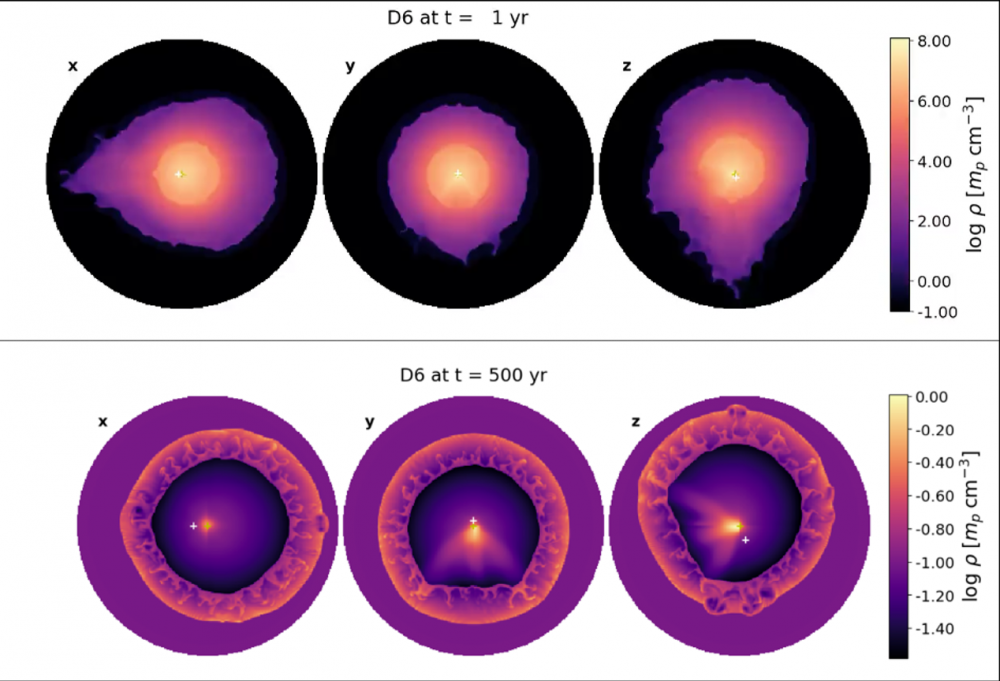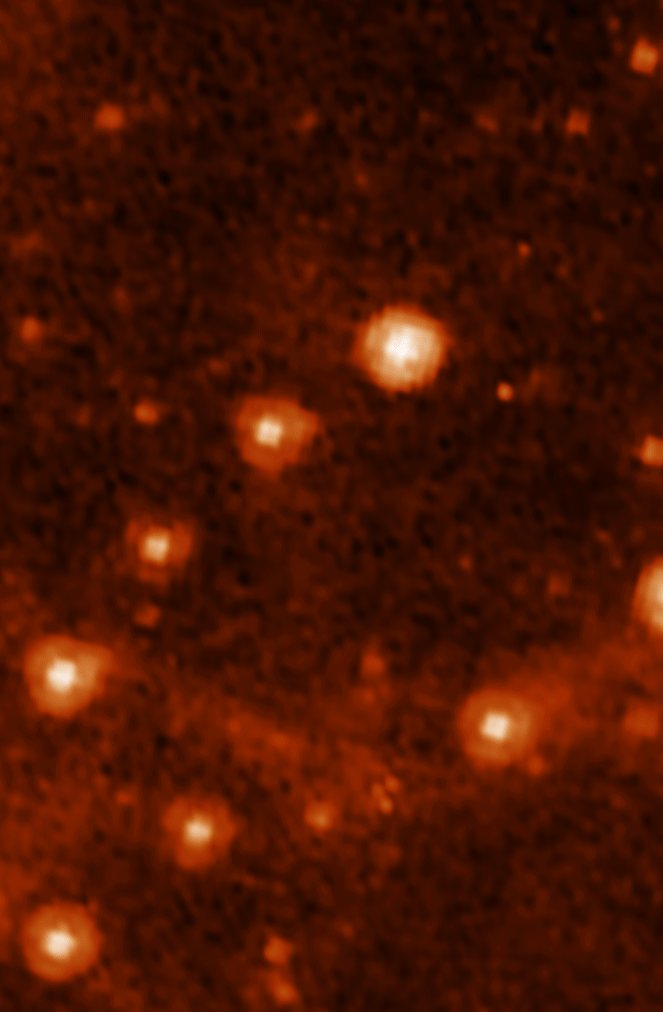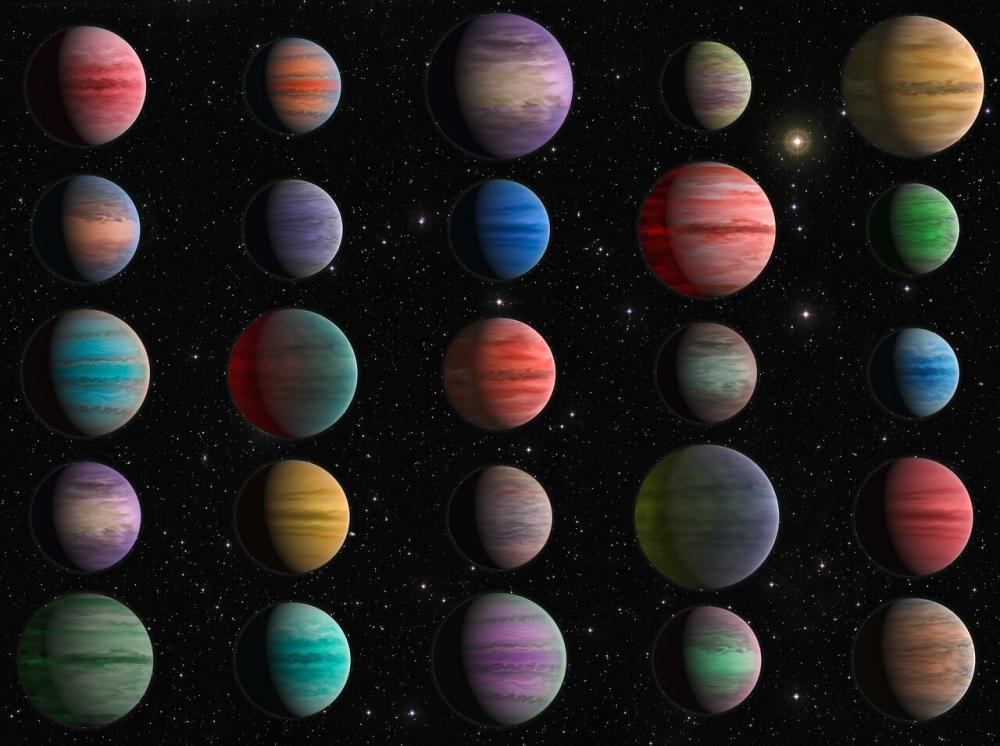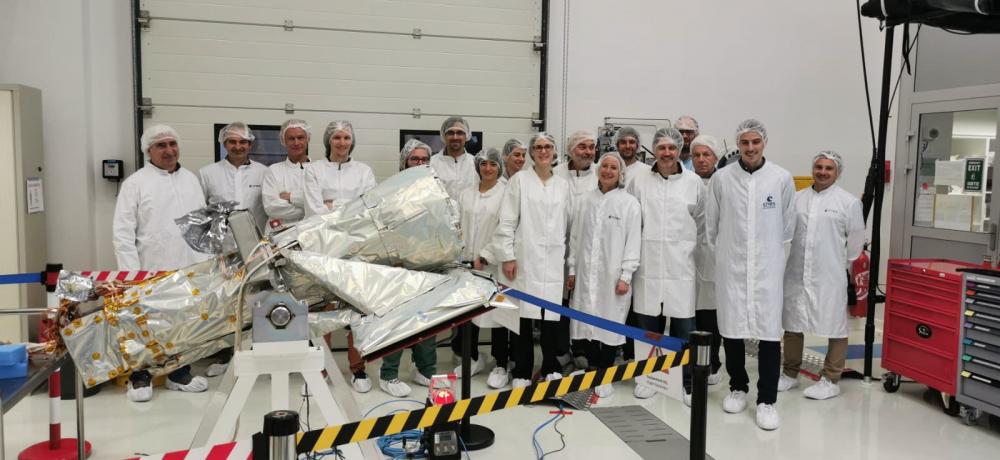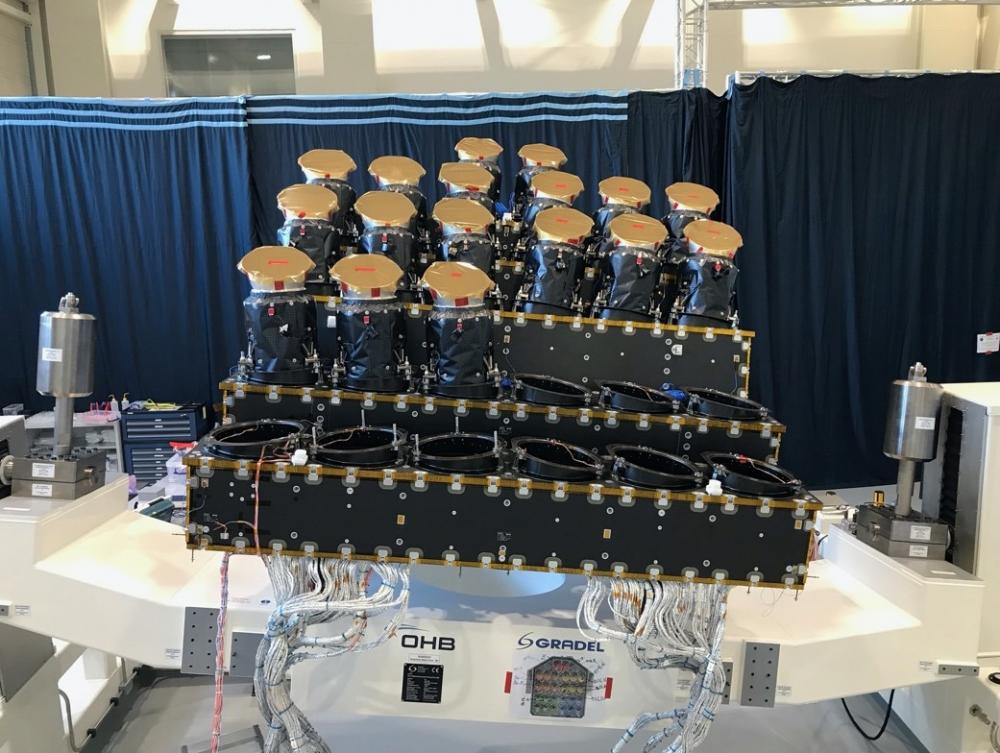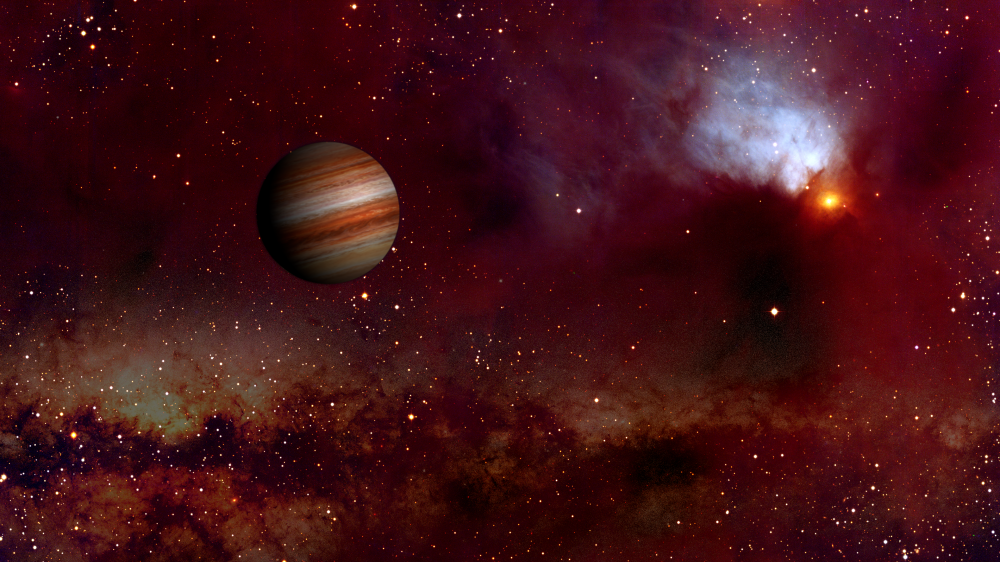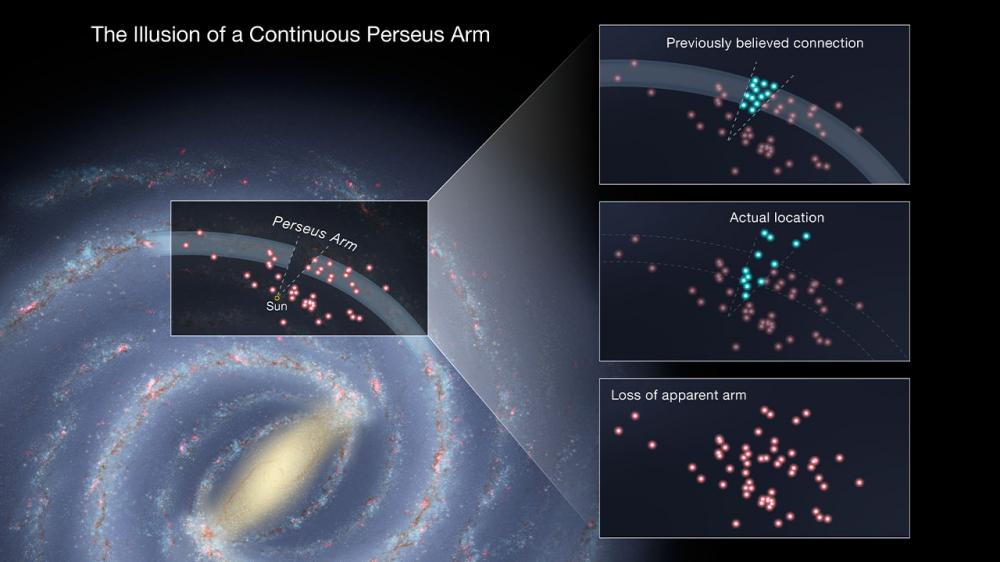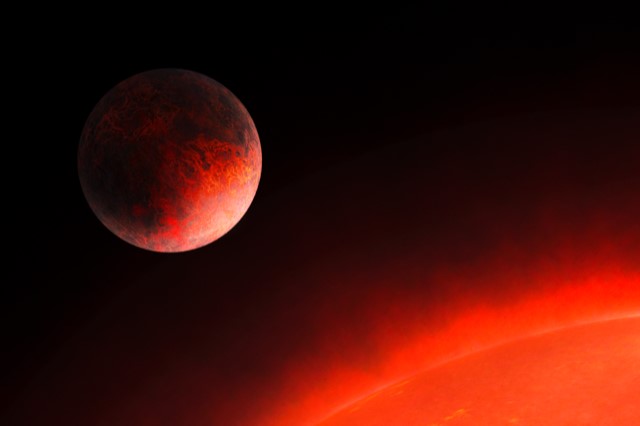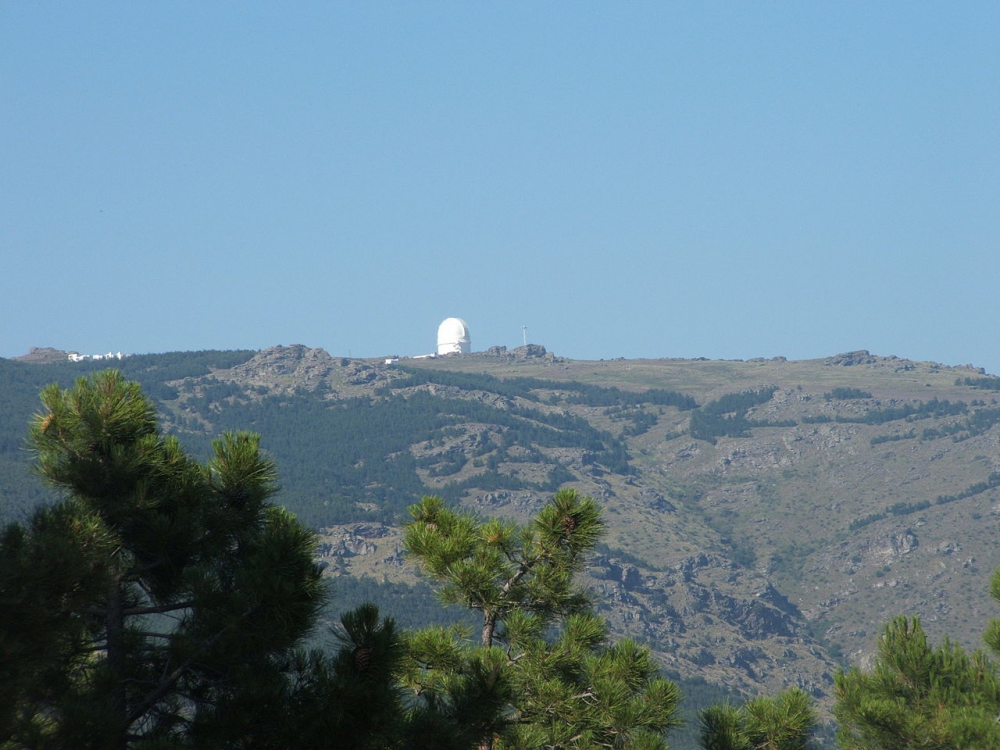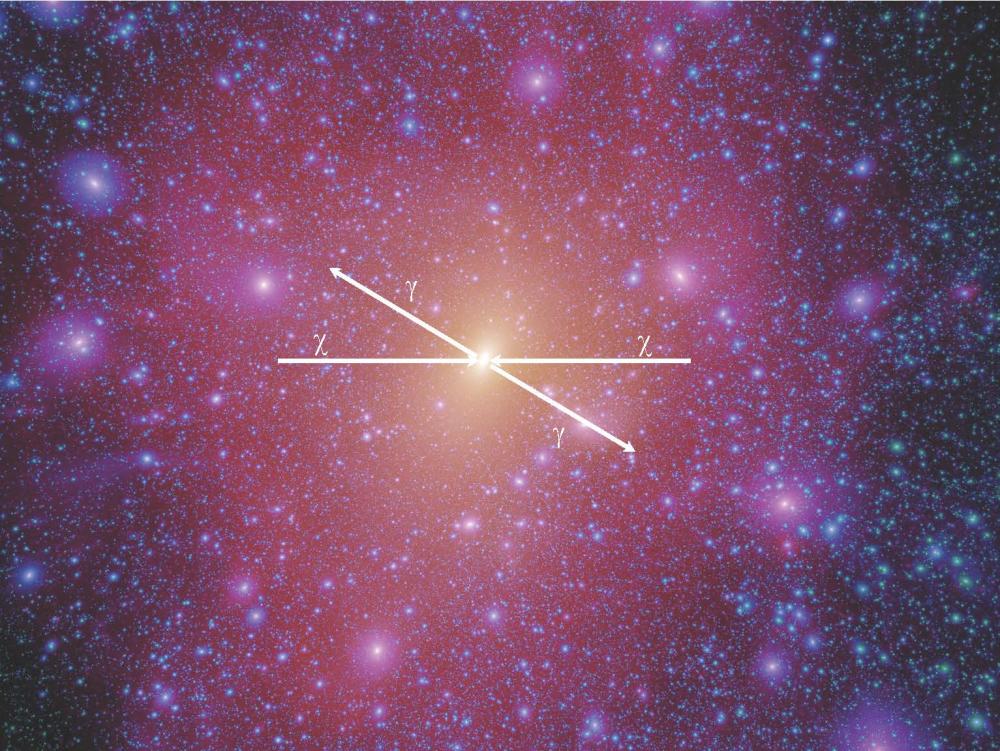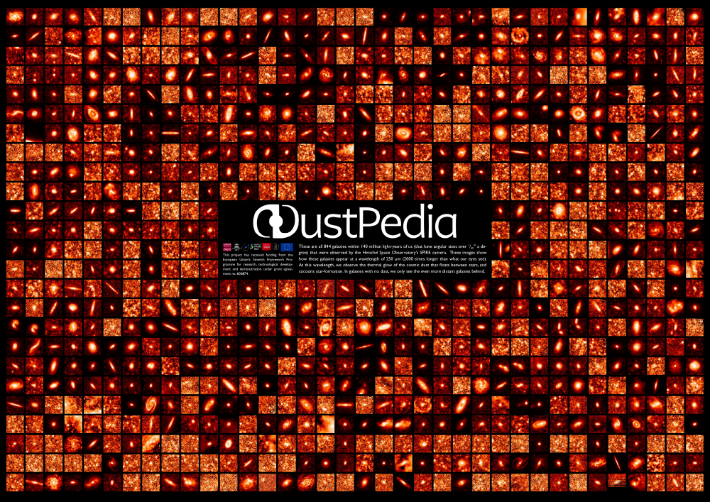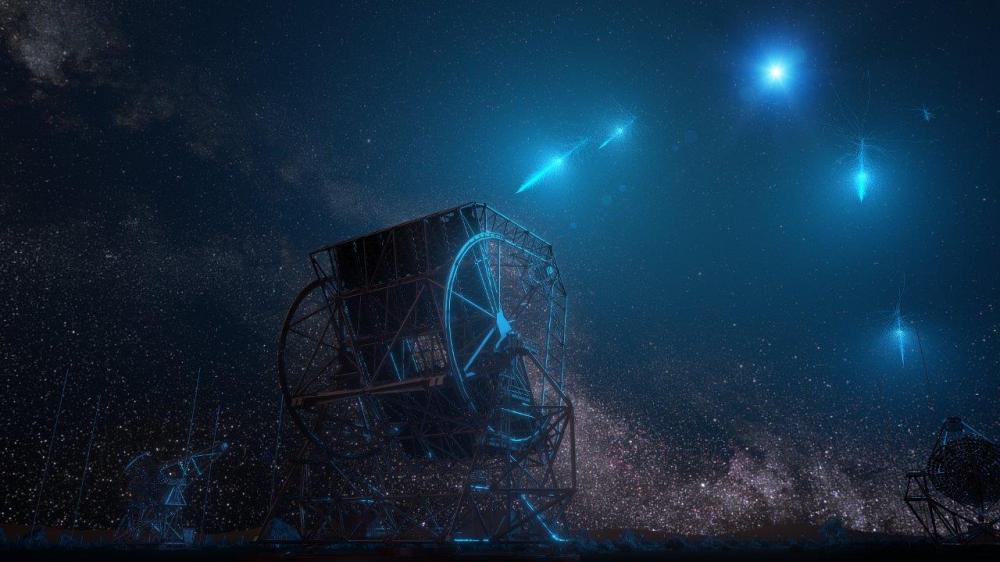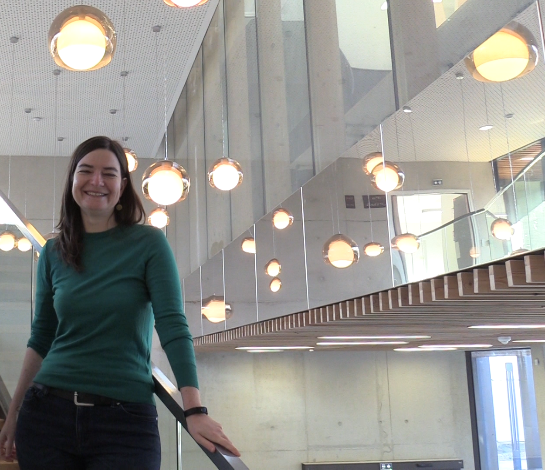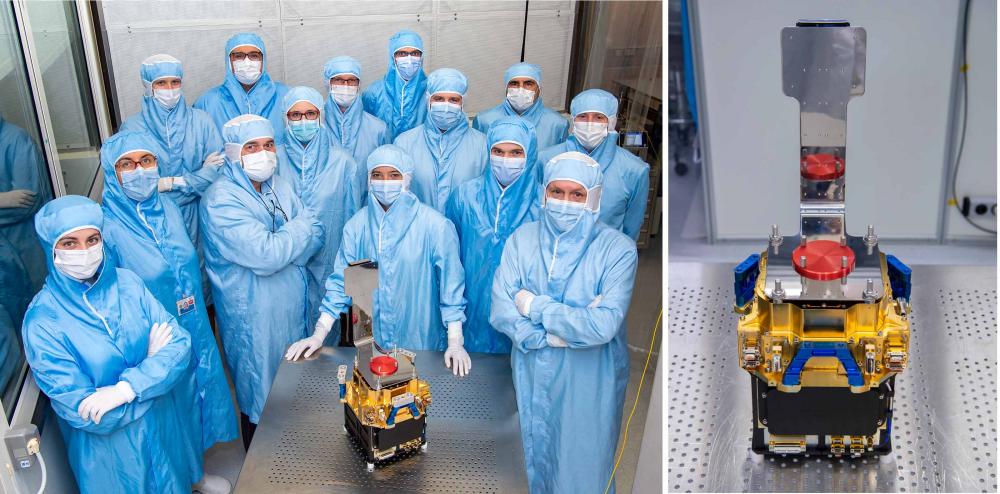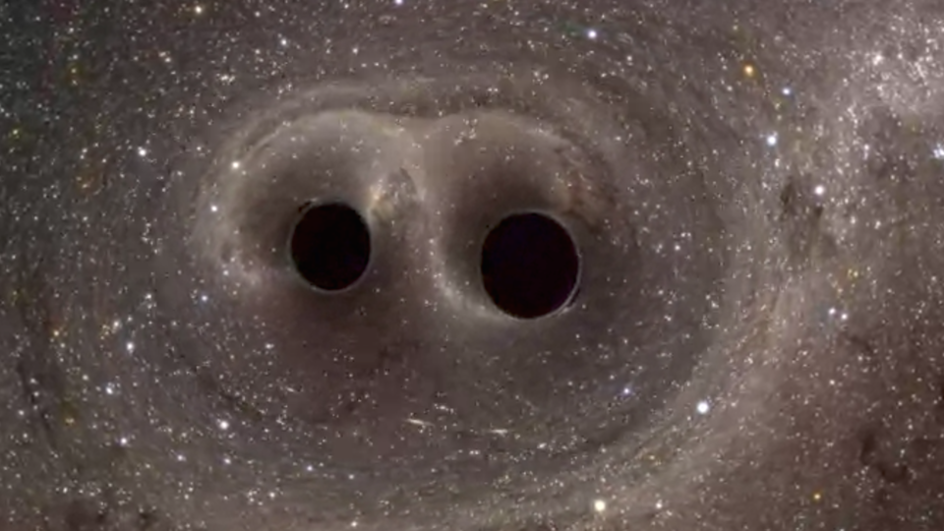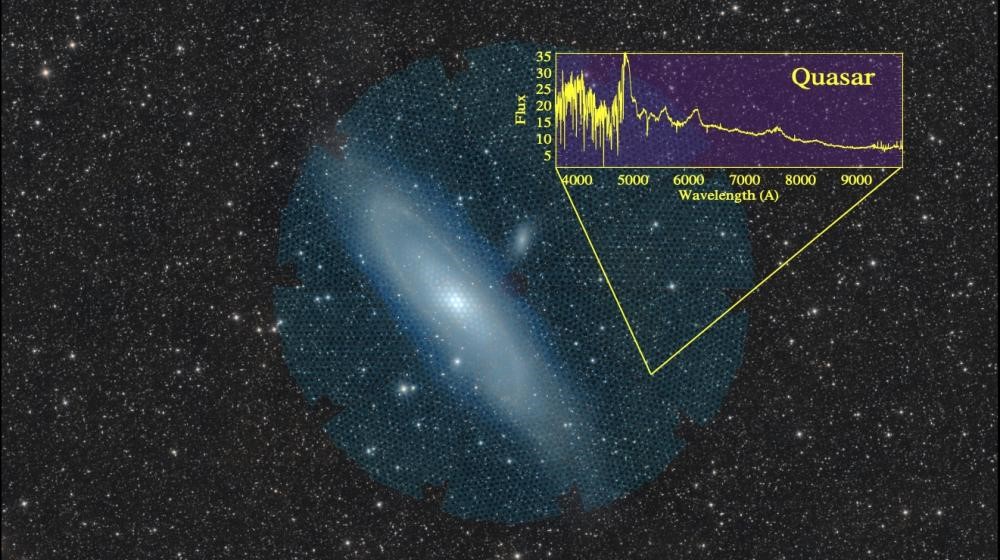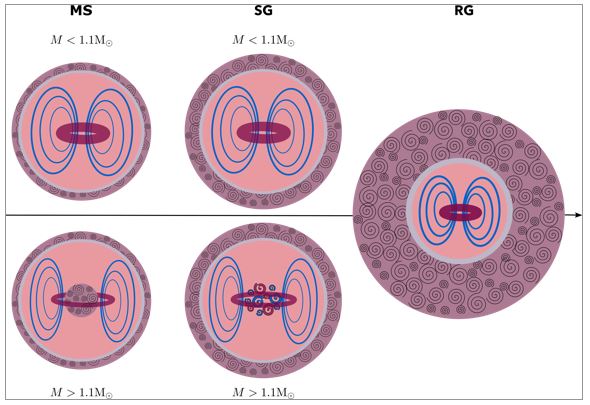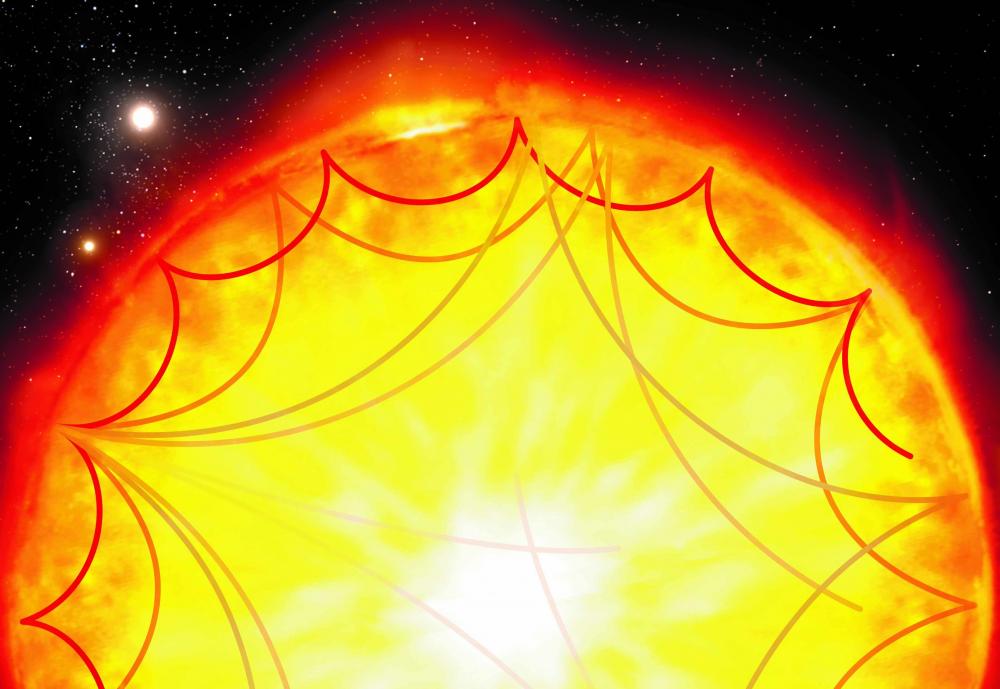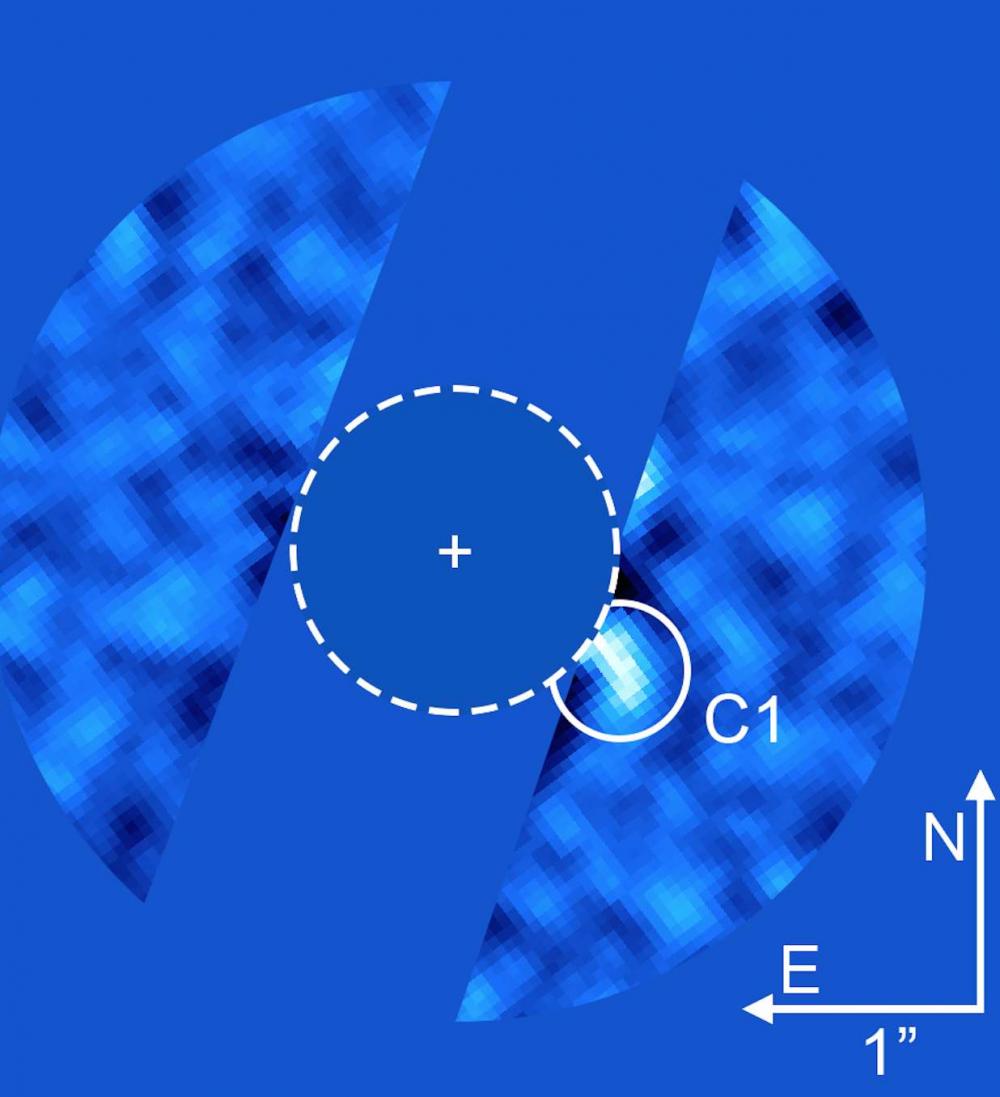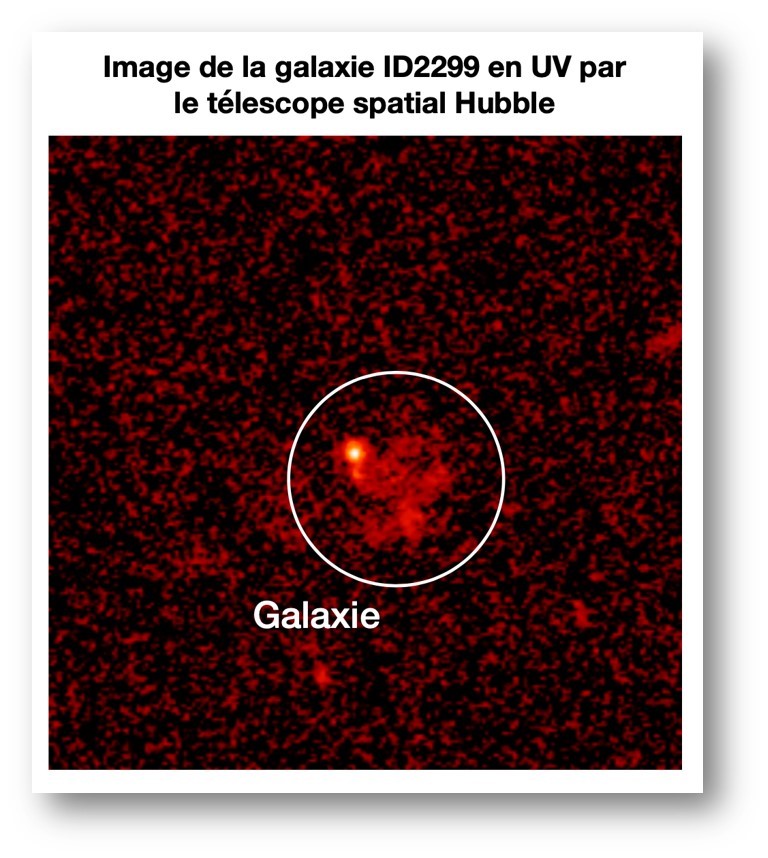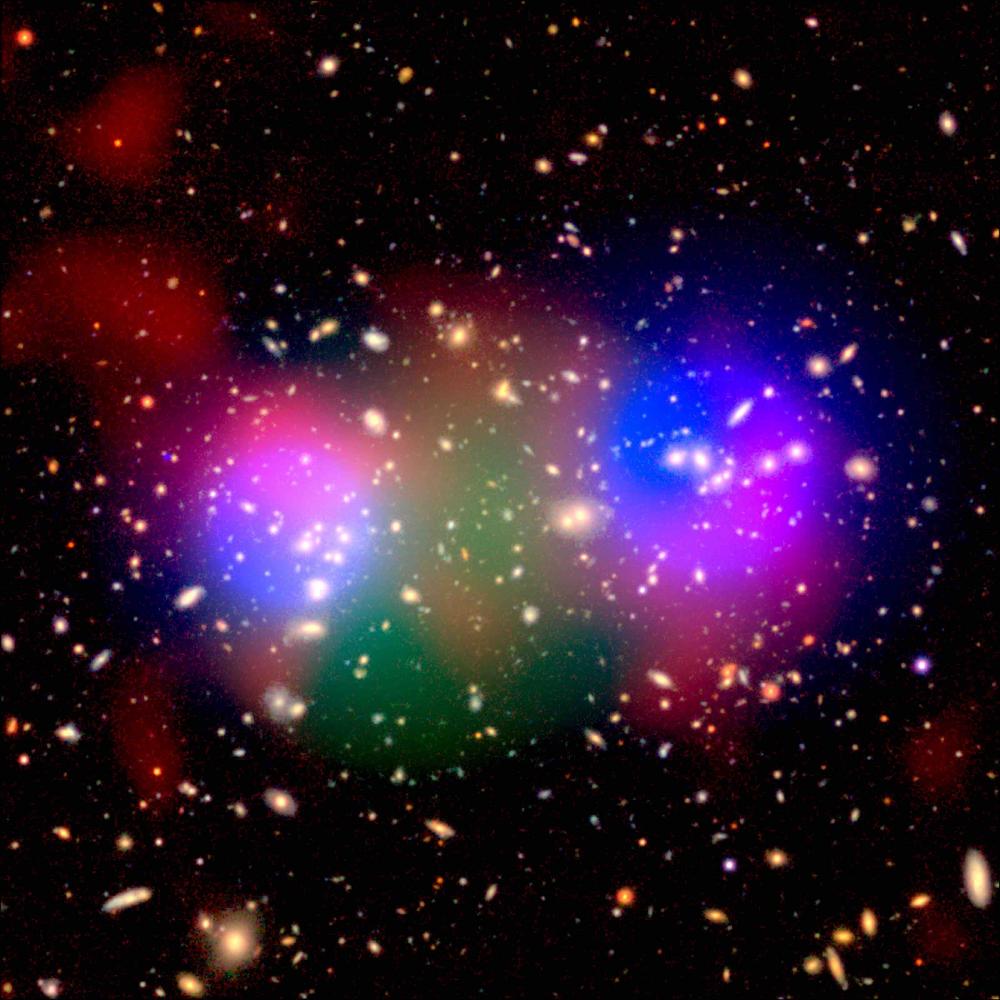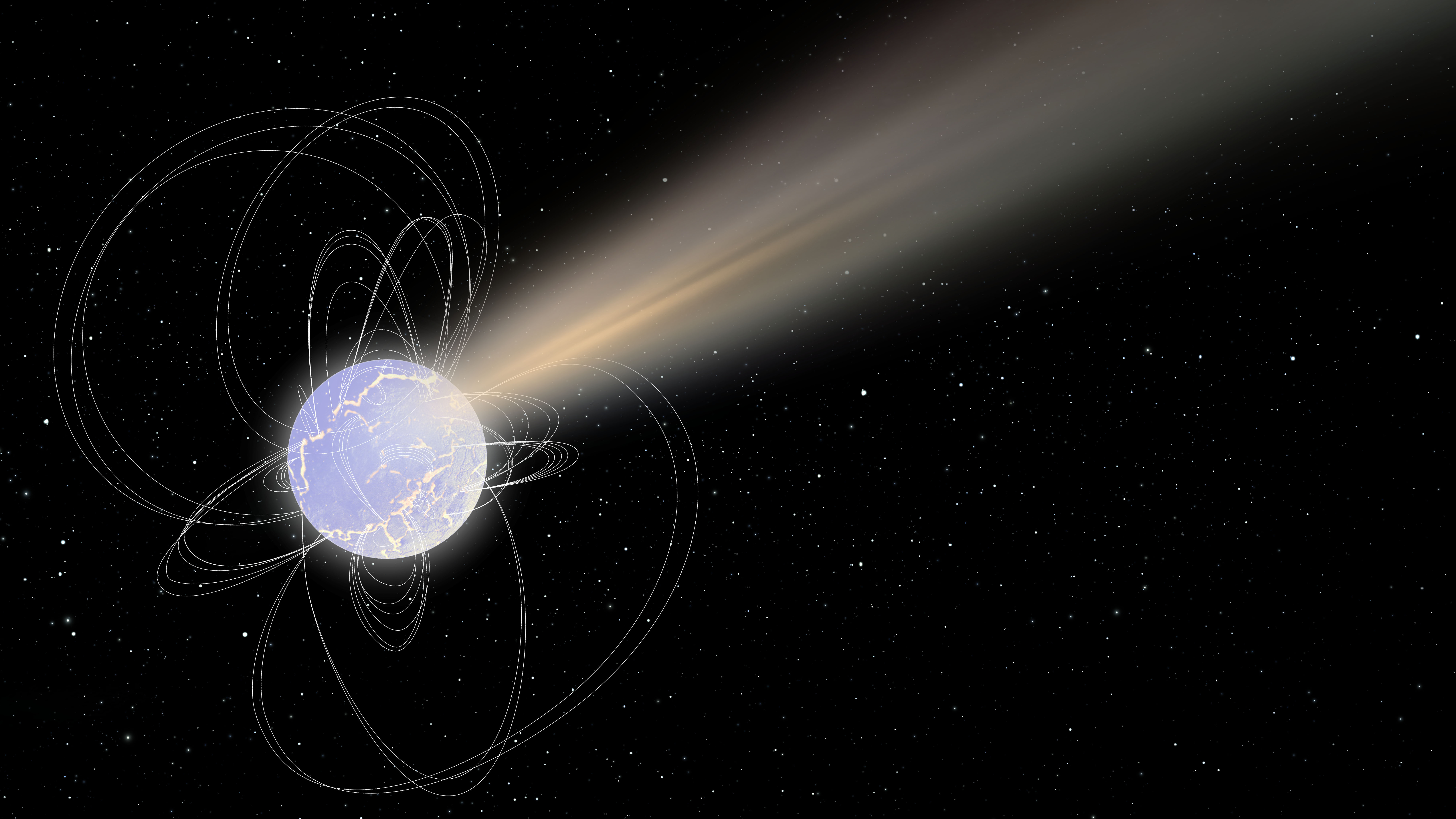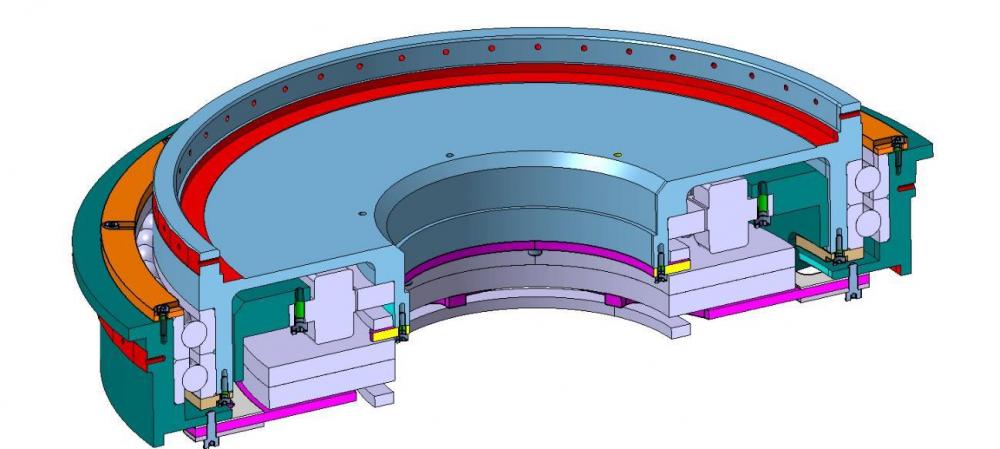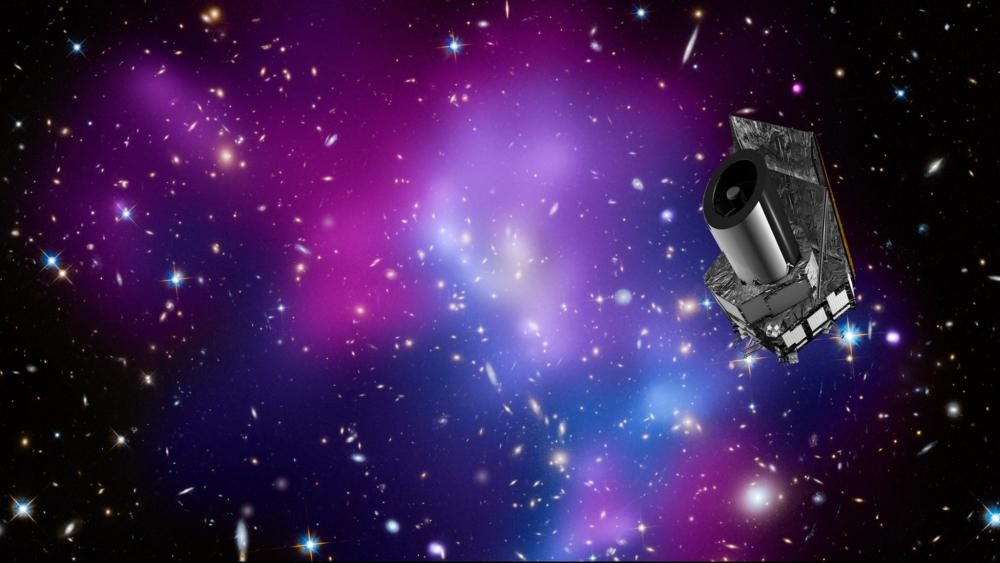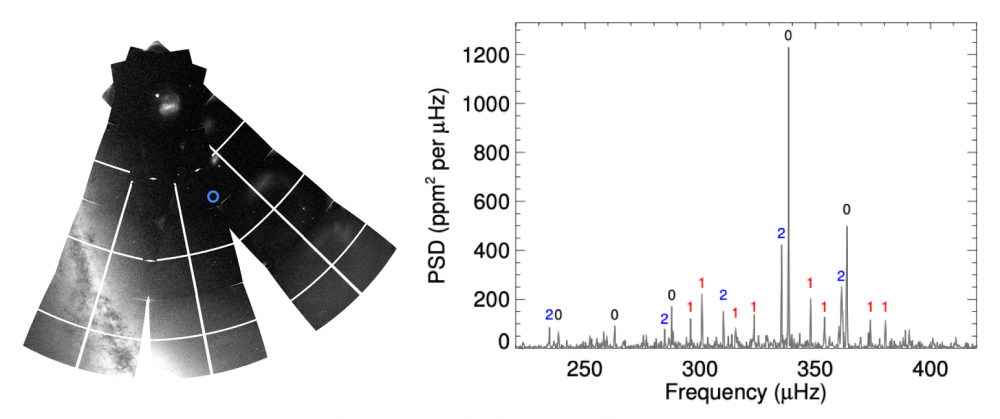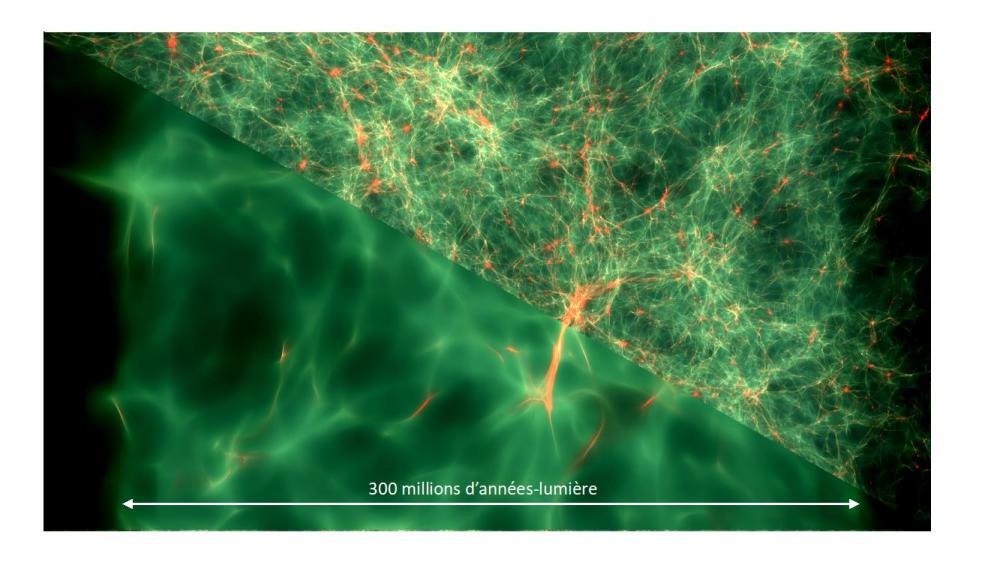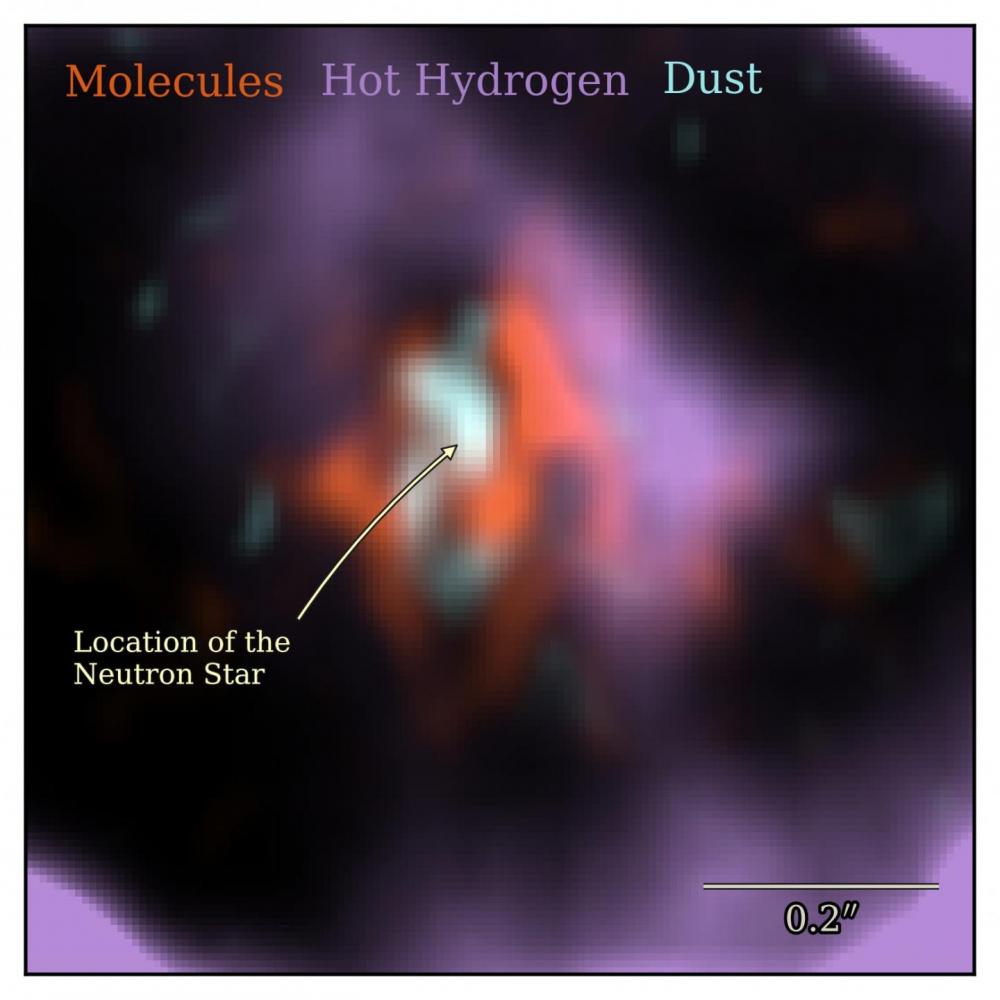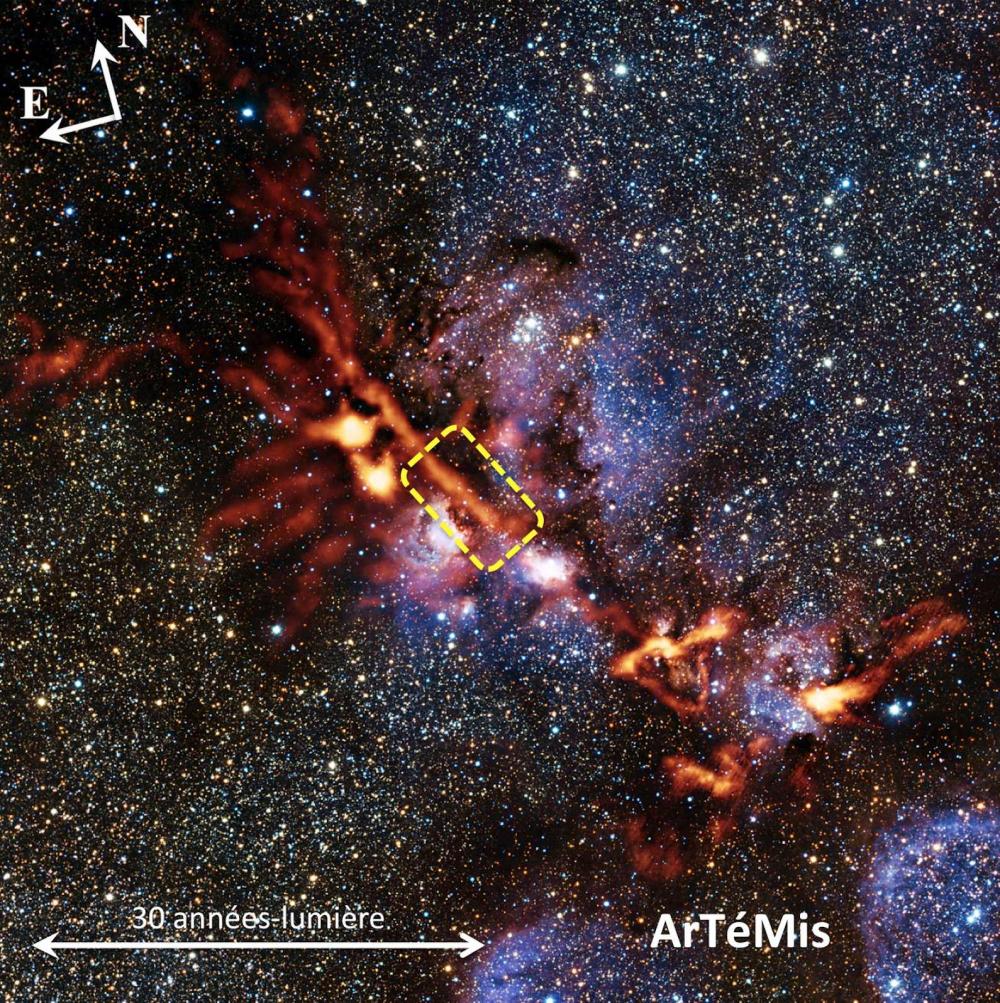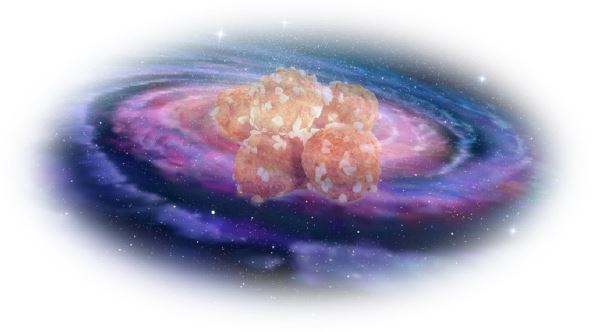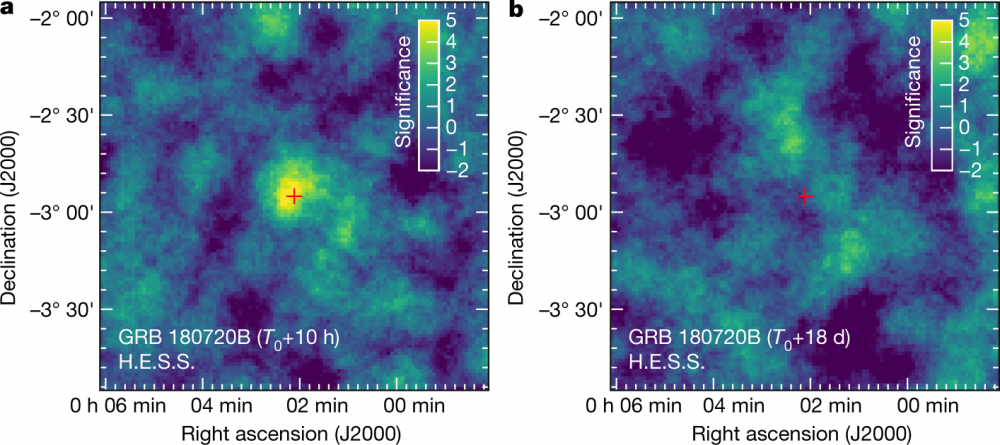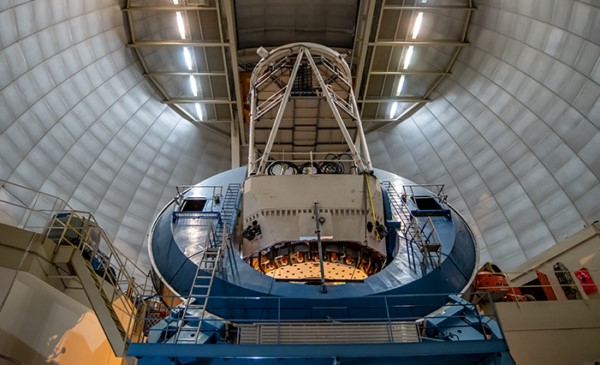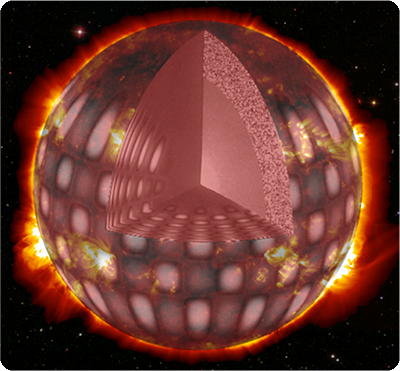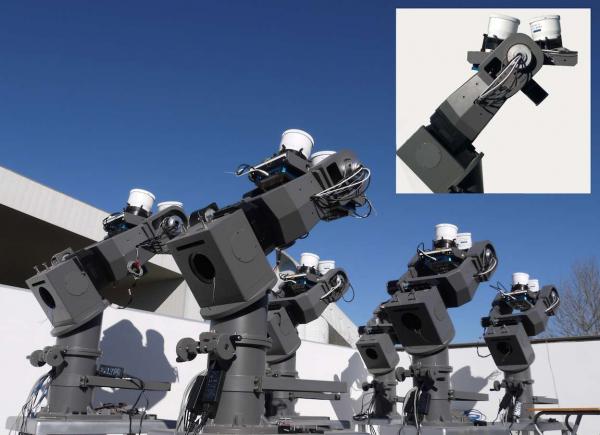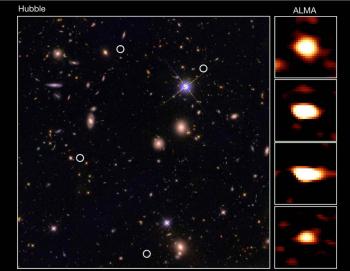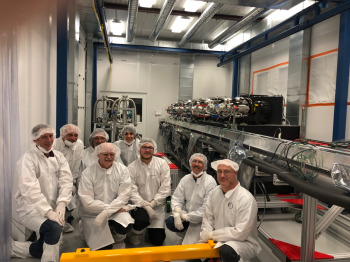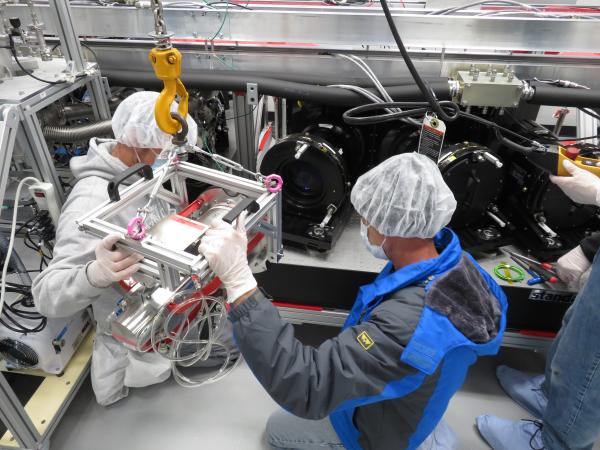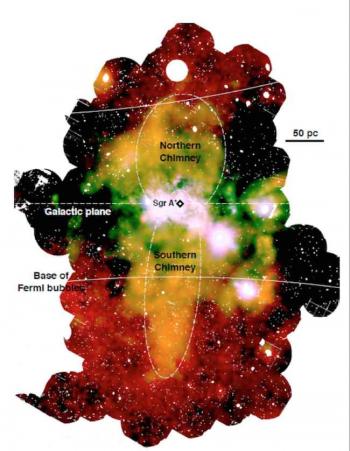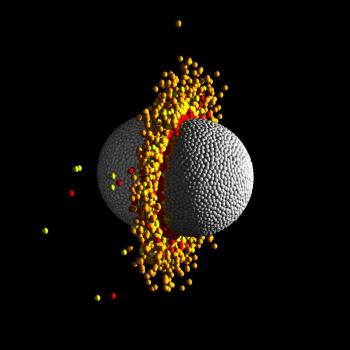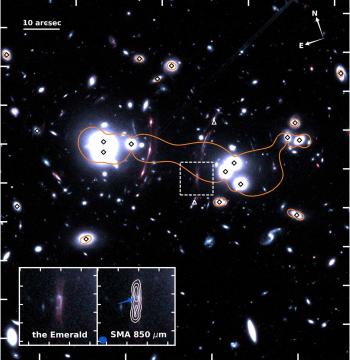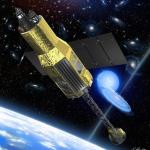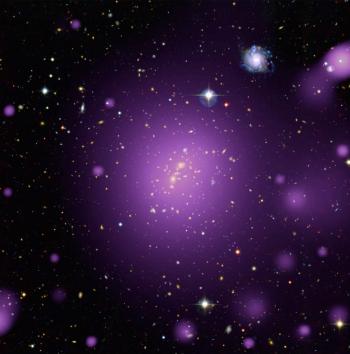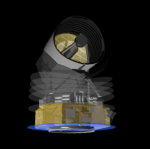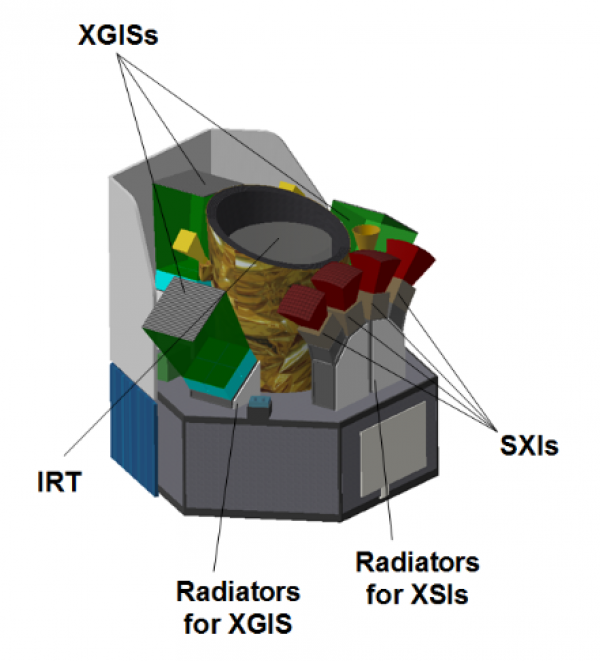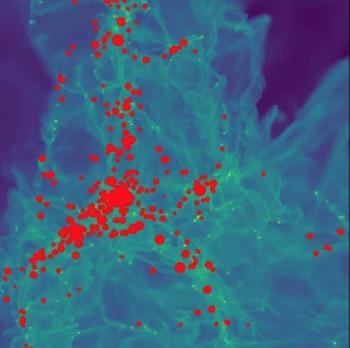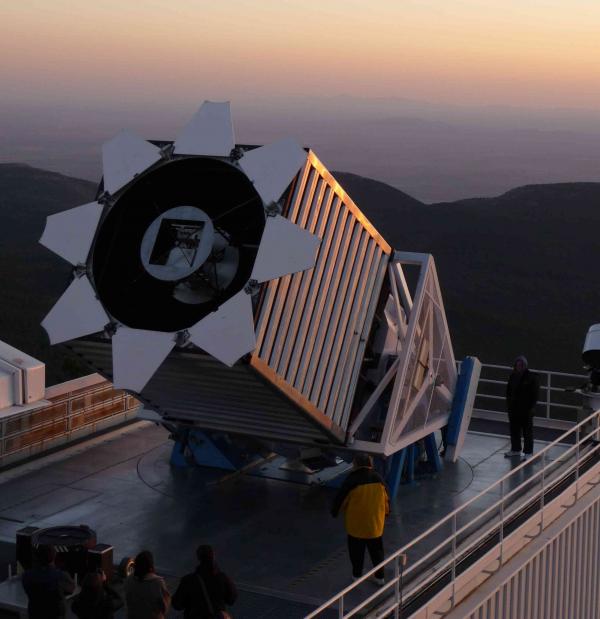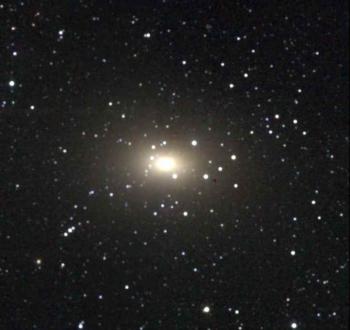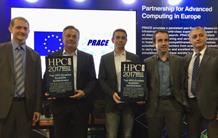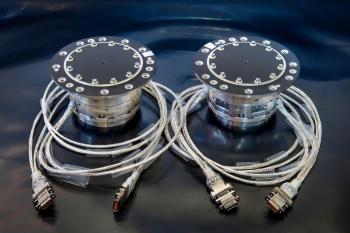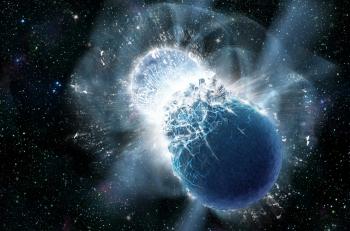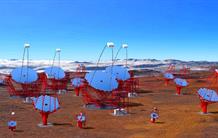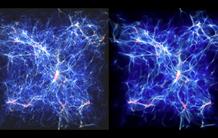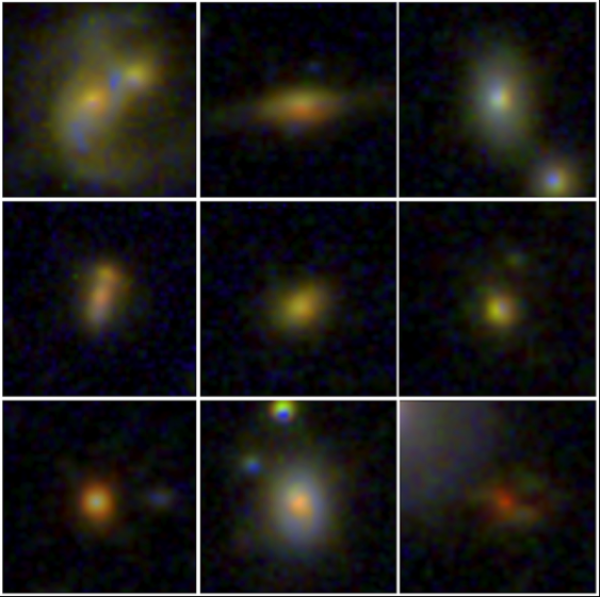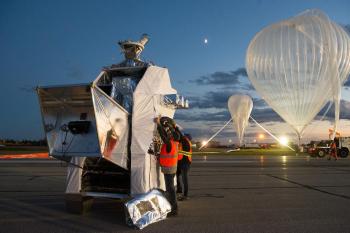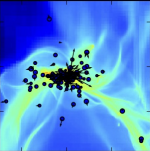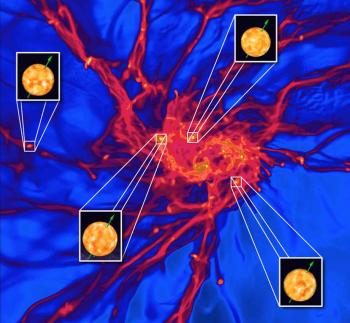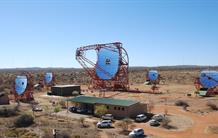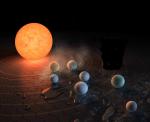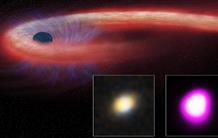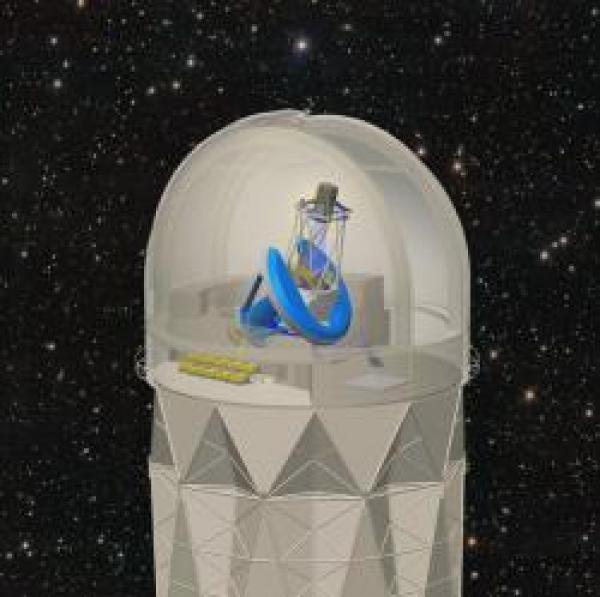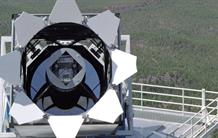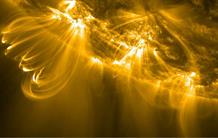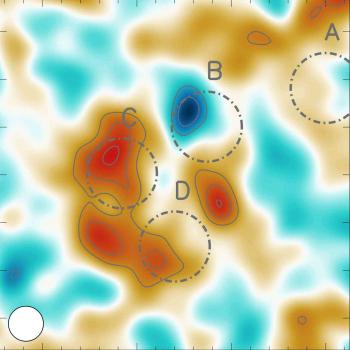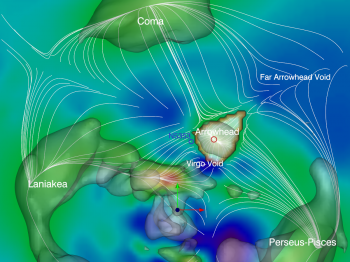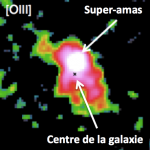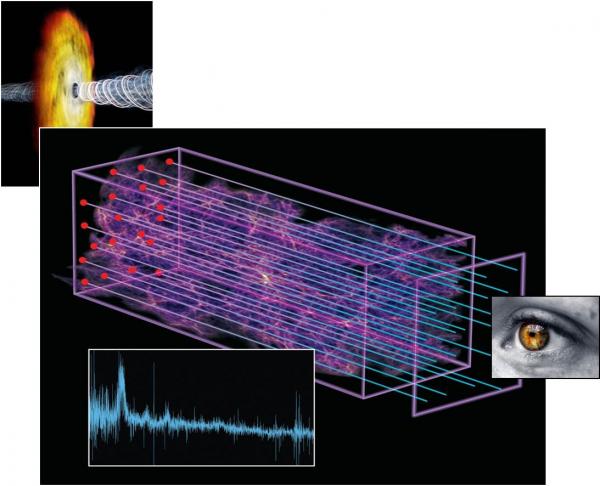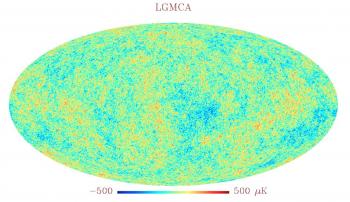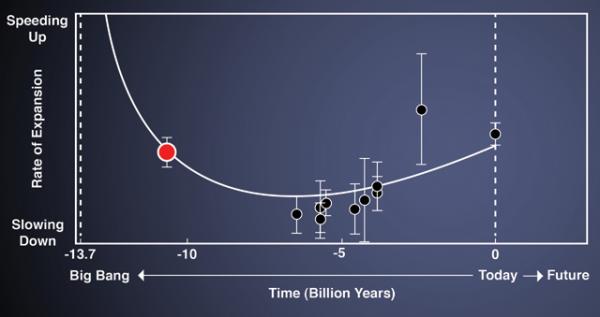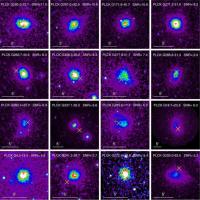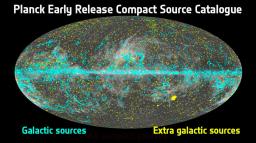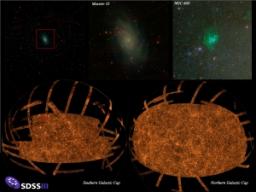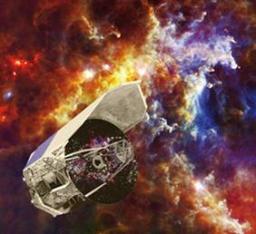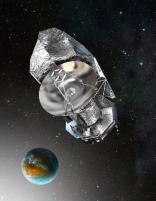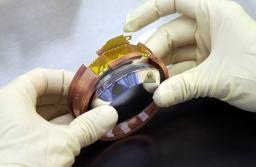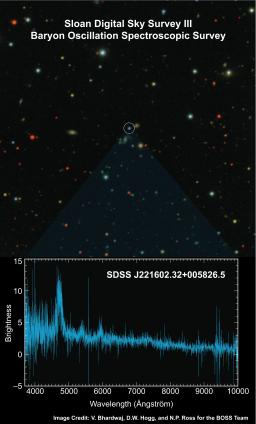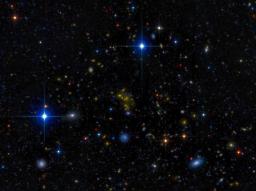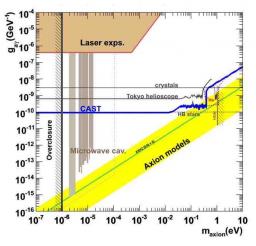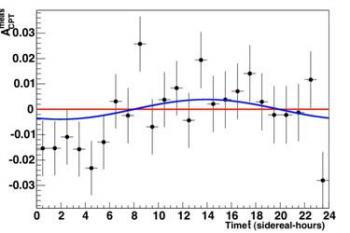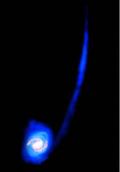Understanding the diverse stellar populations that make up galaxies is crucial to studying their formation over cosmic time. Nevertheless, some intractable stars continue to resist the modellers! Their complex nature and short lifetimes make stars in the asymptotic branch of thermally pulsating giants (TP-AGB) difficult to model, a subject of debate for decades. The James Webb Space Telescope is finally lifting the veil on their contribution to the spectrum of distant galaxies. These discoveries have implications for determining the age and stellar mass of galaxies, as well as for cosmic dust production and chemical enrichment.
This discovery has just been published in the prestigious journal Nature
On 15 October, ESA's Euclid space mission revealed the first piece of its grand map of the Universe, showing millions of stars and galaxies. This first piece of Euclid's survey was revealed at the International Astronautical Congress in Milan by ESA Director General Josef Aschbacher and Director of Science Carole Mundell.
Thanks to an agreement between CEA and ESA, two experts in image processing, Jean-Charles Cuillandre and Emmanuel Bertin, both astronomers at the Observatoire des Sciences de l'Univers de Paris-Saclay (OSUPS) and members of CEA Irfu's Astrophysics Department, produced this mosaic under ESA supervision. The project's IT logistics were handled by the OSUPS Data and Operations Centre (IDOC), with technical support from the VirtualData platform at the Paris-Saclay mesocentre.
It is well established that most galaxies harbor a supermassive black hole, long suspected of hindering the formation of new stars. However, no study had previously demonstrated a direct link between these black holes and the evolution of galaxies.
By analyzing dozens of galaxies, researchers, including those from the Department of Astrophysics at CEA – Paris-Saclay, discovered that the amount of hydrogen gas, essential for star formation, decreases in direct correlation with the mass of the central black hole, much more so than with the mass of the galaxy itself. This gas, primarily sourced from the accretion of matter from intergalactic space, appears to be blocked by black holes, preventing galaxies from replenishing external material. This phenomenon, termed "asphyxiation," suggests that black holes play a central role in the history of galaxies by limiting their growth.
This study was published in the prestigious journal Nature.
METIS is a first-generation instrument for the ELT, the Extremely Large Telescope currently under construction in the Atacama Desert in Chile, which will see its first light in 2028. Irfu has been involved in this instrument since 2018. In 2021, 14 cryomechanisms that will drive a dozen optical systems on the METIS instrument were delivered. METIS comprises two separate units: one for spectroscopy, the other for imaging. The latter contains coronagraphs, based on phase masks. The performance of the masks designed by the University of Liège has been optimised by measurements carried out on the astrophysics department's optical bench dedicated to infrared imaging. In April 2024, after 6 months of testing and performance optimisation, the three masks for N-band coronagraphy (7.5-13.5µm) were delivered to the METIS consortium. They will shortly be integrated into the instrument, which will enter the manufacturing phase in 2024.
A team of theorists from the CEA's Astrophysics Department (DAP), working within the Laboratory for Modeling Astrophysical Plasmas (LMPA), have carried out simulations using the CEA's supercomputers, with the aim of understanding the formation of stars and protoplanetary disks. Months of computational work have enabled us to achieve resolutions never achieved before, revealing new details about the formation of these objects.
The simulations yielded two major results: protostars are turbulent from birth, and protoplanetary disks form from material ejected from the star's surface.
These results have been published in Astronomy & Astrophysics: The birth and early evolution of a low-mass protostar and Formation of low-mass protostars and their circumstellar disks.
The Euclid collaboration today publishes five reference papers on the mission and ten scientific papers based on the first images unveiled to the public in November 2023, as well as the new images presented today by ESA.
This phase of preliminary observations conducted last fall provides a glimpse into the telescope's exceptional performance. The first scientific papers already reveal the discovery of newly formed rogue planets, the richness of the globular cluster population around nearby galaxies, the discovery of new low-surface-brightness dwarf galaxies in a neighboring galaxy cluster, the distribution of dark matter and intra-cluster light in galaxy clusters, and dozens of massive galaxies dating back to a time when the Universe was only 5% of its current age.
In parallel with these 15 articles, ESA today unveils five new images based on these observations, once again showcasing the sharpness of Euclid's images and its ability to observe all scales of the Universe from the optical to the near-infrared domain over a wide field of view, more than twice the surface area of the full Moon.
The CEA plays a major role in the entire mission within the Euclid collaboration, from design and implementation to its scientific exploitation over the next six years. The CEA is also heavily involved in this scientific validation program for the telescope set up by ESA. Jean-Charles Cuillandre, an astronomer at the CEA-Irfu Department of Astrophysics, analyzed these first scientific data transmitted by Euclid to create color images and enable their scientific exploitation. He is a co-author of the 10 scientific papers detailing the initial discoveries, including 2 as the first author, one on the Perseus galaxy cluster and the other on image processing.
Although significantly more common in the Universe, ultra-cool dwarf stars remain poorly understood due to their low luminosity. Consequently, our understanding of their planetary population remains limited, even though they represent a substantial fraction of the planets in our Milky Way. It is in this context that the SPECULOOS program was developed, aiming to explore exoplanets around this type of star.
Thanks to this program, an international team of researchers, including the CEA, has just discovered a new planet: SPECULOOS-3 b. Earth-sized, it orbits the ultra-cool dwarf SPECULOOS-3, located 55 light-years away. This discovery marks the second planetary system identified around this type of star, following the famous TRAPPIST-1 system, also detected through this observation program.
The characteristics of SPECULOOS-3 b make it one of the most promising rocky exoplanets for detailed characterization through emission spectroscopy with the JWST's MIRI instrument. Its sensitivity is expected to provide significant constraints on the planet's atmospheric composition or surface mineralogy, if applicable.
This discovery was published in the journal Nature Astronomy.
An international team, including the Astrophysics Department of CEA-Saclay, led by the Instituto de Astrofísica e Ciências do Espaço (IA), utilized one of the world's most advanced spectrographs to detect the smallest "stellar tremors" ever recorded in an orange dwarf star, making it the smallest and coldest star observed to date with confirmed solar oscillations. This study demonstrates that asteroseismology is a powerful technique for studying such stars, opening new perspectives in our understanding of stellar physics and, by extension, exoplanets.
This study is published in the journal Astronomy & Astrophysics Letters: “Expanding the frontiers of cool-dwarf asteroseismology with ESPRESSO: Detection of solar-like oscillations in the K5 dwarf ε Indi”.
UPDATE [03/26/2024]: Euclid's optics de-icing procedure has produced much better results than expected. The main suspect in the blurred vision of Euclid's VIS instrument was the coldest mirror behind the telescope's main optics. After warming it by just 34 degrees, from -147°C to -113°C, was enough for all the icy water to evaporate. Almost immediately, Euclid regained its sight with 15% more light from the Universe! Scientists and engineers were thus able to determine precisely where the ice had formed, and where it was likely to form again. Find out more on the ESA page.
A few layers of water ice - with the width of a DNA strand - are beginning to affect Euclid's vision; a common issue for spacecraft in the freezing cold of space, but a potential problem for this highly sensitive mission that requires remarkable precision to study the nature of the dark Universe. After months of research, Euclid's teams across Europe, including CEA-Saclay, have devised a new procedure designed to defrost the mission's optics, which involves independently heating the mirrors. The campaign unfolded as planned, and while it's still too early to definitively establish its effectiveness, preliminary analyses are promising.
XMM-Newton's energetic universe joins forces with the Euclid satellite's vision of the sky. A thousand hours of X-ray observations, over a region 40 times the size of the moon, will complement multi-wavelength studies of the cosmic evolution of galaxy clusters. A decisive association to constrain cosmological scenarios and reveal the nature of dark energy.
ISA (Laser Interferometer Space Antenna), the European Space Agency's large-scale mission to explore the Universe by observing the many sources of gravitational waves, was adopted on Thursday January 25 by ESA's Scientific Programs Committee, meaning that the concept and technology are recognized as sufficiently advanced for construction of the instrument and satellites to begin. Launch is scheduled for 2035.
This mission will revolutionize astrophysics, cosmology and fundamental physics, with 3 satellites orbiting the Sun in a 2.5 million km triangle to detect gravitational waves emitting in the millihertz band, such as supermassive black hole binaries. These 3 satellites exchange laser beams to interferometrically detect distance variations of the order of ten picometers induced by gravitational waves. Irfu is heavily involved in the LISA project, contributing to the instrument, data analysis and source science. It is in charge of the reference mass simulator and the stable structure for testing the interferometric core, the analysis of alerts, a contribution to the global analysis and co-leading of the project for France. It is also preparing the scientific exploitation and in particular the tests associated with fundamental physics, the study of the primordial Universe and the study of magnetic fields in white dwarf binary systems.
The James Webb Space Telescope has produced a new portrait of the atmosphere of exoplanet WASP-39b, a "hot Saturn" some 700 light-years away. After the first near-infrared observations in 2022, which revealed for the first time the presence of sulfur dioxide (SO2) in the atmosphere of an exoplanet, it was observed again in 2023, but this time in the far infrared, using the MIRI spectrometer. This new observation enabled the international research team, including Saclay's Astrophysics Department, to confirm the presence of this molecule in the atmosphere of WASP-39b and to constrain its abundance. This recent study demonstrates that photochemistry shapes the atmosphere of WASP-39b over a wide range of wavelengths.
To unravel this mystery, several teams with diverse skills from the Astrophysics Department had to come together, as the architecture that unites the star to its planet is highly complex. They had to combine a detailed understanding of stellar and planetary physics, exploring their interactions, with a thorough knowledge of the observations made by NASA's Kepler satellite to be able to decipher the data.
The study shows that the observed rarity seems to derive not from observational bias, but rather from physical causes. Tidal effects and magnetism are sufficient to explain qualitatively and quantitatively the migration of nearby planets around fast-rotating stars. Moreover, this migration appears to be dependent on the spectral type (fundamentally linked to mass) of the star. While these results are promising, it is nevertheless necessary to expand the sample size to better constrain scarcity and better understand the mechanisms at play. In particular, this study highlights the importance of considering the spectral type of stars (their masses) if we are to correctly model star-planet interactions.
This work is published in Astronomy & Astrophysics.
On November 8, 2023, ESA's Science Program Committee (SPC) approved the evolution of the Athena (Advanced Telescope for High-Energy Astrophysics) mission, now named NewAthena, and confirmed its status as the flagship mission of ESA's Cosmic Vision program.
Positioned as a pioneer in X-ray astrophysics for the coming decades, NewAthena will enable the astronomical community to make major scientific advances in our understanding of the hot, energetic universe. Key scientific themes include the evolution of the universe's structures, the growth and impact of supermassive black holes through cosmic time, and many other astrophysical fields for which the NewAthena X-ray observatory will provide unique data.
Formal adoption of NewAthena is scheduled for 2027, with a view to launch in 2037.
Barbara Perri, an astrophysicist at Irfu's Astrophysics Department and an expert in space weather, has been awarded an ANR contract for the WindTRUST project, which aims to predict solar activity in order to protect against it.
The WindTRUST project is based on improved numerical simulations of the environment between the Sun and Earth, in particular the still poorly understood link between the Sun's magnetic atmosphere and its fast-moving wind of energetic particles.
An international team led by French researchers, including those at DAp, publishes on November 28, 2023 in the Astrophysical Journal a compilation of 340 pulsars seen in gamma rays (30 MeV - 30 GeV) with the LAT space telescope on NASA's Fermi satellite.
Prior to Fermi's launch in 2008, only 11 pulsars were known in gamma rays. This new catalog brings together all the characteristics of all known gamma-ray pulsars. It contains a wealth of information on the mechanisms, poorly understood today, by which pulsar beams are generated. This wealth of centralized information will help theorists explore new avenues in their quest to understand these phenomena.
Astrophysical Journal Supplement 2023, Smith et al, The Third Fermi Large Area Telescope Catalog of Gamma-ray Pulsars
Antoine Strugarek, an astrophysicist in Irfu's Astrophysics Department, has been awarded an ERC Consolidator contract. The core of his ExoMagnets project is to understand the magnetic coupling between an exoplanet and its star, and therefore the magnetic field of exoplanets, which is crucial for the habitability of a planet.
The aim of the ExoMagnets project is to develop new theories and high-performance simulations using future exa-scale computing infrastructures in order to exploit existing and future observations of the magnetism of distant exoplanets.
The consortium of laboratories that has developed the MIRI instrument for the JWST is benefiting from guaranteed observation time. The CEA's Astrophysics Department, which is part of the consortium, has defined and coordinated the exoplanet observation programme. Among the objects selected are a number of brown dwarfs, which are excellent proxies for studying giant exoplanets, particularly those that orbit far from their star, much further away than the planets in our solar system. The physical and chemical processes that govern brown dwarfs are very similar. The first results concerning the cold brown dwarf W1828 have just been published in the journal Nature. By pointing the James Webb Space Telescope (JWST) at this object, a team of researchers including DAp-AIM researchers were able to use the MIRI instrument to measure, for the first time, the isotopologues of ammonia in the atmosphere of a cold brown dwarf, paving the way for a better understanding of the formation of exoplanets.
These results have been published in the journal Nature.
ESA has selected the THESEUS (Transient High Energy Sky and Early Universe Surveyor) mission as a medium-sized mission candidate. THESEUS is the natural successor to the Sino-French SVOM (Space based astronomical Variable Object Monitor) mission, which will be launched early 2024 (for 5 years of operation) and in which IRFU is also playing a leading role.
THESEUS has been chosen from among 27 missions, along with Plasma Observatory (study of the Earth's magnetosphere) and M-MATISSE (study of the atmosphere and magnetosphere of Mars), for a preliminary study lasting three years (2024-2026), at the end of which one of the three missions will be carried out for launch in 2037.
CEA/IRFU will play a leading role in the mission, as the PI of the international consortium (which includes INAF and Politecnico Milano in Italy, University of Geneva in Switzerland, and LAM Marseille and IJClab Orsay in France) responsible for developing and delivering one of the three satellite's instruments: the IRT (Infra-Red Telescope) and more specifically the camera placed at its focus.
To reveal the influence of the dark components of the Universe, over the next six years Euclid will be observing the shapes, distances and movements of billions of galaxies. This mapping will cover periods going back to the last 10 billion years of cosmic history, in order to gain a better understanding of where, when and how dark energy and matter - two key components of the universe that are still a mystery - act.
As a prelude to the mission, it was decided to illustrate the satellite's scientific and instrumental capabilities through a series of images of the nearby Universe. Jean-Charles Cuillandre, an astronomer in CEA/IRFU's astrophysics department, led this 'ERO' (Early Release Observations) campaign over several months, with a group of scientists from the Euclid collaboration and ESA, from the choice of the five astrophysical sources to image processing, from raw data to analysed images, combining the responses of the VIS (visible light) and NISP (near infrared) instruments.
An international team of scientists, including a researcher from Irfu's Astrophysics Department, used several space and ground-based telescopes, including the James Webb Space Telescope and the European Southern Observatory's Very Large Telescope, to observe an exceptionally bright gamma-ray burst detected on March 7, 2023, GRB 230307A, and identify the neutron star merger that generated the explosion responsible for the burst. In particular, the Webb telescope enabled scientists to detect the chemical element tellurium in the aftermath of the explosion. This discovery supports the hypothesis that neutron star mergers are one of the main sources of production and expulsion into the interstellar medium of some of the heaviest elements known in the Universe.
These results were published in Nature on October 25, 2023 (Levan et al.).Heavy element production in a compact object merger observed by JWST | Nature
For the 17th edition of the Prix Jeunes Talents France, the L'Oréal Foundation rewarded 35 brilliant young female researchers in France, selected from 618 eligible applications by a jury of excellence comprising 32 researchers from the French Academy of Sciences. At Irfu's Astrophysics Department, Achrène Dyrek received the award for physics.
Achrène Dyrek has just obtained her PhD in astrophysics. She began her thesis in 2020 at CEA's Department of Astrophysics (DAp), under the supervision of Pierre-Olivier Lagage. During this time, she dedicated herself to the study of planetary atmospheres as seen by the James Webb Space Telescope (JWST - NASA/ESA/CSA), using the MIRI (Mid-InfraRed Instrument) developed at DAp.
Fermi-LAT telescope continues systematic γ-ray survey
NASA's Fermi satellite was launched in June 2008, and the Fermi-LAT telescope has been carrying out a systematic γ-ray survey of near-GeV energies covering most of the sky every 3 hours (and the whole sky in no more than a week) since August 2008.
The question of our place in the Universe - "where are we in the Universe?" - is a fascinating one, and the source of one of the oldest sciences: Cosmography, the mapping of the Cosmos. Using a method based on the study of the velocity fields of galaxies measured by different telescopes, cosmographers - a team of researchers from the CEA, the University of Hawaii and the University of Queensland - reconstruct the cosmic web of our nearby Universe and reveal its architecture, revealing large structures of superclusters of galaxies, but also large voids, shaped by gravitation [1].
Daniel Pomarède, from Irfu, has been in charge of mapping Cosmicflows catalogues and displaying them in 3D and interactively since 2010. Between 2014 and today, their catalogue has grown from 8,000 to 56,000 galaxies, and the map is expanding with the inclusion of a catalogue of galaxies measured by the SDSS collaboration [2].
With their latest Cosmicflows-4 catalogue, they have just discovered an immense bubble of galaxies, a new fossil from the beginnings of our Universe, dating from the same period as the cosmic microwave background radiation. This is the first time that a remnant of a wave, witness to the primordial universe, has been measured individually in the distribution of galaxies.
These results have just been published in The Astrophysical Journal.
“Ho’oleilana: An Individual Baryon Acoustic Oscillation?” by R. Brent Tully, Cullan Howlett, and Daniel Pomarède, The Astrophysical Journal, Volume 954, Number 2 https://doi.org/10.3847/1538-4357/aceaf3
The Euclid satellite, launched from Cape Canaveral on July 1st, is traveling to reach its orbit at the second Lagrange point, which it should reach in early August. This transit time has been used to commission Euclid, checking the satellite's services such as communications, power, and pointing, and then the two instruments, VIS and NISP, as well as fine-tuning the telescope's focus. The instrument teams have just released the first "raw" images (untreated) to mark the success of instrument commissioning.
Marc Sauvage (astrophysicist at DAp/Irfu and one of the two French representatives on the Euclid consortium council): "These images perfectly match what we had simulated, but in a simulation, we know that everything we see was deliberately placed there, so in a way, it's not surprising. Here, everything we see is real, and nothing we see was known at this level of detail; it makes us want to look into every corner, to enlarge everything to see as much detail as possible. And since there is a tremendous amount of detail in just these two images, it becomes dizzying!"
Michel Berthé (Euclid project leader at DAp/Irfu): "I am truly amazed by the beauty of these images and the amount of information that can be found in them. We are only at the very beginning of the analysis of these initial results, but they are already very promising.
All the teams at CEA who have worked for more than 10 years on the design, production, and testing of the elements we have provided for the VIS and NISP instruments are particularly proud of these initial results, which demonstrate the nominal operation of our supplies as well as the entire satellite."
Using the James Webb Space Telescope, a group of astronomers led by MPIA, in collaboration with a team from the Astrophysics Department of CEA Paris-Saclay, searched for an atmosphere on the rocky exoplanet TRAPPIST-1 c. Although the planet is almost identical to Venus in terms of size and mass, its atmosphere turned out to be very different. By analyzing the heat emitted by the planet, they concluded that it may have only a tenuous atmosphere containing a minimum of carbon dioxide. However, this is also consistent with a barren rocky planet devoid of any significant atmosphere. This work gives us a better understanding of how the atmospheres of rocky planets orbiting low-mass stars can withstand strong stellar winds and intense UV radiation.
The results are presented in the journal Nature:
The Universe is immensely big, and getting bigger all the time. To study dark energy, the mysterious force behind the accelerating expansion of our Universe, scientists are using the large Dark Energy Spectroscopic Instrument (DESI) survey to map over 40 million galaxies, quasars and stars. Today, the collaboration has released its first batch of data, with nearly 2 million astrophysical objects for researchers to study. It is also publishing 15 papers on the scientific study of these data, and on the instrument, operations and validation of the survey observation strategy.
The data set (80 terabytes) comes from 2,480 exposures taken over six months during the so-called "survey validation" phase in 2020 and 2021 and processed in Python language on the supercomputer at the National Energy Research Scientific Computing Center (NERSC, Berkeley, USA). During this period, between the instrument's commissioning and the start of the official scientific campaign, researchers ensured that the instrument's performance would meet their scientific objectives - for example, by checking the time needed to observe galaxies of different luminosities, and validating the selection of astrophysical objects such as galaxies, quasars and stars to be observed.
Read the Berkeley press release : https://newscenter.lbl.gov/2023/06/13/desi-early-data-release-holds-nearly-two-million-objects/
On October 9, 2022, at 13:16 and 59.99 seconds, a gamma-ray burst (GRB) dazzled almost all the X-ray and gamma ray detectors available at the time. Since their discovery, multi-wavelength telescopes in space and on the ground have continuously monitored these events. This outburst, named GRB221009A, shook the world community of astrophysicists, who have since been analysing it to understand the physical phenomena that triggered this most intense burst of energy in our history.
|
|
X-rays detection due to the scattering of light from the initial explosion of GRB 221009A by the dust of our galaxy, has led to the formation of expanding rings. This "movie" (in arbitrary colors) shows these rings formed by X-rays detected by NASA's Swift telescope. It was created by combining images captured over a 12-day period. Credit A. Beardmore, University of Leicester, NASA, Switf |
Discovered in 2009, exoplanet GJ1214b orbits a small star just 40 light-years away. With a mass around six times that of Earth and an atmosphere made up of hydrogen and helium, it is considered a "mini-Neptune".
A team from NASA, in collaboration with researchers from CEA Paris-Saclay, pointed the JWST at the planet using the MIRI instrument, built by CEA Paris-Saclay, for some 40 hours. This unprecedented observation made it possible to obtain, for the first time, the phase curve of an exoplanet with MIRI, i.e. complete tracking of the planet's rotation around its star.
By following the evolution of the exoplanet-star system's emission, the research team was able to determine the planet's temperature to within 9°: 280°C on the dayside and 164°C on the night side. Comparing the observations with atmospheric models, the researchers deduce that: 1. the small temperature difference between the two sides, despite the planet's synchronous rotation, means that there is a good exchange of energy between the sides, due to a dense atmosphere. 2. The relatively low temperature on the dayside, given the planet's proximity to its star, indicates that a layer of aerosols in the exoplanet’s upper atmosphere reflects much of the stellar radiation. The type of aerosol with such a property has yet to be determined. 3. The atmosphere contains many elements heavier than hydrogen and helium, probably abundant water.
The results are published in the prestigious journal Nature
The European Research Council has just announced the names of the winners of the Advanced Grant. This 2023 edition rewards in particular two researchers from the CEA's fundamental research department for their work in the fields of astrophysics and neuroscience. Anaëlle Maury is the leader of the PEBBLES project. This project consists of developing an innovative methodology to characterise the properties of dust around very young stars in the process of forming their proto-planetary disks. Dust is one of the key elements in the physical processes regulating the formation of stars and their planetary systems, but recent observations are overturning the models used until now to describe its evolution from submicron grains to pebbles. Observing and modelling the properties of dust grains during the earliest phases of disk formation promises to provide important insights into the conditions leading to the formation of solar systems such as our own. Through PEBBLES, the teams will use new dust models that are better suited to denser astrophysical environments and will use them in comparison with observations from space missions and ground-based observatories from the infrared to the millimetre range.
An international team of researchers has used NASA's James Webb Space Telescope to measure the temperature of the rocky exoplanet TRAPPIST-1 b. This is the world's first detection of thermal emission from a rocky exoplanet as small and “cool” as the rocky planets in our own solar system. TRAPPIST-1 b receives about twice the amount of energy as Venus receives from the Sun and four times more than Earth. The result indicates that the dayside of the planet has a temperature of about 227°C (500 K) and suggests that it has no significant atmosphere. The study, co-authored by three researchers from the Dap, has just been published in the journal Nature, on Monday 27 March.
Magnetars are neutron stars known for their wide variety of electromagnetic emissions coming from the dissipation of their extreme magnetic fields, which are the strongest known in the Universe and can reach 1015 Gauss, or 10 billion times that of the strongest magnet created by humans.
How could these magnetic fields have been formed? This is one of the open questions that a Franco-German team led by the supernovae team of the Department of Astrophysics (DAp) of CEA Paris-Saclay, has recently tried to answer by proposing a numerical modeling of a new scenario of formation of magnetars in a study published in the scientific journal "Astronomy and Astrophysics".
This scenario suggests that the matter falling on the neutron star a few seconds after its formation can trigger a dynamo effect called Tayler-Spruit which would amplify its magnetic field, and this independently of its initial rotation speed. The simulations of this scenario reproduces the measured intensity of magnetar magnetic fields. Therefore, this study represents another step towards the understanding these atypical objects.
CEA has delivered to CNES the flight version of the ECLAIRs instrument software for the SVOM satellite. This concludes a major instrumental development phase conducted by CEA over a period of 6 years to produce what is maybe one of the most complex software packages ever carried on a French scientific space instrument. The latest version of the software equips the ECLAIRs onboard computer, which departed to China in early 2023. It will be used during the satellite integration tests in Shanghai in preparation for the launch planned for early 2024. This software will analyse in real time the data from the instrument in flight, in order to detect gamma-ray bursts and localise them to better than 12 arcmin on the sky, to reorient automatically the satellite for follow-up observations, and to alert the scientific community.
The four principal investigators receive almost 10 million euros for their project 4D-STAR, which will develop and deliver innovative numerical models of rotating magnetic stars in three spatial dimensions throughout their evolution.
ERC Synergy Grants of the EU's research and innovation programme Horizon Europe, help groups of two to four outstanding researchers bringing together complementary skills, knowledge and resources in one ambitious overarching project, addressing some of the world’s most formidable research problems. The projects typically span multiple scientific disciplines - in the case of 4D-STAR astronomy, theoretical physics, fluid mechanics, applied mathematics, computer science and software development.
For the first time since the XMM launch (1999), a cosmological analysis constraining the density of matter in the universe, from a catalog of 178 galaxy clusters detected by XMM, has been possible and in an autonomous way, i.e. with its own distance measurements and without calling upon additional information from numerical simulations or other cluster samples. This analysis was conducted in the framework of the XXL consortium, mainly by Christian Garrel during his thesis at the Astrophysics Department (DAP) of CEA Paris-Saclay (see the article on arXiv).. The results confirm the standard cosmological model in a completely independent way, with an accuracy rivalling with other probes covering much larger portions of the sky. The existing "cosmological" tension between the cosmological analyses of the clusters and the CMB PLANCK is thus lifted; there is no longer any need to use massive neutrinos.
This cosmological analysis from clusters has been possible thanks to the new method ASpiX, developed at DAP allowing to model properly the distant clusters. In the distant Universe, we only detect massive clusters, thus blue, which appear red because of the expansion of the Universe. Mathematically, the software analyses all possible combinations of the effect of cosmology on the properties of clusters.
The cosmological analysis exploiting all the observations of the XXL program is in progress and will include about 300 clusters. The novelty is that it will combine the ASpiX method with artificial intelligence techniques that allow identifying very quickly the cosmological model that best reflects the observed properties of the cluster population.
The LISA (Laser Interferometer Space Antenna) space mission by ESA and NASA, will observe gravitational waves from space. After its launch around 2035, LISA will observe in the low frequency band of the gravitational waves spectra and will capture the signal coming from sources which are not detected yet in the high frequency band of ground-based detectors such like Virgo, LIGO, KAGRA, or GEO600. Among the new sources of gravitational waves, the most represented are the galactic binaries whose number of detections should amount several tens of thousands. The galactic binaries are double systems made of compact stars such like neutron stars or white dwarfs in different combinations. Within the low frequency band, galactic binaries are detected during inspiral, that is to say several thousand years before fusion which is detected by ground-based detectors. Therefore, the signature of effects due to structure or internal dynamics of compact stars on the gravitational waves can potentially be detected over the lifetime of the space mission. LISA will allow to understand the state of matter inside compact objects within binary systems, their deformability, or their magnetic fields through the secular evolution of the orbits. In a recent study published in Physical Review D (DOI: https://doi.org/10.1103/PhysRevD.105.124042), a team from SYRTE in Observatoire de Paris and LDE3 from DAP/IRFU at CEA, demonstrated that the effect of magnetism within galactic binary could be measured by LISA.
As part of the Solar Orbiter science support activities and in conjunction with the ERC Synergy WholeSun grant, researchers from CEA Paris-Saclay, together with an international collaboration, have developed advanced numerical simulations to study the formation of structures of the solar wind. These simulations allow studying the interaction of the convection at the solar surface with the magnetic field. They reveal the appearance of twisted magnetic structures that can participate in the creation of switchbacks.
Nine months after its launch, the James Webb Space Telescope provides unprecedented images of an exoplanet, the first ever obtained in the mid-infrared. These images should revolutionize our knowledge of extrasolar worlds. A team of French astronomers has been involved in the observations of this planet and in the design of the coronagraphs of the telescope.
Launched on December 25, 2021, the James Webb completed its test phase in July 2022. The science programs have since begun and are already producing their first results, including the first image of an exoplanet obtained in the mid-infrared: HIP 65426 b. It is a very young giant exoplanet, about 15 million years old, located at 90 astronomical units from its star. With an estimated mass of about 7 Jupiter masse, it had been discovered with the European instrument Sphere at the Very Large Telescope in 2017. The instruments of the James Webb now make possible its direct observation in the infrared.
The dawn of a new era in astronomy has begun as the world discovers for the first time the full capabilities of the NASA/ESA/CSA James Webb Space Telescope. The telescope's first color images and spectroscopic data, which reveal a spectacular array of previously elusive cosmic features, were released on July 12, 2022.
- website with comparison of Hubble and Webb images (crédit John Christensen)
- Link to download webb pictures
- Link to download the opposite composite image
- Link to NASA video of July 12
Understanding the star formation process is a major open question in contemporary astrophysics. It is indeed the process that controls the evolution of galaxies since their birth, gradually transforming their interstellar gas into stars and enriching it with heavy elements and dust grains. It is also the formation of stars that is at the origin of the formation of planetary systems and the appearance of life. This process is however complex and still very poorly understood. It involves the understanding of a series of hydrodynamic instabilities leading to the collapse of a molecular cloud, in which gravity, magnetic field and chemistry play a central role. Moreover, the feedback, i.e. the ionizing radiation and the wind from newly formed massive stars, has the effect of destroying the rest of the molecular cloud and thus inhibiting star formation after a few million years. This feedback is a key element, but it is still insufficiently understood.
Scientists from the CosmoStat laboratory at CEA have produced within the international science collaboration UNIONS (Ultraviolet Near Infrared Optical Northern Survey) a reference catalogue of 100 million gravitationally lensed distant galaxies, one of the largest datasets ever created. This new collection is based on thousands of deep images of the northern sky captured by MegaCam, a large digital camera built at CEA, mounted on the Canada-France-Hawaii Telescope (CFHT). Three new publications present dark-matter mass maps of the cosmic web, showing how the high-density regions in these maps help measure the still poorly known properties of dark matter. In the near future these observations will provide essential support to the European space telescope Euclid. This ESA satellite mission will map the cosmic web over the entire accessible sky at an unprecedented resolution to measure the properties of the mysterious dark energy.
While type Ia supernovae are considered as highly symmetric supernovae, the explosion in a tight binary system composed of two white dwarfs revises this paradigm. An international team (Japan, Canada, France), including a researcher from the Department of Astrophysics/AIM Laboratory of CEA Paris-Saclay, publishes a study in the Astrophysical Journal that reveals that the distinctive asymmetric structures of such a supernova leave post-mortem imprints on the morphology of the ejected matter. These morphological signatures persist and are observable in the late phase of supernova remnants. These results open the possibility to identify and characterize the explosion scenario of this type of supernova.
On the evening of the 28th, we could read on NASA's blog: "It's official, the alignment of NASA's James Webb Space Telescope is now complete"!
To say that all the instruments of the James Webb Space Telescope are perfectly aligned, means that the primary mirror is well adjusted. The images are already breathtaking while the adjustment phase of all the elements of the telescope is not finished yet.
For this test, the Webb telescope pointed at a star and the quality of the alignment was verified with a part of the Large Magellanic Cloud providing a dense field of hundreds of thousands of stars on all instrument sensors. Webb's three imaging instruments are NIRCam (images below at 2 microns wavelength), NIRISS (image at 1.5 microns) and MIRI (image at 7.7 microns). MIRI detects light in a lower energy range (or longer wavelength) than the other instruments, revealing the emission from interstellar clouds as well as starlight.
These images are used to assess image sharpness, but also to accurately measure and calibrate subtle image distortions and alignments between the instrument's sensors as part of the overall Webb instrument calibration process.
Archival observations of 25 hot Jupiters by the NASA/ESA Hubble Space Telescope have been analysed by an international team of astronomers, enabling them to answer five open questions important to our understanding of exoplanet atmospheres. Amongst other findings, the team found that the presence of metal oxides and hydrides in the hottest exoplanet atmospheres was clearly correlated with the atmospheres' being thermally inverted.
Read the science release : Hubble observations used to answer key exoplanet questions | ESA/Hubble (esahubble.org)
The French teams of the ECLAIRs and MXT telescopes, instruments at the heart of the SVOM mission, experienced an important moment during March 2022. First, a general review of the two projects took place at CNES in Toulouse in front of a group of experts. This review allowed to verify that the two instruments meet the technical specifications and will be able to carry out the scientific mission. Then a series of team visits took place in the two CNES clean rooms housing the flight models of the two instruments, ECLAIRs and MXT.
The Solar Orbiter mission, launched on February 10, 2020 from Cape Canaveral has already traveled more than 2 billion km. Since its passage just 470 km above the Earth in November 2021, the science mission has officially begun. On March 26, 2022, Solar Orbiter passed within 0.32 astronomical units of our star (about 1/3 the distance from Earth to the Sun) for its fourth perihelion (the point in its orbit where Solar Orbiter is closest to the Sun) at a speed of 198,000 km/h. On this occasion, all 10 instruments onboard will be jointly switched on and pointing towards our star. As the cycle 25 of magnetic activity of the Sun is in full rise of intensity, it is highly probable that many eruptive events will be observed with the STIX telescope (Spectrometer Telescope for Imaging X-rays) whose detectors, the Caliste-SO, were conceived, realized and qualified at CEA.
On the occasion of this 4th perihelion, this milestone delivers one of the first X-ray images from STIX as well as new simulations of the Solar model from a DAp team, which have given rise to recent articles (see end of page)
The explosion of a star produces a shock wave that propagates at more than 5000 km/s for centuries and it is thought that these shocks are the main source of highly energetic particles called cosmic-rays. Studying the high-energy photon emission of supernova remnants allows us to probe the nature of the accelerated particles, their energy and their composition. A French team led by researchers from the Astrophysics division/AIM laboratory of CEA-Irfu at Paris-Saclay has confirmed the detection of gamma-ray emission above an energy of 100 MeV in the direction of the historic Kepler supernova remnant. Twelve years of observation from the LAT instrument onboard the NASA Fermi space telescope were needed to confirm the existence of an efficient particle acceleration in this remnant, one of the youngest in our Galaxy. The researchers have found that the gamma-ray emission most likely results from the interaction of accelerated ions with the surrounding medium but depending on the amplitude of the magnetic field, several scenario are plausible. This study has been accepted for publication in the journal Astronomy and Astrophysics.
ESA's PLATO mission has been given the green light to continue its development after a successful critical review on January 11, 2022.
PLATO, or PLANetary Transits and Oscillations of stars, is the third medium-class mission in ESA's Cosmic Vision program. Its objective is to find and study a large number of planetary systems, with a focus on the properties of Earth-like planets in the habitable zone around solar-type stars. PLATO has also been designed to study stellar oscillations through asteroseismology, which will allow precise measurement of the parameters of the planets' host stars, including their age.
The review verified the maturity of the entire space segment (the service module and the payload module), confirming the robustness of the satellite-payload interfaces and the payload development schedule. Particular emphasis was placed on the serial production of the 26 cameras, and the robustness of the development schedule for both modules. PLATO will use the 26 cameras to discover and characterize exoplanets orbiting stars similar to our Sun.
Rogue planets are elusive cosmic objects that have masses comparable to the largest planets in our Solar System but do not orbit a star, instead roaming freely on their own. Not many were known until now, but a team of astronomers, using data from facilities across the world, have just discovered at least 70 new rogue planets in our galaxy just a few hundred light-years away in the Scorpion sky region. This is the largest group of rogue planets ever discovered, an important step towards understanding the origins and features of these mysterious galactic nomads.
The Milky Way is a spiral galaxy. If we could travel out of it we would probably observe a flat disk with spiral arms connected to its central core. Stuck inside the Milky Way, with no bird's eye view and limited precise distance measurement to interstellar clouds, the exact shape of the Galaxy spiral pattern is difficult to assess and remains not well known.
For decades the astronomers have used several methods to infer the Milky Way large scale structure, and observations have led us to believe that it is likely to be a Grand Design spiral with long, thin and well defined arms like Messier 81. But a recent study of a team including a member of the IRFU Astrophysics Departement is challenging this vision.
These new results are showing that a section of one of the most well know spiral structure of the Milky Way, the Perseus arm, is not as regular and organised as it was thought. Based on the cross-analysis of several observational databases, this study provides precise measurements of the distance to 81 interstellar clouds in a specific section of the putative Perseus arm. By locating interstellar matter in three dimension, the authors reveal a much more perturbed and scattered structure, indicating that the continuous Perseus arm structure previously infered from observations might have been the result of a projection effect, an illusion predicted by W. Burton in 1971.
In the world of extrasolar planets, "GJ 367 b" is a featherweight. With half the mass of Earth, the newly discovered planet is one of the lightest of the nearly 5,000 exoplanets known today. It takes about eight hours for the extrasolar planet to orbit its host star. With a diameter of just over 9,000 kilometers, GJ 367 b is slightly larger than Mars but smaller than Earth. This planetary system is located just under 31 light years from our planet and is therefore ideal for further studies of its properties. His discovery demonstrates that it is possible to accurately determine the characteristics of the smallest and lighter exoplanets. Such studies provide new clues to better understand how planets form and evolve.
An international group of 78 researchers from 49 institutions including the Department of Astrophysics (DAp) at CEA / Irfu published this study in the scientific journal Science based on initial observations from the NASA / MIT Transiting Exoplanet Survey Satellite (TESS).
"With an orbital period of only one third of a terrestrial day, the year on GJ 367 b is therefore much shorter than the day on Earth, while the star spins on itself in 48 days, which makes around 1.7 times slower than our Sun ”says Rafael A. García, CEA researcher who is part of the team.
The DAp focused its effort in the characterization of the host-star with TESS as well as using WASP data which allowed us to determine with high precision the rotation period of the star (48 days).
Planets that are strongly irradiated by their host stars develop extended atmospheres that can be probed during transits. These atmospheres undergo photoevaporation which can lead to significant changes in the mass and composition of the planets if it continues for several gigayears. These planets are therefore valuable for understanding planetary evolution. The study of the photoevaporation of exoplanets could inform us on the evolution of the atmospheres of the planets of our Solar System whose first atmospheres would have been shaped by this phenomenon. Exoplanets allow us to study this process as it occurs. An international collaboration has studied the HAT-P-32 system (composed of the star of the same name and an exoplanet named HAT-P-32b) by studying two absorption lines: hydrogen and helium. This allowed them to identify remarkable differences between the two lines during the transit, to the surprise of scientists who also thought that hot Jupiters were rather stable to photoevaporation. Although this statement on the long-term stability of hot Jupiters’ atmospheres remains generally true, HAT-P-32b is an exception to this rule and shows that our understanding of planetary evolution remains incomplete!
After three years of reflection and development, the "Astro-Colibri" application has just been launched. This digital interface, created by researchers at Irfu/DPhP, aims to make information on transient and multi-messenger phenomena easily accessible in real time. The need to react quickly to the most violent explosions in the universe and the large amount of information provided by the global network of observatories requires new approaches and new tools. Through "Astro-Colibri", several observatories now have the capacity to coordinate in monitoring and identifying the sources of physical phenomena in the transient sky.
The platform, which exists in the form of a smartphone application (IOS and Android) and a website, allows alerts to be put into their observational context by cross-referencing them with already known data. This saves researchers a considerable amount of time. In addition, the application anticipates the best possible observation periods for a given observatory. This free interface is also a fun and practical tool for astrophysics enthusiasts who will be able to easily move around this functional application.
On June 1, 2021, the open source software solution Gammapy was selected by the CTA (Cherenkov telescope array) observatory as a high-level analysis tool (Science Tools) for the reduction and modeling of the data collected by its future network of telescopes being deployed in Chile and the Canary Islands. Gammapy benefited from the participation of some 70 scientists from all over the world with a strong involvement of German and French laboratories, including the Department of Astrophysics at Irfu (Irfu / DAp). Through contributions on analysis methods and data visualization as well as a place on the steering committee, the DAp was able to contribute to this success.

Space-based experiments such as the Fermi satellite's Large Area (LAT), which detects gamma rays above 100 MeV, reveal a population of sources with no astrophysical counterpart at other wavelengths. Some of these have the characteristics required to be "dark matter subhalo" candidates predicted by cosmological simulations to populate the Milky Way halo. The range of dark matter candidates with masses below a few hundred GeV are already excluded by Fermi observations. To test the higher masses, higher energy range observations are needed and the H.E.S.S. ground-based Cherenkov telescope array is the ideal instrument. Thus, a team of physicists from Irfu and laboratories in Heildelberg and Tübingen conducted a thorough selection of some of the most promising objects to be observed by H.E.S.S. to elucidate their possible identification as 'dark matter subhaloes' at TeV. The H.E.S.S. results exclude this interpretation for dark matter particles in the TeV range. This work was published in the Astrophysical Journal in July 2021 (arxiv link).
An international team led by several researchers from LFEMI/DAp/CEA has just published a study shedding light on the formation mechanisms of interstellar grains in galaxies. This is one of the key results of the European DustPedia collaboration, which brings together some thirty people from six laboratories: the DAp at CEA-Saclay, the IAS at Orsay, the University of Ghent, the University of Cardiff, the Observatory of Florence and the Observatory of Athens.
On 29 August 2019, scientists from the H.E.S.S. collaboration recorded one of the brightest cosmic explosions ever observed in the Universe. This gamma-ray burst emitted the most energetic photons ever detected in this type of event. Under the direction of Irfu researchers, the observations continued for several days. The analysis of the data collected calls into question the origin of the rays produced during the explosion. These results has been published by the international team, which includes researchers from CEA and CNRS, in the journal Science on 4 June 2021.
H.E.S.S., located in Namibia, is a system of five imaging atmospheric Cherenkov telescopes that has been studying cosmic rays since 2003. In 2016, the cameras of the first four telescopes were completely refurbished using state-of-the-art electronics and in particular the NECTAr readout chip designed by the the DEDIP/Irfu laboratory.
The analysis of this exceptional gamma-ray burst was led by a physicist from the DPHP/Irfu astroparticle group.
Valeria Pettorino was awarded with the 2020 MCAA (Marie Curie Alumni Award) for her outstanding career (CEA/IRFU, Saclay) for her work in the Euclid collaboration and her involvement in the scientific community through various activities such as mentoring, event organisation, communication and more recently science diplomacy. This award is presented by the MCAA association, which is an international network of all researchers who have received a Marie Curie Fellowship.
See : Valeria Pettorino talks about dark energy: from theory to data
An X-ray camera, intended to equip the Sino-French SVOM satellite, has just been assembled and delivered by scientists and technicians from the Institute for Research on the Fundamental Laws of the Universe (CEA/Irfu). This high-tech prototype will capture high-energy photons (X-rays) emitted during the explosion of massive stars or the fusion of dense stars. The camera, particularly compact and innovative, integrates in a very limited volume, a complete detection chain, an active thermal control and a filter wheel. It will be placed at the focus of a telescope 1.15 m long to form the MXT (Microchannel X-ray Telescope). With a field of view of 1 square degree, for only 35 kg of mass, the MXT telescope, equipped with an original "faceted" optics inspired by lobster eyes, will make it possible to locate the position of the most powerful cosmic explosions in the Universe with a precision better than 2 arcmin. After various tests, including a calibration campaign in Germany, the assembly will be shipped to China in November 2021 to be integrated into the SVOM satellite, which is scheduled for launch at the end of 2022.
Since the interferometers of the LIGO-Virgo collaboration detected gravitational waves from the merging of two black holes, black hole binaries have been among the celestial objects that most interrogate scientists. A team of astronomers, including researchers from the Astrophysics Department / AIM Laboratory of CEA Paris-Saclay and the APC laboratory (University of Paris), have determined, using more than 60,000 digital simulations of stellar evolution, the characteristics of the progenitors at the origin of mergers of black hole binaries of mass less than 10 solar masses. According to this study, a phase in the evolution of the binary system known as the common envelope phase plays an essential role in the process eventually leading, or not, to the merger of the two black holes. This work is presented in an article to appear in the journal Astronomy & Astrophysics.
After a particularly successful first campaign of tests and measurements, the Dark Energy Spectroscopic Instrument (DESI) has just successfully started its 5-year observing program. The international collaboration, under the lead of Berkeley Lab, has the ambitious goal to carry out the largest survey of galaxies and quasars. It will be used to draw the most accurate 3D map of the Universe and to elucidate the mystery of "dark energy".
A large, five-year survey to map the Universe and unravel the mysteries of "dark energy" officially began on May 15, 2021 at the Kitt Peak National Observatory near Tucson, Arizona. To carry out its mission, the Dark Energy Spectroscopic Instrument (DESI) will capture and study light from tens of millions of galaxies and other distant objects in the Universe.
An international collaboration led by a team from the Astrophysics Department/AIM Laboratory of IRFU has predicted and characterised the expected signature of internal magnetic fields in stars through their seismology - called asteroseismology. This study demonstrates that thanks to the very precise data from the Kepler (NASA), TESS (NASA) and soon PLATO (ESA) satellites, we are potentially able to detect magnetic fields in the cores of red giant stars (which are the descendants of low-mass stars such as our Sun and intermediate masses below ~8 solar masses). The results are published in two papers in the journal Astronomy & Astrophysics.
An international team including researchers from the Astrophysics Department (DAp) of CEA/Irfu, working in particular at the laboratory for the Dynamics of Stars, (Exo) planets and their Environment (LDE3), has been able to demonstrate that stars rotate faster than expected as they get older. Using asteroseismological techniques - the study of stars through the characterization of their oscillation modes by seismic methods - researchers were able to analyze for the first time a complete sample of 91 stars brooding ages 1 to 13 billion years. These data confirm that the oldest stars slow down their rotation less effectively. This discovery sheds new light on the evolution of star rotation and should make it possible to more accurately calculate the age of stars. These results are published in the journal Nature Astronomy on April 22, 2021.
The 2021 MERAC Prize for the Best Early Career Researcher in Theoretical Astrophysics is awarded to Dr Antoine Strugarek (CEA Saclay, France) for ground- breaking contributions in stellar astrophysics, including dynamo theory, predictions of solar flares and pioneering work on star-exoplanet interactions. The prize from the MERAC foundation (Mobilization for European Research in Astrophysics and Cosmology) is awarded each year by the European Society of Astronomy (ESA).
Imaging planets that could potentially sustain life around nearby stars has become a possibility thanks to advances reported by an international team of astronomers in the journal Nature Communications. Using a newly developed system for mid-infrared exoplanet imaging in combination with a very long observation time, they achieved the capability of directly imaging planets about three times the size of Earth within the habitable zones of nearby stars. This experiment, called NEAR (Near Earths in the AlphaCen Region), was performed using VISIR, a mid-infrared instrument built by the Astrophysical Department of CEA-IRFU. The VISIR camera has been adapted to a 8m large telescope VLT UT4 (Yepun) in Chile, with a specific star-light blocking device and a a built-in adaptive optics sytems to correct for the atmospheric turbulence. A potential Neptune-to Saturn-sized planet orbiting Alpha Centauri may have been pinpointed but still requires further confirmation.
See the video : Breakthrough Watch/NEAR
The American Institute of Physics announced the astrophysicist Catherine Cesarsky as the recipient of the 2020 John Torrence Tate Prize for her major international role in leading major astronomical observatories and other prestigious organizations such as the International Astronomical Union. Named after the celebrated American physicist John Torrence Tate (1889-1950), the Tate medal was established in 1959 and is awarded every two years to non-U.S. citizens for their leadership, research contributions, and service to the international physics community.
Catherine Cesarsky, High Commissioner for Atomic Energy from 2009 to 2012 and today High Scientific Advisor to the General Administrator, headed the Department of Astrophysics at CEA from 1985 to 1993, then the direction of all CEA basic research in physics and chemistry from 1994 to 1999. She served as the director general of the European Southern Observatory (ESO) from 1999 to 2007 where she notably supervised the end of construction and the commissioning of the Very Large Telescope (VLT). She chaired the International Astronomical Union (IAU) from 2006 to 2009 and has just been appointed on February 3, 2021 to head the Council of the Square Kilometer Array Observatory, the world's largest radio telescope under construction in Australia and South Africa.
Catherine Cesarsky will be presented with the Tate medal during a plenary session of the European Astronomical Society Annual Meeting, to be held in virtual form in Leiden (Netherlands), in June 2021.
Nearly 200 researchers were involved in collecting, processing and assembling images of half the sky to prepare for the start of observations by DESI, the Dark Energy Spectroscopic Instrument, which aims to solve the mystery of dark energy.
In order for DESI to begin its 5-year mission (2021-2026) to produce the largest 3D sky map ever made, researchers first needed a gigantic 2D map of the Universe. Based on 200,000 images from 1405 nights of observations on three telescopes and several years of satellite data, this 2D map is the largest ever produced, based on the area of sky covered, the depth of the imagery and the more than one billion images of galaxies it contains.
he "cosmic noon", when the universe was 4 to 5 billion years old, marked a very active period of star formation for most galaxies. Paradoxically, about a third of the most massive galaxies at that time were dead and no longer forming stars. To date, the shut down of star formation in galaxies is often attributed to gas outflows caused by the feedback of supermassive black holes, but their impact on the galaxies of the young Universe has not yet been definitively established.
Thanks to the ALMA interferometer, a team of astrophysicists in which the Astrophysics Department / AIM Laboratory of CEA Paris-Saclay is strongly involved, has detected an exceptional gas ejection in a massive galaxy at cosmic noon, called ID2299. According to their analyses the scenario of this announced death cannot come from black holes, but from the fusion of two galaxies which is at the origin of the galaxy. What if with this new scenario, we revisit the autopsy reports of dead galaxies... The quantitative observations of this study raise questions. The results have just been published in the journal Nature Astronomy: https://www.nature.com/articles/s41550-020-01268-x .
Three major observatories (Subaru, GBT and XMM-Newton) have joined their forces to observe the collision of a pair of galaxy clusters, HSC J023336-053022 (XLSSC 105), located four billion light years away. The spectacular image resulting from the data taken by the Subaru telescope in the visible, the Green Bank Telescope in radio and finally the X-ray satellite XMM-Newton (a space facility intensively used by the Astrophysical Department / AIM Laboratory of CEA Paris-Saclay in particular with its XMM-XXL program), shows that the violence of the shock heats the gas located between the clusters to more than 400 million degrees. It also allows indirect mapping of the dark matter present in the system. This was work was published in the September 2020 issue of the MNRAS journal.
See : the ESA press release
An international campaign including ground-based and space telescopes, including the INTEGRAL satellite, discovered end of April 2020 very short pulses in both X-rays and radio waves coming from a compact object in the Galaxy, the magnetar SGR 1935+2154. The simultaneous observation of these signals is seen for the first time in this type of source and attests a connection between magnetars and Fast radio bursts, a class of radio sources whose origin is today poorly known. This work, that includes researchers from the Astrophysics Department/ AIM Laboratory of CEA-Irfu of Paris-Saclay, is published in The Astrophysical Journal Letters and subject press release of a European Space Agency (ESA).
On May 18th 2020, ESO formally closed the preliminary design review of the ELT/METIS thermal infrared instrument. Following this important milestone, the instrument enters into the final design phase (phase C) in which the its design will be frozen just before its building.
To measure cosmological parameters, the Euclid space telescope will use two main probes: gravitational lensing (Weak Gravitational Lensing) and galaxy distribution (Galaxy Clustering). These measurements will allow us to study dark energy and dark matter, which affect the growth of cosmic structures and the accelerated expansion of the Universe.
In addition to its implications on instrumental developments and data processing, Irfu is actively involved in the development of algorithms needed to prepare the extraction of cosmological parameters that will be derived from Euclid measurements.
Coordinated by Valeria Pettorino, physicist at Irfu's CosmoStat laboratory, in collaboration with Tom Kitching (UCL[1]) and Ariel Sanchez (MPE[2]), an international team from the Euclid collaboration with complementary expertise in theory and observation has just completed a 3-year study characterizing the performances expected from Euclid for these observational probes.
Publication an Arxiv: https://arxiv.org/pdf/1910.09273.pdf
[1] University College London ; [2] Max Planck Institute for extraterrestrial physics
ν Indi is a bright star (visual magnitude mv = 5.3) visible with the naked-eye from the southern hemisphere. By using ground data (ESO telescopes), space data (Gaia and Tess missions) and by combining very diverse spectroscopic, astrometric, kinematic or asteroseismological information, an international team including two researchers from the Department of Astrophysics / AIM Laboratory of CEA-Saclay was able to determine the epoch, between 11.6 and 13.2 billion years ago, of a collision between our galaxy and a small dwarf galaxy, Gaia-Enceladus. This work is published in the journal Nature Astronomy, January 2020.
A team from IRFU's Department of Particle Physics (DPhP) has just conducted the most accurate study to date of the mass of cosmic neutrinos, including both standard model neutrinos and sterile neutrinos contributing to dark matter.
The researchers used the spectra of nearly 200,000 distant quasars measured by the Sloan Digital Sky Survey (SDSS) eBOSS project to map the distribution of hydrogen at very remote times in the history of our universe, ten to twelve billion years ago.
Neutrinos, propagating at relativistic speeds for billions of years, prevent gravity from acting on small scales and smooth the structures (clusters of galaxies, filaments, ...) revealed by the spectra of quasars. Thanks to the accuracy of the measurements, researchers have been able to narrow the possible range for the mass of cosmic neutrinos, to the point of being able to have their word on how the different masses of the three neutrinos of the Standard Model are ordered.
An international team, led by astronomers from Cardiff University, with the contribution of the Astrophysics Department of CEA-Irfu, may have spotted for the first time the compact remains of the last star explosion visible by eye that occurred on February 23, 1987 in a nearby galaxy, the Large Magellanic Cloud, only 160 000 light-years away.
Using the high-resolution images of the ALMA radio telescope in the Atacama Desert in northern Chile, the team discovered a small area of dust, warmer than its environment, which may correspond to the supposed location of the compact neutron star that should have formed during the explosion according to theoretical models. This compact object had been searched without success for more than 30 years. This indirect discovery nevertheless requires to be confirmed by additional data. These results are published in The Astrophysical Journal.
An international team led by the Astrophysics Department-AIM Laboratory of CEA-Irfu has just obtained new clues about the origin of star mass distribution, combining observational data from the large interferometer ALMA and the APEX radio telescope operated by the European Austral Observatory (ESO) and the Herschel Space Observatory. Thanks to ALMA, the researchers have discovered in the so-called Cat's Paw Nebula, located at about 5,500 light-years, the presence of protostellar dense cores much more massive than those observed in the solar vicinity. Researchers have shown that there is a close link between the mass distribution of interstellar filaments and the mass distribution of stars. The density - or mass per unit length - of the parent filaments is the crucial parameter that controls the masses of newly-formed stars. This discovery provides a key clue to the origin of stellar masses. These results are published in three articles of the journal Astronomy & Astrophysics.
The missing mass of the universe or non-baryonic dark matter is probably made up of particles that remain to be discovered. Massive and neutral, with very weak interactions, they still escape a detection that would identify them. While conventional photons are massless, dark matter could be made up of particles of a new type, similar to massive photons. New experimental results on the search for non-baryonic matter in this form, obtained by a team of three Irfu members, have just been published in Physical Review Letters[1].
After a decade-long search, scientists have for the first time detected a gamma-ray burst in very-high-energy gamma light. This discovery was made in July 2018 by the H.E.S.S. collaboration using the huge 28-m telescope of the H.E.S.S. array in Namibia. Surprisingly, this Gamma-ray burst, an extremely energetic flash following a cosmological cataclysm, was found to emit very-high-energy gamma-rays long after the initial explosion. This discovery was published in Nature.
‘First light’ for the Dark Energy Spectroscopic Instrument (DESI): as the installation phase nears completion, this new instrument is due to undergo final tests before starting to create a giant map of the sky in early 2020, a mission that is scheduled to run for five years. CEA, the French National Centre for Scientific Research (CNRS), Aix-Marseille University and French company Winlight System have played a significant role in the project to develop this international instrument which aims to scan the sky in an attempt to understand the effects of dark energy.
An international team led by researchers from the CEA Paris-Saclay Astrophysics Department (DAp) have probed for the first time the dust envelopes surrounding stars in formation (so-called Class 0 protostars) thanks to the large interferometer NOEMA (former Plateau de Bure, France). Surpisingly, the researchers discovered the presence of large grains whose size grows as one gets closer to the central star. The presence of such large grains, already forms a few 10000 years after the beginning of the initial gas collapse is extremely unexpected. These grains are the building blocks from which planets will be formed. These results could thus call for a major revision of the timeline and timescales to form planets. These conclusions are published in Astronomy & Astrophysics.
Lisa Bugnet is one of 35 young women researchers who won the L'Oréal-Unesco Fellowships for Women in Science in 2019. As an asteroseismologist at the Dynamic Laboratory of Stars, (Exo)planets and their Environment of the DAP/Irfu, she uses seismic waves emitted by stars to probe their heart and understand their evolution from birth to the end of their life.
The first results of the space mission SVOM (for Space-based multi-band astronomical Variable Objects Monitor) have just fallen before the launch scheduled for the end of 2021. How is this possible? Quite simply because this ambitious Franco-Chinese mission, which aims at studying gamma-ray bursts of the Universe, is also developing a network of ground-based cameras able to detect the emission of visible light that follows the outbreak of these bursts, the most violent known explosions. This network, dubbed Ground-based Wide Angle Camera (GWAC), is already in operation at the Xinglong Observatory in Northeast Beijing (China). Its test version, dubbed Mini-GWAC, successfully concluded a first campaign of monitoring and real-time follow-up of gravitational wave sources discovered by the LIGO (USA) and Virgo (Italy) facilities. These results are being published in the journal Research in Astronomy and Astrophysics.
A study conducted by astrophysicists of the Department of Astrophysics-AIM Laboratory of CEA-Irfu has revealed a large number of galaxies as massive as the Milky Way in the distant universe, thanks to the large interferometer ALMA (Atacama Large Millimeter/submillimeter Array) in Chile. These galaxies have hitherto remained invisible due to the attenuation of their brightness by interstellar dust. They are 10 to 100 times more numerous than all those detected so far, at distances where the universe was only two billion years old. This great abundance of massive galaxies in the young universe is in contradiction with current theoretical models of galaxy formation and represents a new challenge for our understanding of the early ages of the universe. These results are published in the journal Nature on August 7, 2019.
The installation of DESI, the Dark Energy Spectroscopic Instrument at the Kitt Peak Observatory in Arizona, has just passed an important milestone: with 6 operational spectrographs on site, the minimum configuration required to meet the scientific objectives of the project has been reached. At the end, DESI will have 10 spectrographs and will commit itself from 2020 to the spectroscopic survey of 35 million galaxies and quasars, to study the dark component of the Universe. Irfu, responsible for the cryogenic part of the spectrographs, has made a major contribution to the success of this installation and is currently finalizing the qualification of the cameras of the last spectrograph in Saclay. In parallel, other essential milestones for the construction of the instrument are achieved.
The Dark Energy Spectroscopic Instrument (DESI) is intended to make the spectroscopic survey of 35 million galaxies and quasars from 2020 onwards, to study precisely the properties of dark energy. Its installation, started in 2018, has recently entered a new phase with the reception and assembly of the first two spectrographs out of the 10 that the instrument will include. Irfu, partner of the project since the beginning and responsible for the cryogenic part of the spectrographs, has successfully completed this installation. The next 8 spectrographs will be installed next May and September under the coordination of the Irfu team, in partnership with the local teams.
vidéo réalisée par Victor Silva (Irfu/DIS)
Thanks to the X-ray satellites Chandra and XMM-Newton, an international team including the Department of Astrophysics of CEA-Irfu has just discovered the existence of two bubbles of hot gas escaping to distances of about 500 light-years, on both sides of the massive black hole environment, in the center of our galaxy. Like the messages of Native Americans transmitted by smoke bubbles visible from afar, these "hot gas chimneys" tell us today about the intense past activity of the black hole and the central regions of our Galaxy. These results are published in the journal Nature of March 21, 2019.
An international team, led by researchers from the Department of Astrophysics/AIM Laboratory of CEA-Irfu has just highlighted a new population of very remote galaxies, which had so far escaped the deepest observations of the Universe. During the summer of 2016, at more than 5000 meters of altitude on the Chilean highlands, the antennas of the large interferometer ALMA (Atacama Large Millimeter/submillimeter Array) scrutinized for more than 20 hours one of the best studied regions of the sky. These observations revealed galaxies still unknown, very massive but opaque, emitting only a very small amont of visible light due to a large quantity of dust. These "dark" galaxies, very far away, which could be the progenitors of the most massive galaxies in the universe, reveal that the importance of star formation, during the first billion years of cosmic history, could have been largely underestimated so far. These results have just been published in the journal Astronomy & Astrophysics.
Neutrinos from the Big Bang have been traveling the Universe for more than 13 billion years. They are almost undetectable but their footprint on the formation of large structures in the Universe, such as galaxies, can be detected. For the first time, this trace of the "diffuse neutrino background" from the Big Bang on the "baryonic acoustic oscillations" (BAO) has been deduced from the survey of 1.2 million galaxies of the "Sloan Digital Sky Survey" (SDSS). These data correspond to 5 years of observations from the Baryon Oscillation Spectroscopic Survey (BOSS) experiment, a ground-based telescope installed in New Mexico. The result, published in the journal Nature Physics, shows how the BAO phase can constrain the number of neutrino species in the Standard Model of Particle Physics.
The DPhP group has been involved in this project for more than 10 years and is currently working on its extension, the eBOSS project. In the very near future, the DESI project will be able to study even more precisely this cosmic neutrino background produced by the Big Bang.
An international collaboration, involving the Astrophysics Department-Laboratory AIM of CEA irfu, participated in the study of an exoplanetary system, Kepler-107 and revealed an amazing distribution of its 4 planets of which two seem potentially resulting from a giant impact. Thanks to asteroseismology (the study of star vibrations) and the modeling of planetary transits, researchers have been able to determine the mass and radius of the central star and its planets with great precision. and highlighted the unusual density of one of the planets. This anomaly can be explained by a giant collision between planets, probably similar to the one that affected the Earth in the past to form the Moon. These results are published in the journal Nature Astronomy of Februrary 4th, 2019.
Using NOEMA and the IRAM 30-m telescope, an international team of astronomers from different laboratories, including the Institut d'Astrophysique Spatiale (IAS-Université Paris-Sud/CNRS), the Laboratoire d’astrophysique de Marseille (Aix-Marseille Université/CNRS) and the Astrophysics Department of CEA-IRfu, just witnessed how the sites of the most intense star formation in the early Universe communicate with their surroundings through rapid gas exchange. Their findings offer unprecedented insights into the most rapid evolutionary phase of massive galaxies, about 11 billion years ago. The results are published in two diferent papers in Astronomy & Astrophysics on 2018 November, 30.
Despite a short period of activity, the japanese space agency (Jaxa) Hitomi satellite has shown its full potential by delivering relevant information’s on several celestial objects. In a series of works based on these observations and gathered in an issue of the review Publications of the Astronomical Society of Japan (PASJ), the Hitomi collaboration (among it researchers from the Astrophysical Department of CEA-Irfu Saclay) presents results that take advantage of the exceptional spectral resolution of the SXS spectrometer, one of the payload instrument. At the heart of this work is a detailed study of the dynamics of plasma in the center of an active galactic nucleus, of the ejecta of several supernova remnants, of the composition of matter in a binary system or the search for X and radio correlations in the Crab pulsar thanks to the high temporal resolution. Performed during the verification and calibration phase of the instruments before the satellite failed, these observations and the quality of the results confirm the community's choice on the instruments and the high potential of the high resolution X-rays spectroscopy. The Hitomi team is currently preparing its successor, Xrism (X-Ray Imaging and Spectroscopy Mission) and ESA is on its side working on the Athena project, a major X-rays observatory in which CEA is deeply involved
Read more in : Haute résolution pour le satellite Hitomi (in French)
Using the ESA's XMM-Newton observatory, an international team, led by Marguerite Pierre of the Astrophysics Department of CEA-Irfu, has revealed the latest results of the XXL survey, the largest observation program X-ray produced to date by the XMM satellite. The second batch of data just published in a special issue of the journal Astronomy & Astrophysics, includes information on 365 galaxy clusters and 26,000 active galactic nuclei (AGN). By deep examination of two major regions of the sky, the XXL sounding is the first X-ray study to detect enough clusters of galaxies and AGN to trace the large-scale structure of the Universe and its evolution. in time with unprecedented details.
Read more in : Dessiner l'univers: les rayons X apportent une nouvelle lumière (in French)
The SPICA infrared space telescope has been shortlisted by the European Space Agency (ESA) to participate in the final competition which will see in September 2021 the choice of the next mission of medium size ESA (M5 mission). SPICA is a large infrared telescope (diameter 2.5 m) fully cooled to a temperature of only a few degrees above absolute zero. This concept was proposed to ESA as part of the competition for the M5 mission of the "Cosmic Vision" program (25 proposals submitted) by a consortium of European research laboratories led by Holland in close collaboration with the space agency Japan (JAXA), and in which the CEA (Département d'Astrophysique of CEA-Irfu), the CNRS and their associated universities participate in France with the support of CNES.
See the French version for more : La mission SPICA en compétition pour l'ESA
On May 7, 2018, the European Space Agency (ESA) announced the three selected space missions, out of the 25 proposed, for the fifth ESA middle class mission in its scientific program Cosmic Vision, whose launch date is planned in 2032. One of these three missions is the THESEUS project (Transient High-Energy Sky and Early Universe Surveyor), a project developed in recent years by a large European consortium in which the Astrophysics Department-AIM Laboratory of CEA-Irfu plays a major role. THESEUS aims to explore the early Universe (the first billion years) through gamma ray bursts (GRBs), the most extreme explosions of the cosmos, and to provide accurate detection, localization, and distance measurement of gravitational waves and neutrinos sources, as well as many other transient celestial sources.
The mass distribution of the different stars formed from a collapsing gas cloud has just been successfully reproduced by two researchers from the Astrophysics Department/AIM Laboratory of CEA-Irfu. The collapse of a gas cloud of 1000 solar mass has been reconstructed thanks to numerical simulations, varying the density and the influence of turbulence. The results of these simulations show the emergence of a characteristic mass that corresponds well to that observed and this largely independently of the initial conditions and directly related to the behavior of the gas. This leads to a very good reproduction of the different masses of stars observed. So far, the mass distribution of stars has remained largely unexplained. These results are published in two articles of the Astronomy & Astrophysics journal.
More than twenty years after the discovery of the acceleration of the expansion of the Universe, the nature of the physical phenomenon at the origin of this acceleration, called "dark energy", is still unknown. The current model of cosmology is based on general relativity as a theory of gravitation and establishes a theoretical prediction for the quantity of galaxies that form at a given period of the Universe. This cosmological parameter is called the growth rate of cosmic structures. It allows to test directly the gravitation theory at the scale of these large structures.
For the first time, the eBOSS multi-spectrograph mounted on the Sloan Digital Sky Survey telescope in New Mexico, allowed to measure this parameter from the distribution of spatial correlations of quasars. Quasars are among the brightest sources of light in the Universe and allow us to probe an era almost unexplored by this cosmological test, when the Universe was between 3 and 7 billion years old. The sample on which the analysis is based corresponds to 2 years of data collection and has already allowed the selection of more than 148,000 quasars. The measurements made confirm the validity of the model of cosmology based on general relativity and can also be used to constrain alternative theories of gravity.
The results were published in the Monthly Notices of the Royal Astronomical Society (P. Zarrouk et al, 2018).
The collaboration continues to acquire data with final analysis planned for the end of 2019, which will double the sample size. DPhP cosmologists are heavily involved in all stages of the eBOSS program, as well as in its successor, the DESI project located at the Kitt Peak National Observatory in Arizona, which is scheduled to begin data collection in 2020.
By succeeding for the first time to analyze the light of nearly 1000 very distant elliptical galaxies, more than 10 billions light-years away, a team of researchers including three astrophysicists from the Astrophysics Department of CEA-Irfu has just revealed that these galaxies of the beginning of the universe contain a lot of gas but do not form stars. A real enigma that challenges our understanding of the evolution of these giant galaxies. These results are published in the journal Nature Astronomy of January 16, 2018.
At the World SuperComputing'17 Congress in Denver (United States), which brings together more than 10,000 HPC experts, CEA researchers, members of an international team, received the "2017 HPCWire Publishers Award" for outstanding results based on high-performance computing that unlock the secrets of star magnetic cycles (HPCWire Editors Choice Awards 2017, Top HPC-enabled Scientific Achievement). HPCWire is the world leader in new sources of information in the field of supercomputing.
The Near IR Spectrometer Photometer (NISP) is an infrared spectro-photometer that will equip the Euclid Space Telescope (launch planned for 2021) to better understand dark matter and dark energy. After three years of R&D leading to a qualification model, and 6 months for the construction and testing of the flight model, the two NISP cryomotors successfully passed all the acceptance tests in November. A team of physicists, engineers and technicians from CEA-Irfu is ready to deliver them to the Euclid/NISP instrumental consortium. These cryomotors are designed to rotate the filter and grey carrier wheels1 that will determine the observation mode of the NISP camera in photometry or spectroscopy. These two modes are essential for measuring the shape and age of galaxies.
1A grism is a prism whose one side is machined to form a diffraction grating to allow only one wavelength to pass through.
A large part of the exoplanets known today are in very close orbit around their star, allowing very intense interactions between the planets and the host star. An international collaboration, led by researchers from Department of Astrophysics-AIM Laboratory at CEA-Irfu, has shown that these planets in close orbits migrate rapidly, due to the combined effect of tidal forces and magnetic forces. This study provides essential elements for understanding the formation and evolution of star-planet systems. These migration effects should soon be observable by missions like PLATO (PLAnetary Transits and Oscillations of Stars) of the European Space Agency (ESA) which will study the habitability zone of the planets. These results are published in the October 2017 issue of Astrophysical Journal Letters.
Using a range of detectors developed with the participation of the CEA, physicists at CEA-Irfu have scrutinized the region from which the gravitational wave was detected on August 17, 2017 by LIGO-VIRGO facilities. Unlike the four previous detections of waves of the same type discovered since 2015, this new vibration of space, called GW170817, is of different origin. It does not result from the fusion of two black holes but of two densest known stars, the neutron stars.
Thanks to the INTEGRAL satellite in orbit, the astrophysicists of the Department of Astrophysics-AIM Laboratory (CEA, CNRS, Univ Paris Diderot) were able to show that the wave GW170817 was accompanied by a gamma burst, a brief emission of gamma rays emitted just 2 seconds after the fusion of the two stars. By pointing in record time one of the giant telescopes of the VLT (Chile), they also participated in the study of the visible light emission that followed the fusion, showing in particular that this light was not polarized.
Physicists from the Department of Particle Physics of CEA-Irfu also analyzed the data obtained by the ANTARES experiments for neutrino and H.E.S.S. for the search for very high energy gamma rays, showing that the GW170817 wave did not provide detectable emission.
The study of this new phenomenon, never observed directly so far, offers many exciting perspectives for astrophysics as the possibility of better understanding the origin of the heavy elements of the Universe and even the ability to measure in a complete independent way the rate of expansion of the Universe.
All of these outstanding results are published in a series of articles presented in the journals Nature, Astrophysical Journal and Physical Review Letters on October 16, 2017.
For more information : see the French version
The Cherenkov Telescope Array (CTA) consortium brings together 1300 scientists from 32 countries. They have published their scientific aims in a document over 200 pages long. This is the result of several years of work, and includes contributions from approximately fifteen Irfu researchers involved in X-ray and gamma-ray observatories (Fermi, Integral, XMM-Newton, H.E.S.S., etc.).
Several decades after its discovery, dark matter remains enigmatic. Researchers from IRFU have tested three models of dark matter in which the formation of large structures was modeled using supercomputing. The reconstruction of large structures from observations of quasar spectra favors the hypothesis of a standard "cold" dark matter and sets some of the strongest constraints on these invisible masses.
An international team from the Sloan Digital Sky Survey (SDSS) has carried out the first large-scale spectroscopic analysis of quasars, and was able to create a full 3D map of the universe and its large structures as it was 6 billion years ago. For now, the standard model of Cosmology, based upon Einstein's general theory of relativity, is confirmed.
Using images obtained with the Hubble Space Telescope, an international team of researchers led by Yu-Yen Chang from the Service d’Astrophysique-Laboratoire AIM at CEA–IRFU showed that some galaxies hosting an active nucleus are much more compact than those without nuclear activity. This discovery sheds new light on the physical processes driving the evolution of super-massive black holes at the center of distant galaxies. It suggests that the huge amount of gas needed for their growth could be funneled to the central region following the violent gravitational instabilities that occur within the galaxy gaseous disk. These instabilities may trigger a phase a dynamical contraction, hence explaining the ultra-compact morphology of the galaxies studied here. These results are published in the Monthly Notices of the Royal Astronomical Society.
The PILOT astrophysics experiment has been launched the 17th April under a stratospheric balloon from Alice Springs in central Australia. The aim is to observe the polarization of the emission of dust particles present in the interstellar medium of our Galaxy and the nearby galaxies. With a mass of nearly one ton, PILOT [1] uses the biggest balloons launched by the National Center for Space Studies (CNES). It was developed by the Institute for Research in Astrophysics and Planetology (CNRS / CNES / Paul Sabatier University) and the Institute of Space Astrophysics (CNRS / Université Paris-Sud) and the Institute of Research into the Fundamental Laws of the Universe (CEA-Irfu). Detectors capable of detecting infrared radiation from dust have been developed at the CEA and are the result of research done to realize the PACS camera that equiped the Herschel space observatory.
The proto-clusters, which are the birth sites of stars, are formed non-uniformly inside molecular clouds of the interstellar medium. Studying the steps leading to the collapse of pre-stellar dense cores is essential to understanding the star formation. Using both numerical simulations carried out on massively parallel computers and an analytical approach, two researchers from the Astrophysics Department / AIM Laboratory of CEA-Irfu, Y.-N. Lee and P. Hennebelle, have shown that certain properties of a stellar cluster are determined before the star formation starts, especially in the gaseous phase and that the gravity and turbulence play a major role. This work, published in two articles in the journal Astronomy & Astrophysics, provides a better understanding of parameters related to star formation such as the initial mass function and their efficiency and rate.
The stars do not play dice! It is the extraordinary discovery that the researchers of the Department of Astrophysics-Laboratoire AIM of the CEA-Irfu made by succeeding in determining the orientation in the space of the axis of rotation of stars belonging to two clusters of stars, thanks to asteroseismology. About 70% of the observed stars have perfectly aligned axes of rotation, in formal contradiction with the star formation models which predict that these axes of rotation should be randomly distributed. Numerical simulations showed that, most likely, these stars had managed to retain the initial rotational motion of a cloud that gave rise to the cluster. This discovery, if confirmed in other clusters, could lead to reconsideration of the fundamental processes of star formation. These works make headlines in the journal Nature Astronomy of March 13, 2017
Watch the author's interview : The mysterious alignment of the rotation axis of stars
The mysterious alignment of the rotation axis of stars 
The electronics developed by IRFU now equips the four oldest gamma-ray telescopes of H.E.S.S. (High Energy Stereoscopic System) in Namibia. Making it possible to optimize the simultaneous operation of all five H.E.S.S. telescopes, and confirming the technical choices for its successor CTA (Cherenkov Telescope Array).
Seven planets of terrestrial size and moderate temperature gravitate around the star Trappist-1, a small cool red star located at 40 light years from Earth. Better: at least three of them are in conditions compatible with the presence of liquid water on their surface. This was discovered by an international team involving CNRS, CEA and UPMC researchers at the Astrophysical Laboratory of Bordeaux (CNRS / University of Bordeaux), the Laboratoire de Météorologie Dynamique (CNRS / UPMC / École Polytechnique / ENS) and the Astrophysics Department - AIM Laboratory (CEA / CNRS/ Paris Diderot University). The planetary system orbiting the star Trappist-1 is one of the most astonishing and richest, especially in terms of scientific prospects: beyond the determination of the orbit and the mass of these planets, it will be possible, in the near future, to highlight the possible presence of atmospheres. This study is published in Nature, 23 February 2017.
At the center of a small galaxy located about 1.8 billion light-years from Earth, a giant black hole swallowed a star for about a decade, which is exceptionally longer than any observed episode of this kind. This discovery was made by an international collaboration involving an astrophysicist from IRFU, thanks to a trio of orbiting X-ray telescopes.
The Dark Energy Spectroscopic Instrument (Desi) will analyze the light emitted by 35 million galaxies and quasars at various times in the past of the Universe and up to 11 billion years to better understand dark energy. Its move into the construction phase in 2016 crowns several years of research and development that have resulted in a solid design and a credible observation strategy. Irfu, a partner in the project from the outset, has played a key role. A look back at a year that saw the project become a reality.
A new phase begins for DESI
The homogeneity of our universe is among the founding principles of cosmology—yet are we really sure that it is so? Until now, the main argument supporting the idea that it is homogeneous was based on a coherence test that implicitly used the homogeneity of the universe for its demonstration.
Astrophysicists from IRFU have studied the evolution over time of the "wind" in stars similar to the Sun. They were able to perform 3D computer simulations of these stellar winds based, in particular, on spectropolarimetric measurements of the surface magnetic field of the stars.
A team of researchers led by Rémi Adam (Laboratoire Lagrange - OCA, UCA, LPSC Grenoble, CNES), Iacopo Bartalucci and Gabriel Pratt (Astrophysics Department- AIM Laboratory at CEA-Irfu) obtained for the first time an image of the gas velocity in colliding clusters of galaxies with NIKA [1], a new generation millimeter camera, at the focus of the 30 m diameter IRAM telescope of Pico Veleta (Spain). NIKA observations, which give accurate mapping of hot gas velocity in clusters, provide a new way to study the collision of clusters of galaxies, responsible for the most energetic events in the Universe after the Big Bang. This work is being published in the journal Astronomy & Astrophysics..
« Ne croyez pas ce que votre cœur et votre raison voient mais ce que vos yeux voient, » plaidait l’astrophysicien et prix Nobel de physique, Adam Riess, à propos de ses recherches. Mieux voir le cosmos pour mieux comprendre l’architecture des superamas de galaxies, est précisément le défi relevé par le Sedi/Lilas grâce à la mise au point du logiciel SDvision. Grâce à ses performances de visualisation 3D, le logiciel a contribué à l’identification d’une mini structure dont le bassin d’attraction est équilibré par Laniakea, Perseus-Pisces, et Coma, trois grands superamas. Rencontre avec Arrowhead, nouvelle admise dans la cartographie du cosmos.
As part of an observing program carried out with the Hubble Space Telescope, a group of researchers from the “Service d’Astrophysique-Laboratoire AIM” of CEA-IRFU led by Anita Zanella discovered the birth cry of a massive star-forming clump in the disk of a very distant galaxy. This giant clump is less than 10 million years old, and it is the very first time that such a young star-forming region is observed in the distant Universe. This discovery sheds new light on how stars were born within distant galaxies. The physical properties of this object reveal that newly-born clumps in such galaxies survive from stellar winds and supernovae feedback, and can thus live for a few hundred million years unlike the predictions from several theoretical models. Their long lifetime could enable their migration toward the inner regions of the galaxy, hence contributing to the total mass of the galactic bulge and the growth of the central black hole. These results are published in the “Nature” journal from May 2015.
Astronomers at the Sloan Digital Sky Survey (SDSS) used 140,000 distant quasars to measure the rate of expansion of the Universe when it was only a quarter of its present age. This is the best measure of the rate of expansion at any time in the 13 billion years since the Big Bang. Researchers from Irfu (CEA) and CNRS played a major role in this discovery.
The Baryon Oscillation Spectroscopic Survey (BOSS), the main component of the third generation of SDSS surveys, was the first to use gigantic quasar transmitters to map the distribution of intergalactic hydrogen gas and thus measure the structure of the young Universe. The selection of the objects to be observed is carried out by researchers from the Research Institute on the Fundamental Laws of the Universe (CEA) and the final BOSS quasar catalog is produced by researchers from the Astroparticle and Cosmology Laboratory (CNRS/CEA/University Paris Diderot/Observatoire de Paris/CNES) and the Paris Astrophysics Institute (CNRS/Université Pierre et Marie Curie).
Three years ago, BOSS used 14,000 quasars to produce the largest 3D maps of the Universe.
Two years ago, with 48,000 quasars, it detected baryonic acoustic oscillations in these maps, which are evidence of the inhomogeneities of the primordial universe. Today, with more than 140,000 quasars, he has obtained extremely precise measurements of the size of these structures, which were presented at the April 2014 meeting of the American Physical Society in Savannah, Georgia.
Using the latest data from the Planck and WMAP satellites, the laboratory CosmoStat (LCS) of CEA-IRFU just provides the most complete and accurate picture of the diffuse microwave background of the universe considered to be the primary light emitted at the beginning of the expansion. The new map of the diffuse background was built thanks to a new method of separating components called LGMCA particularly well suited to the separation of galactic foregrounds that blur the background image. Unlike previous results, the map restores the details of the diffuse background across the entire sky including the Galactic plane region of the sky where the estimate is particularly difficult. It is also more effective in reducing the defects introduced by the existence of hot gas in galaxy clusters. These results are in press in Astronomy & Astrophysics and were presented at the conference "Horizon of Statistics" on January 21, 2014 at the Institut Henri Poincare (Paris).
Astrophysicists from the SDSS-III (Sloan Digital Sky Survey) project, composed largely of French researchers, CEA Irfu, CNRS In2p3 and INSU, have made the first measurement of the rate of expansion of the young Universe, only three billion years old out of the 13.7 billion, when gravity was still slowing down its expansion, before its current phase of expansion accelerated by the Dark Energy. They used a new technique to map the distant Universe in three dimensions. This result is online at arXiv.org.
Different phases of the expansion of the Universe
Hubble and Lemaître highlighted the expansion of the Universe in the 1920s by making two types of measurements for the same set of galaxies: the distance between these galaxies and us, and the speed of these galaxies (using the Doppler effect on the lines of their spectra).
Their observations are at the origin of the current "standard" model of cosmology. For most of the history of the Universe, this expansion has continued to slow down under the effect of matter gravitation and radiation. But since five billion years ago, when the Universe was about 7 billion years old, this behavior has been reversed: the expansion started to accelerate, probably due to a mysterious repulsive force produced by what has been called: "dark energy". Experiments in cosmology have made it possible to observe this period of recent acceleration, but not the primitive deceleration of the Universe. To be able to measure this deceleration requires to go back to the first billions of years of its history, to go far back in time, therefore to observe far in space. For this, galaxies are no longer enough: at such great distances, their luminosity becomes too low.
To retrace the history of the Universe, physicists need to make images of it at its different ages, going back tens of billions of years.
Scientists from the Sloan Digital Sky Survey (SDSS-III), including a group from Irfu and CNRS (IN2P3 and INSU), have produced the largest map of the distant Universe from the BOSS (Baryon Oscillations Spectroscopic Survey) survey. This three-dimensional map shows the position in space and time of intergalactic hydrogen gas clouds. It was obtained using light from the brightest objects in the cosmos, quasars, which illuminate these clouds that can then be imaged. More than 14,000 quasars were used to make this first hydrogen map of the Universe, whose 3rd dimension allows us to go back in time. At the end of 2014, a new map will be established using a number of quasars ten times higher. It will then offer a new view of the Universe as it existed 11 billion years ago and will make it possible to study how the expansion of the Universe has evolved throughout its history.
An international team, including scientists from the Astrophysics Department-AIM and the Particle Physics Department of CEA-Irfu, has just used the Planck satellite to discover galaxy clusters with characteristics that were previously unknown. These clusters, which contain up to a thousand galaxies, are the largest structures in the Universe. Many of them are located very far away from us, and we still know relatively little about them. Astrophysicists were able to detect the new clusters thanks to the imprint left in the background radiation of the universe by the hot gas from the clusters. Of the 189 clusters detected by Planck at distances from 1 to 5 billion light-years, 20 were previously unknown. Thanks to a joint program with the XMMNewton x-ray satellite, some of these new clusters could be observed, revealing weaker luminosity and a highly perturbed gas distribution. These must therefore be clusters with different characteristics.
These results were presented at a scientific colloquium on results from the Planck satellite, held from 10th to 14th January 2011 in Paris. They were published in a special issue of Astronomy & Astrophysics.
For a more detailed account, see also the French version.
The scientific community had to wait 18 months for the data collected by Planck, the European Space Agency satellite. Now, the first scientific results are in. The first edition of the compact sources catalog (ERCSC, Early Release Compact Sources Catalogue), with several thousand sources detected by Planck, has been published and presented in the context of an international colloquium, held from 11th to 14th January 2011 at the Cité des Sciences et de l'Industrie in La Villette (Paris).
Read the joint press release from CNES, CNRS, CEA, and ESA
Also refer to the program of the colloquium
|
Contact:
|
The Sloan Digital Sky Survey III, a collaboration with contributions from researchers at the CNRS and CEA, has just released the widest sky survey ever carried out to the international scientific community at the annual meeting of the American Astronomy Society held in Seattle between January 10 and 13, 2011. This survey provides an image and a catalog of sources covering almost all of the sky in five colors and with a quality never before achieved in terms of the sky coverage and the accuracy of the luminosity measurements. The catalog, containing around 470 million objects (galaxies, stars, quasars, etc.), will be published in the Astrophysical Journal Supplements.
A major international collaboration [1], involving researchers from the CEA-IRFU Astrophysics Department, CEA-IRAMIS and CEA-DAM, has succeeded in measuring for the first time the effects of light absorption by nickel in high temperature plasmas similar to those found around Cepheid-type variable stars. These stars are important indicators of distance in the Universe. They exhibit a periodic pulsing behavior caused by sudden increases in the absorption of light by the hot gas surrounding the star. These variations result from interactions between partially ionized elements including helium, oxygen, iron and nickel. Until now, these absorptions could only be evaluated using complex models of atomic physics and plasmas. Using a pulsed laser, the researchers have succeeded in recreating a nickel plasma in the laboratory at temperatures of between 116 000 and 440 000 degrees and with densities of around a few milligrams per cubic centimeter, similar in magnitude to the ionic distributions found in stellar envelopes. A direct measurement of the opacity of nickel is an essential step in the verification of current models of star structures.
An international team of astronomers, including several French researchers, has just completed a precise measurement of the distance to five distant galaxies using the ESA Herschel Space Observatory together with ground-based data from the interferometer operated by the Institute for Millimetric Radioastronomy (IRAM)1 . The research team has shown that the light from these galaxies has travelled for around ten thousand million years before reaching Earth. In order to obtain these results, the team developed an entirely new technique, making use of the 'gravitational lens' effect for the first time in the sub-millimetric domain2 . Such a gravitational lens provides a form of magnifying glass on a cosmic scale that can be detected by Herschel. Until now very difficult to observe, these distant and rapidly evolving galaxies are a key component in improving our understanding of the history of the galaxies in our Universe. These results were published in the journal Science on November 5, 2010.
‘High-resolution’ numerical simulations carried out by scientists at the Astrophysics Department of the CEA-Irfu/AIM have just revealed that the most famous galactic collision ever, the Antennae collision, produces far more stars than observations suggested. When two galaxies meet, the resulting gas compression causes the ignition of new stars. Until now, it seemed that these new stars appeared only in high-density regions, mainly near the core of the collision. A computer re-creation of the collision, with a sufficiently high resolution to pick out the smallest gas clouds for the first time, shows that the starburst is in fact distributed far more uniformly inside the large number of star superclusters scattered across the disks of the galaxies. This important result helps scientists to understand why, in certain collisions, around 100 to 1000 stars per year can appear at the same time. This work was published in Astrophysical Journal Letters.
The Planck satellite has just discovered a supercluster of galaxies thanks to its imprint on fossil radiation—witness to the first moments in the life of the Universe. This is a first for the satellite, which also revealed new clusters of galaxies with great precision.
These objects, which contain hundreds or thousands of galaxies, are the largest known structures in the Universe. Thanks to these data, scientists hope to gain a better understanding of how dark matter and visible matter come together in the form of these structures.
An international team led by astrophysicists from the Lyon Observatory (CRAL, CNRS/INSU, Université Lyon 1) and the AIM laboratory (CEA-Irfu, CNRS, Université Paris 7) has just shed some light on the origins of the giant gas ring in Leo. The astrophysicists were able to detect an optical counterpart to this cloud, which corresponds to stars in formation, using the Canada-France-Hawaii telescope (INSU-CNRS, CNRC, U. Hawaii). The scientists then carried out numerical simulations on the supercomputers at the CEA and suggested a scenario for the formation of this ring. This involved a violent collision between two galaxies. The researchers were able to identify the galaxies involved in the collision and estimate the date of impact. This discovery supports the assertion that the gas in the ring is not primordial, but of galactic origin. This work was published in Astrophysical Journal Letters.
The D0 experiment at the Tevatron accelerator at Fermilab (Chicago), in which physicists from CEA/IRFU and CNRS/IN2P3 are involved, has measured a significant matter-antimatter _asymmetry_ in the behaviour of particles containing b quarks, known as B mesons (or beauty mesons) beyond the predictions of the standard model (the current theory of particle physics). This result has been submitted for publication in the Journal Physical Review D.
One year on from the launch of the Herschel European satellite, the European Space Agency (ESA) is carrying out an initial scientific assessment of the mission, starting with the first symposium of Herschel scientific results, held from 4th to 7th May on the ESTEC site in Noordwijk (Netherlands).
The scientific community has been analyzing the initial data received since Herschel was declared 'science-ready' in September 2009. More than 400 scientists gathered at ESTEC to present their initial results, which have lived up to everyone's expectations. These results are due for publication in a special issue of Astronomy & Astrophysics in the autumn of 2010, and are mentioned in a CNRS-CEA press release.
The French community is deeply involved in the Herschel project, accounting for 25% of the participants, including several teams from the Astrophysics Department of the CEA-IRFU-AIM Laboratory.
The SNLS collaboration (Supernova Legacy Survey, at the Canada-France-Hawaii telescope) has just published a new method which allows the determination of the recession velocity of supernovae, those "standard candles" which have appeared in the universe throughout its history. The novelty of the method is its ability to study these cataclysmic explosions without needing to turn to spectroscopy, which requires too much observation time, even when using the planet's largest telescopes. The method relies solely on photometric data collected with the Megacam camera. Close to half of the thousand supernovae observed by the SNLS experiment since 2003 would have had to be abandoned without this new approach. For future projects, which are aiming at a million supernovae, this type of analysis will be absolutely crucial. The methodology developed has just been published in Astronomy & Astrophysics
Figure 1: The dome sheltering the 3.60 m diameter telescope at the Canada-France-Hawaii Observatory, situated on Mauna Kea in Hawaii.
Following its launch on 14 May 2009, the Planck satellite [1] has been continually observing the celestial vault and has mapped the entire sky since 13 August to obtain the first very high resolution image of the dawn of the universe. The Planck satellite has just finished its first sky coverage. The preliminary images reveal undreamed of details of emissions of gas and dust in our own galaxy. Scientists from CEA-IRFU, as part of a broad international collaboration, are currently working on the extraction and exploitation of the catalogues of objects detected by Planck. These preliminary catalogues are essential to understanding and subtracting stray foreground emissions from the background light of the universe, a fossil trace of its earliest epochs. It is also improving understanding of the formation of the largest structures in the universe, clusters of galaxies. The first catalogue will be published in January 2011. In contrast, the definitive scientific publications on the first light of the universe are not expected until the end of 2012.
The new generation of detectors from the Edelweiss experiment, which is searching for dark matter, have just delivered their first results. Remarkably reliable and robust, they have proved excellent at removing interference signals. Although only just installed and not yet perfected, these new detectors have improved the experiment's sensitivity by a factor of 10 in terms of its capacity to measure an interaction with a "wimp"1 , a weakly interacting massive particle, which is one of the candidates for dark matter.
Article submitted to Phys Lett. B (online)
In 2010 the usable mass of detectors will be tripled in order to improve their discovery potential still further.
This jump in sensitivity puts this experiment in amongst the leading group of experiments worldwide that are seeking to detect these new particles. These first results have just been submitted for publication in the journal Physics Letters B
The Baryon Oscillation Spectroscopic Survey - known as Boss - delivered its first data during the night of 14-15 September. This experiment, devoted to the search for baryon oscillations, heralds the start of a new era of research into dark energy and the evolution of the Universe. Several teams are involved in BOSS, in particular from IN2P3(1)/CNRS, INSU(2)/CNRS and CEA.
The Supernova Legacy Survey (SNLS) team at the Canada-France-Hawaii Telescope facility has just obtained the world's best measurement of the explosion rate of massive stars when the Universe was only 10 billion years old. A research team at IRFU's particle physics department at the CEA-Saclay centre worked on the first three years of SNLS data to obtain this result, which makes a crucial contribution to our understanding of the origins and evolution of chemical elements in the interstellar medium. The measurement seems to show that there are two to four times fewer supernovae today than 3.7 billion years ago. Could the Universe be burning out?
Contacts:
Nathalie PALANQUE-DELABROUILLE
The Nobel Prize for Physics 2008 rewarded Makoto Kobayashi and Toshihide Maskawa for having realised that the weak interaction does not affect particles and antiparticles in the same way1. In this theory, it was expected that the strong interaction would exhibit the same type of asymmetry between quarks and antiquarks.
However the asymmetry is not there! A problem! To explain this anomaly of the strong interaction, theoreticians have postulated the existence of a new particle known as the "axion", named after a detergent because it will help to clean up the problem. Expected to be both neutral and light, this particle will be analogous to a photon, with which it could be coupled. On the other hand it will only interact slightly with matter, so slightly that, to date, it has never been observed.
CAST2 is an experiment designed to detect this hypothetical particle which may be produced abundantly by the sun. The collaboration recently published their results ("Journal of Cosmology and Astroparticle Physics") which have enabled the limits of the predicted mass of the axion to be reduced.
The search for axions continues, thanks to improvement in the performance of the CAST Micromegas detectors, enabling the level of noise to be reduced to an extremely low level, in the low energy regime between 1 and 10 keV, and so to further reduce the lower limit for detection of these hypothetical particles.
Why are we interested in axions?
Axions are particles which were introduced by theoreticians to explain the apparent symmetry between matter and antimatter in the strong interaction. These axions, neutral and of very low mass, are also candidates to make up the dark matter in our universe. Theoretical models and astrophysical observations limit the mass of the axion to being in the range between several µeV/c2 and several eV/c2.
The absence of observation of axions in the CAST experiment has enabled an experimental upper limit to be established for the axion-photon coupling constant, for masses less than 0.4 eV/c2 (figure 1). For the first time this limit has reached the yellow band favoured by the theoretical models.
The BaBar experiment running on the PEP-II accelerator at SLAC (California) has been collecting data for ten years and has recorded sufficient events to probe the most subtle aspects of the Standard Model of particle physics and quantum field theory. By analysing the behaviour over time of the B-meson particle-antiparticle pairs produced in abundance, a team of researchers including participants from IRFU/SPP has been able to demonstrate that the Universe has no preferred direction, and therefore that Lorentz symmetry, touchstone of modern physics, still holds. This original work is similar in concept to the famous Michelson-Morley experiment that demonstrated the symmetry of the speed of light.
What is a galaxy ? Stars, gas, some dust and surrounding them an invisible dark matter halo. The discovery a few years ago of a so-called « dark galaxy » devoid of its most famous component - the stars - raised a lot of interest in the public and among astrophysicists puzzled by a specimen which had not been predicted by classical models. A team from the Service d'Astrophysique (SAp) and laboratory AIM (CNRS, CEA-Saclay, Université Paris Diderot has used numerical simulations to show that VirgoHI21, believed to be a massive dark galaxy, was in fact most probably collisional debris from a past encounter between two massive galaxies in the Virgo Cluster. The prototypical dark galaxy is no longer one ! These results will be published in the February 2008 issue of the Astrophysical Journal.

